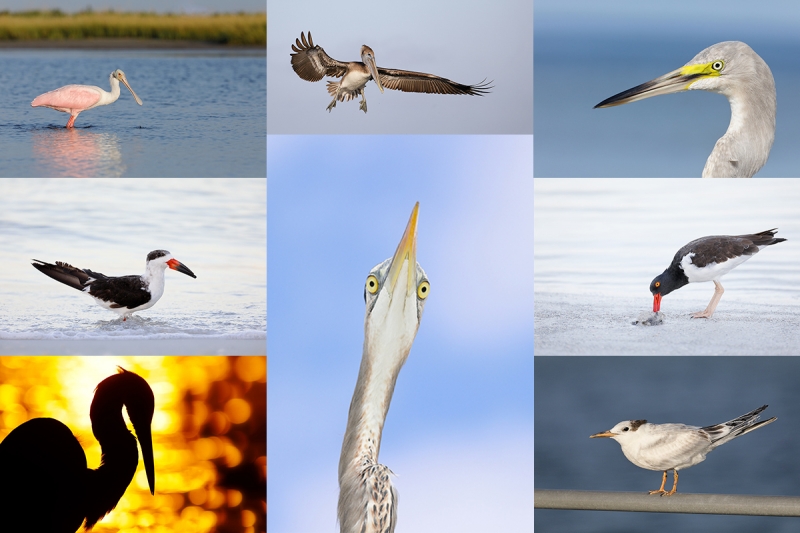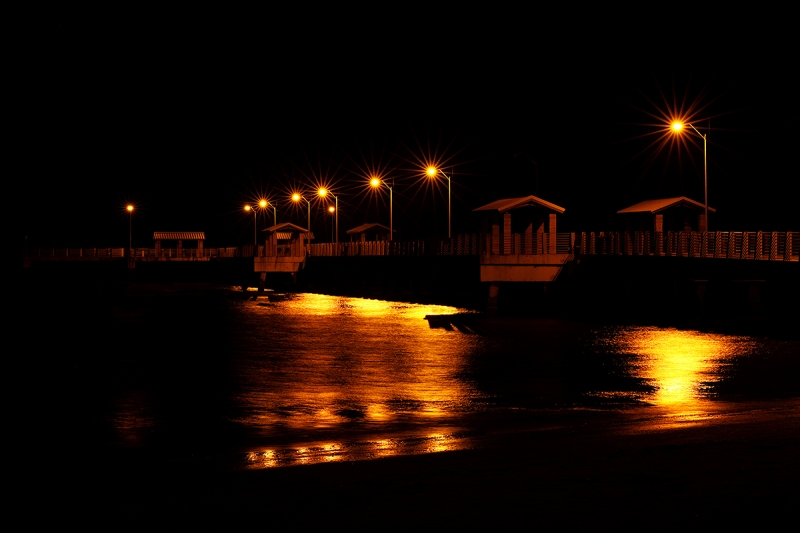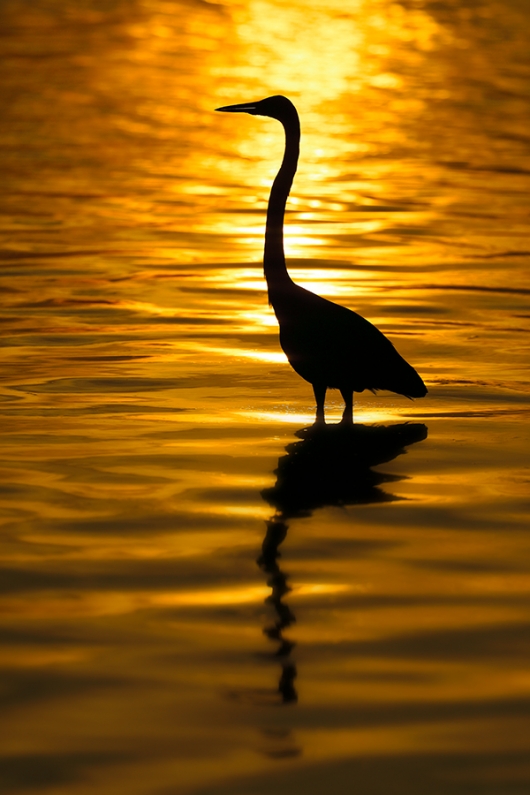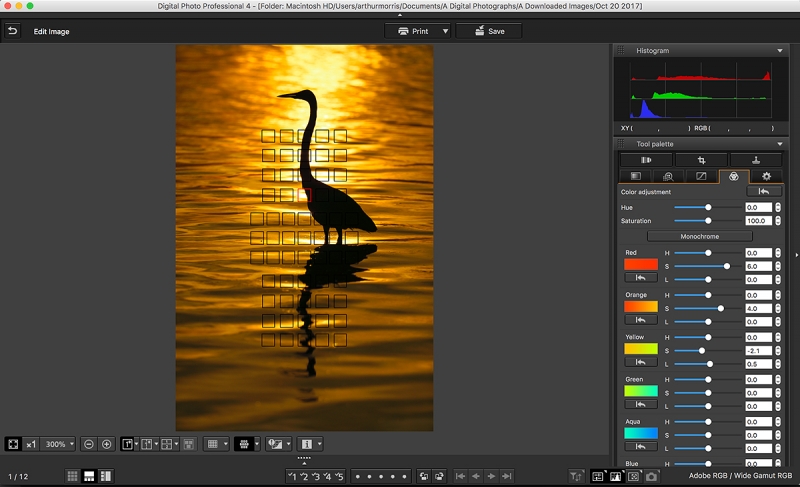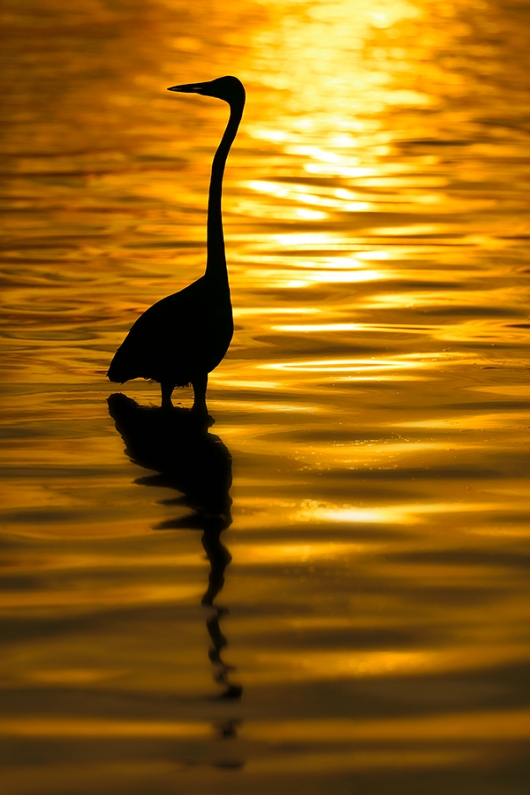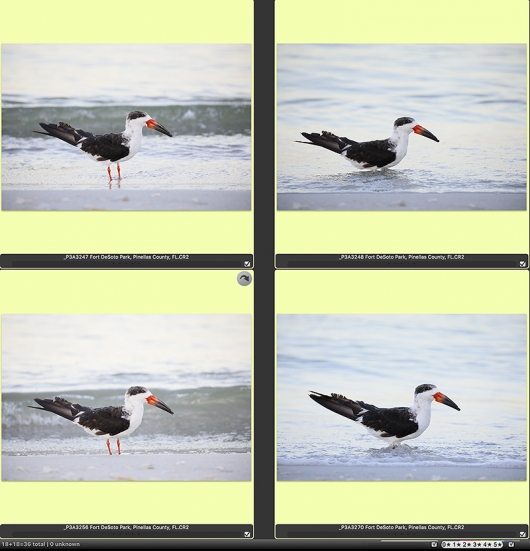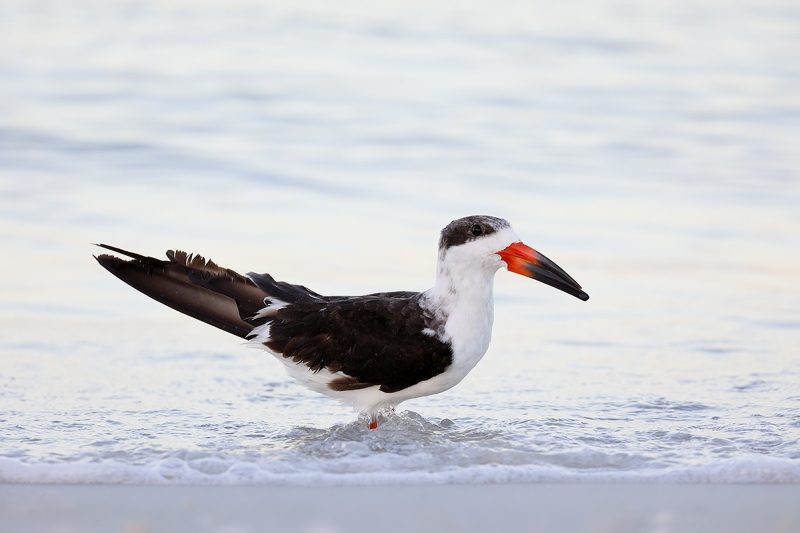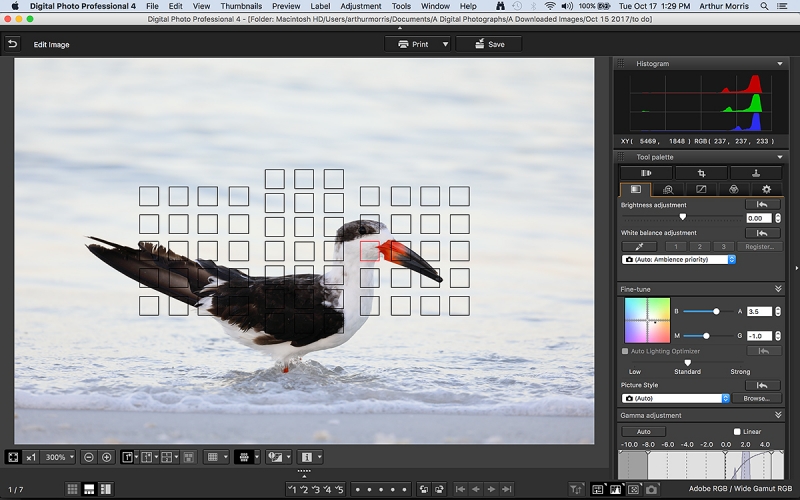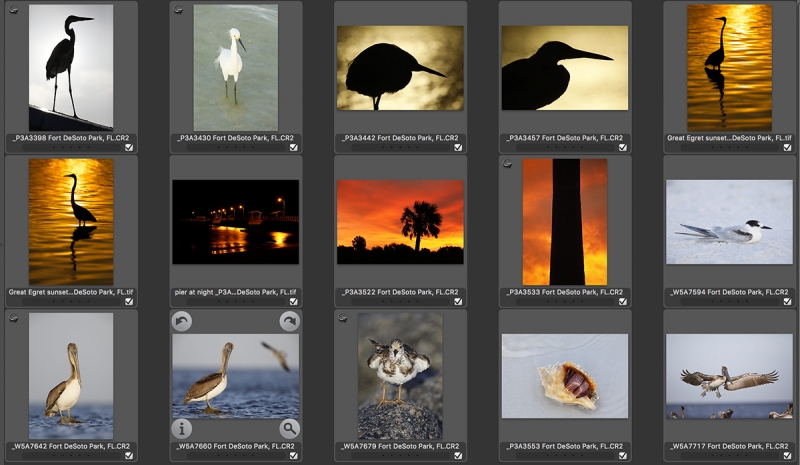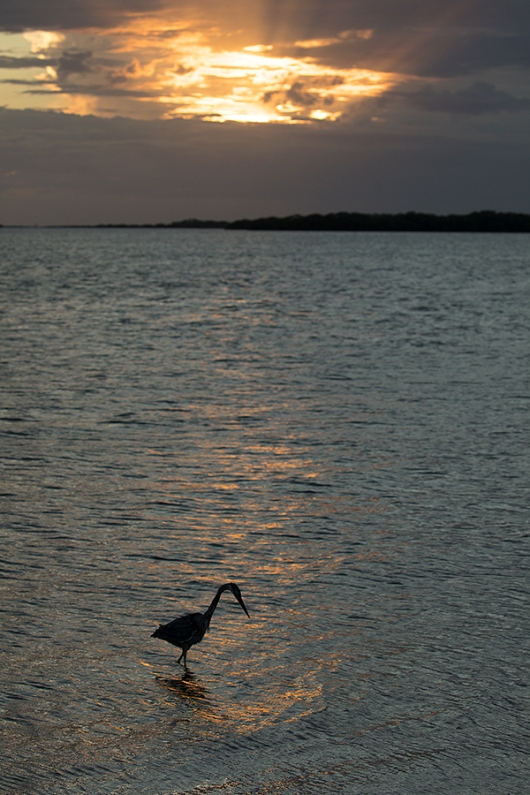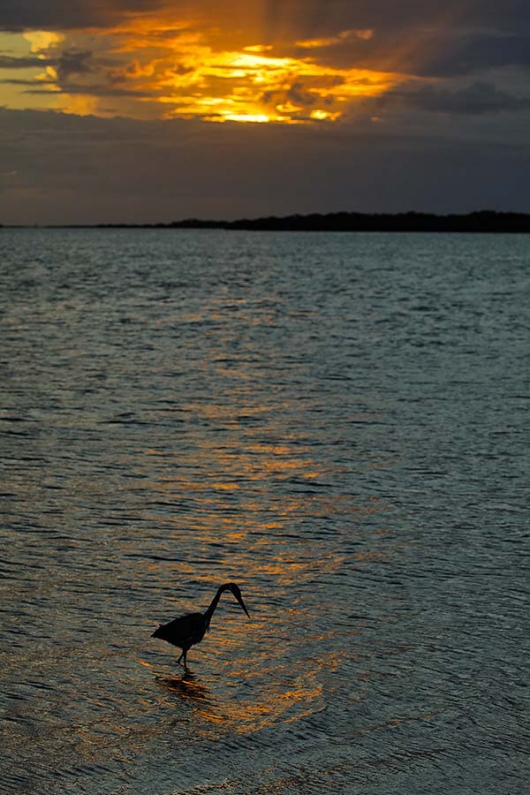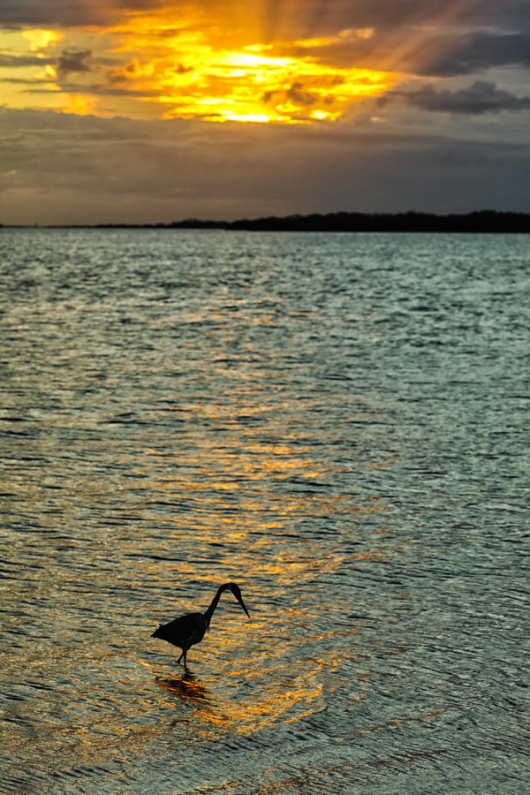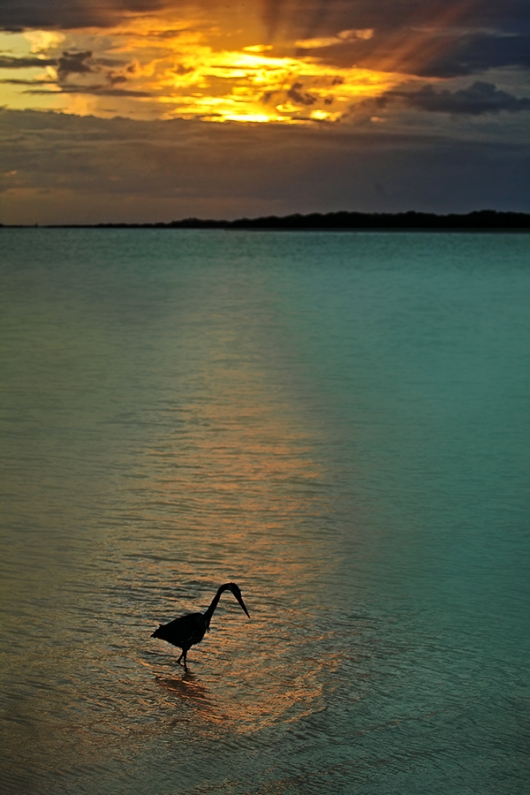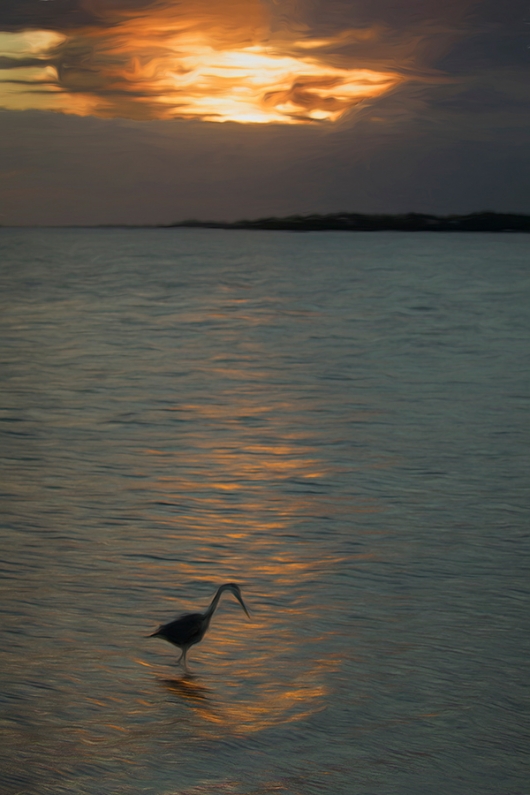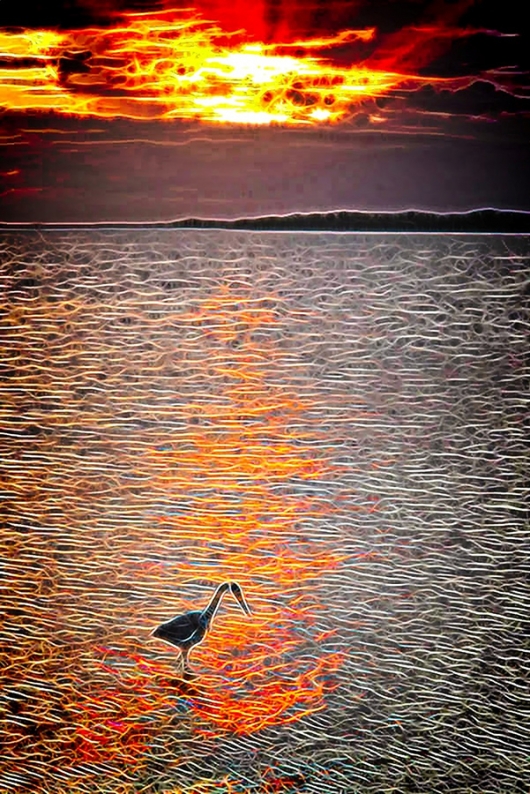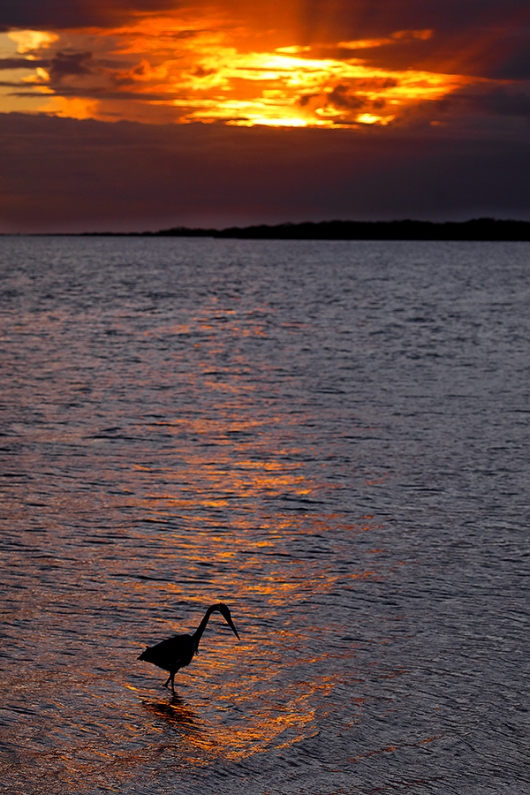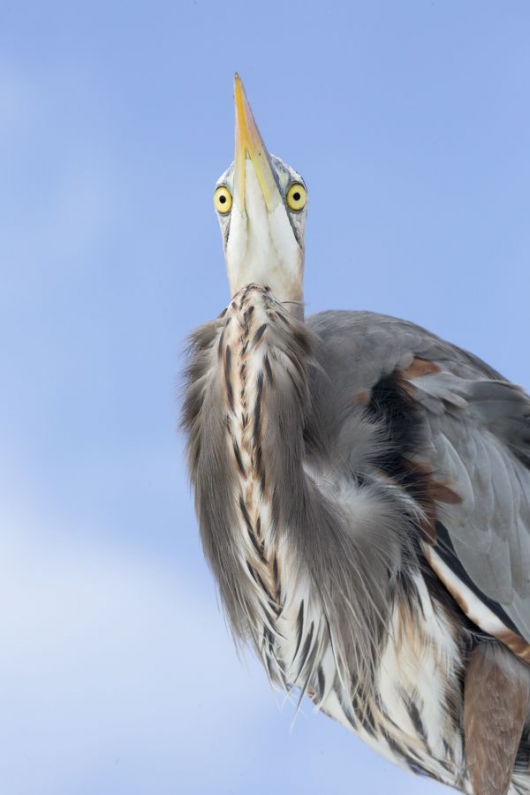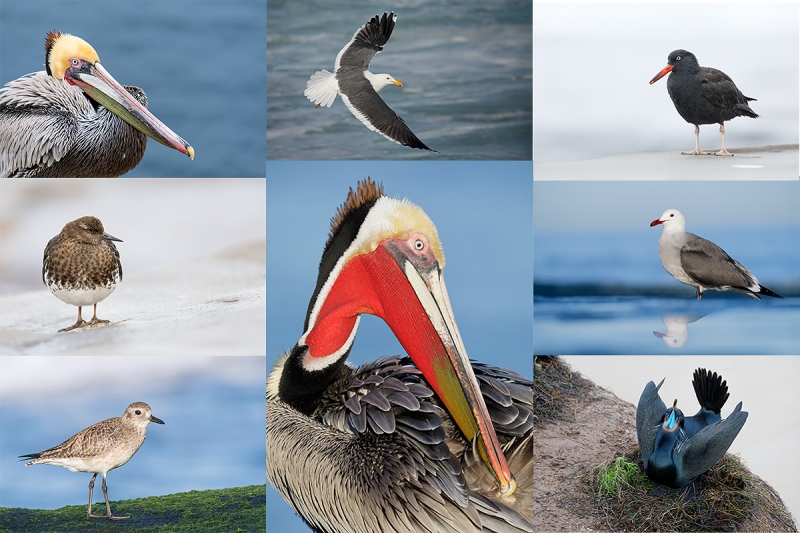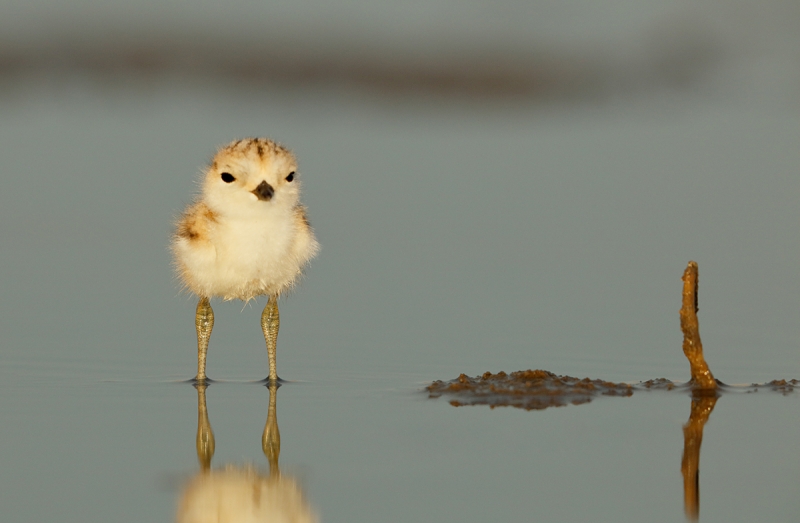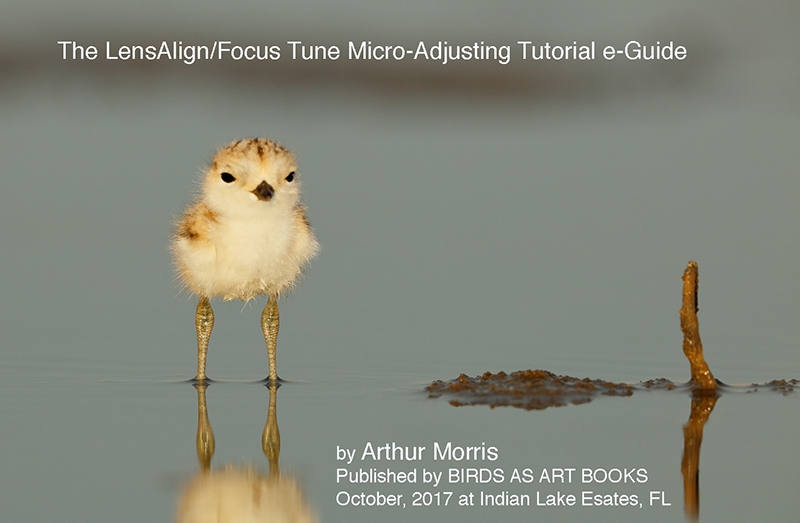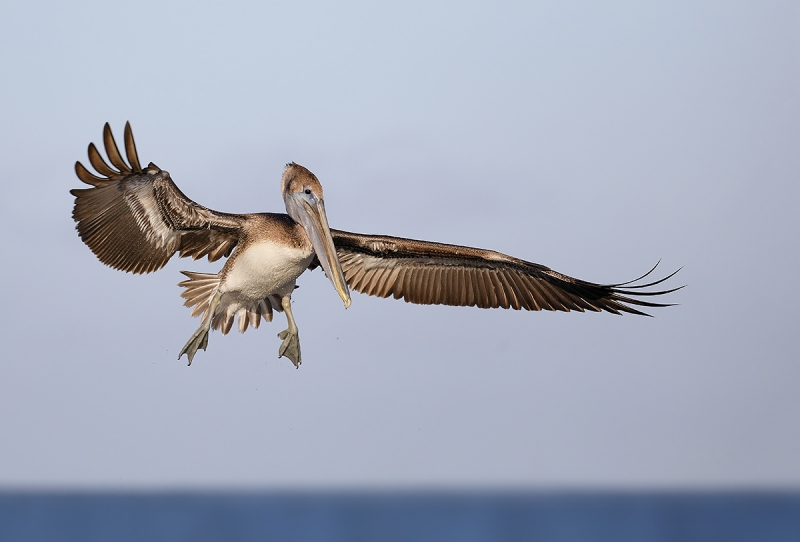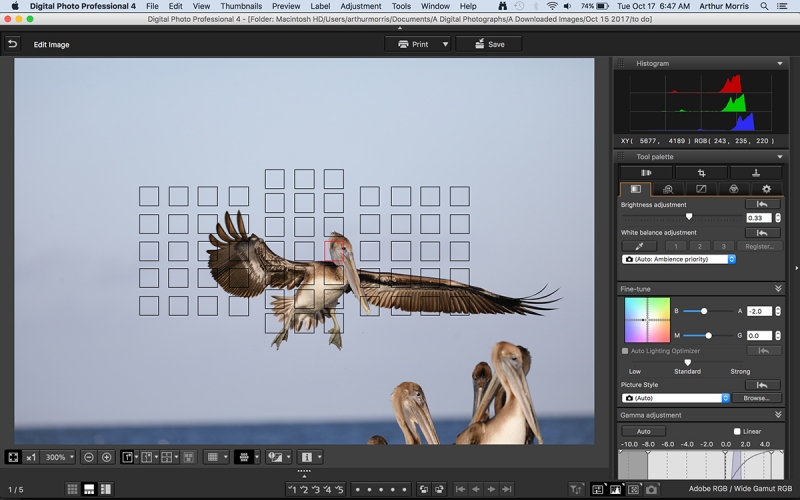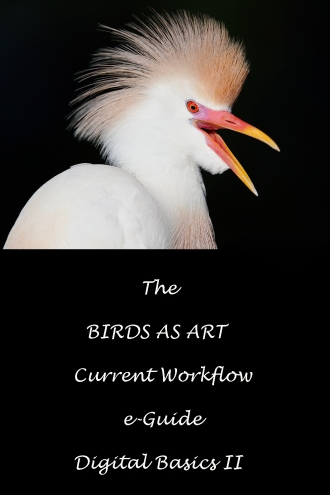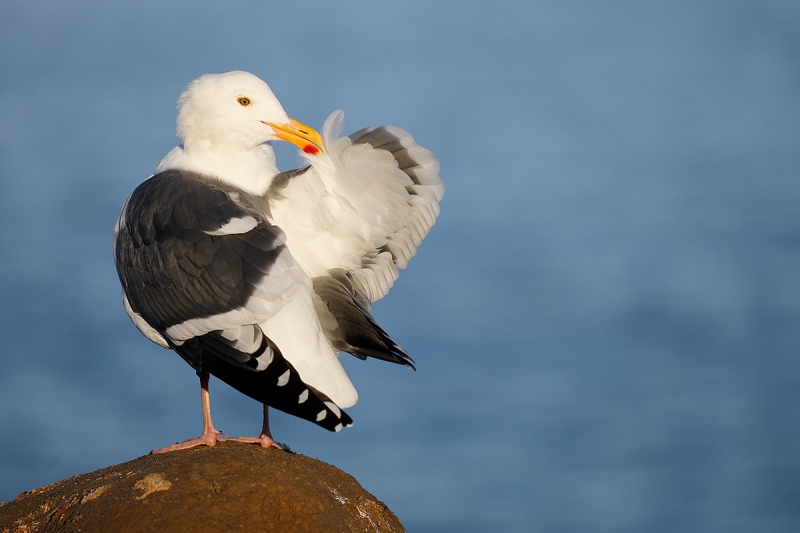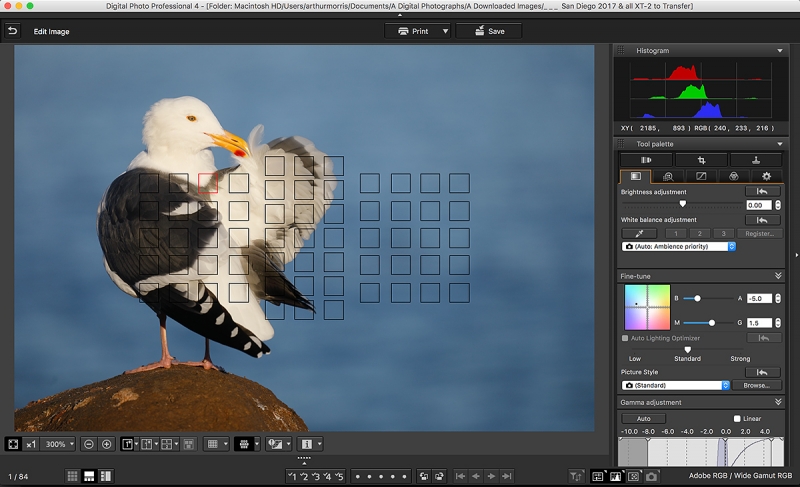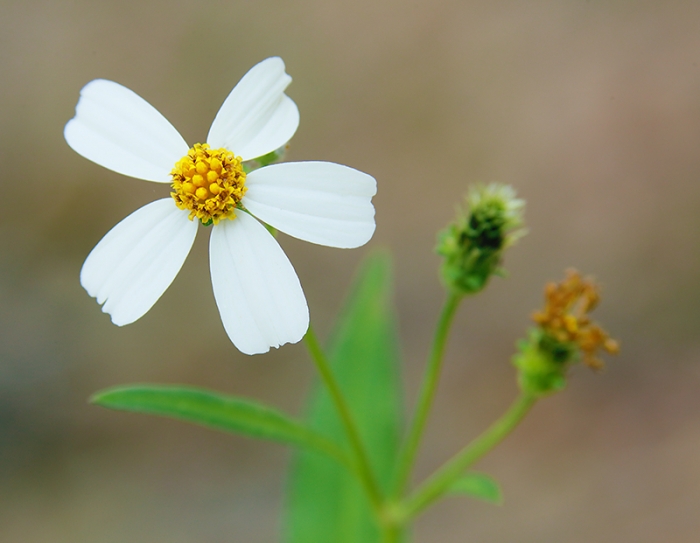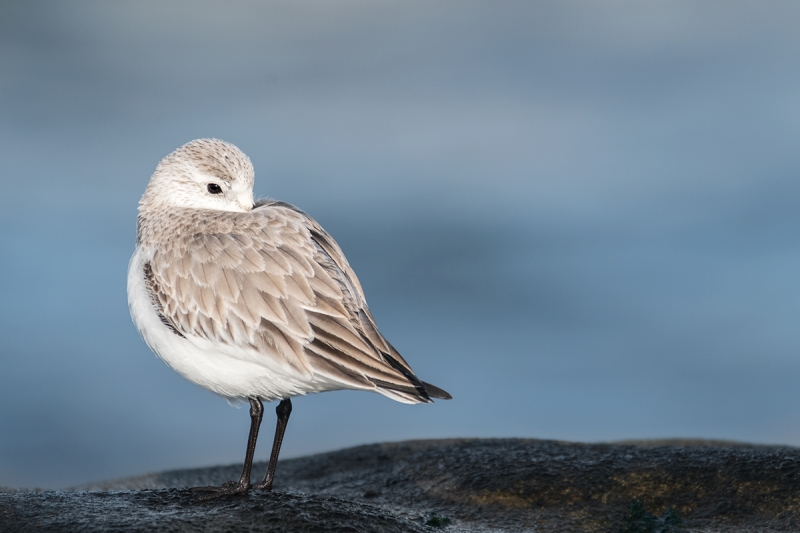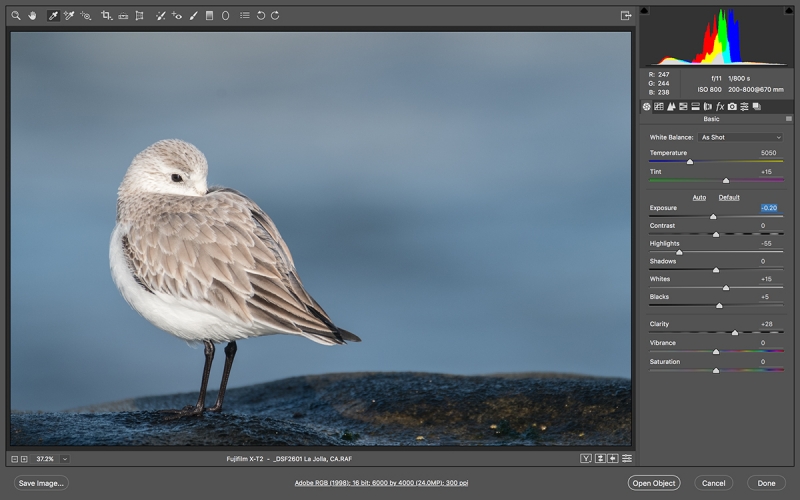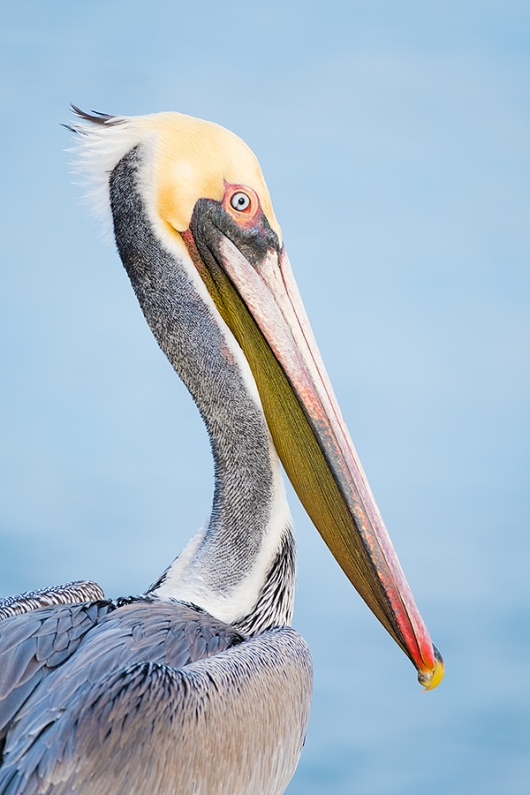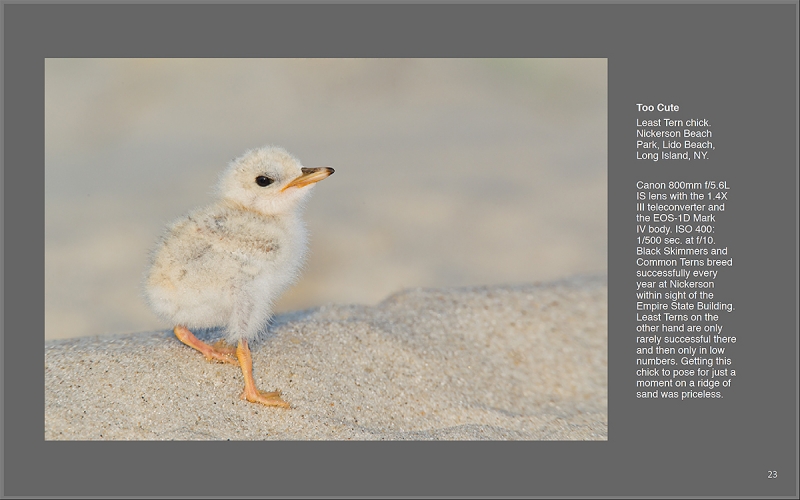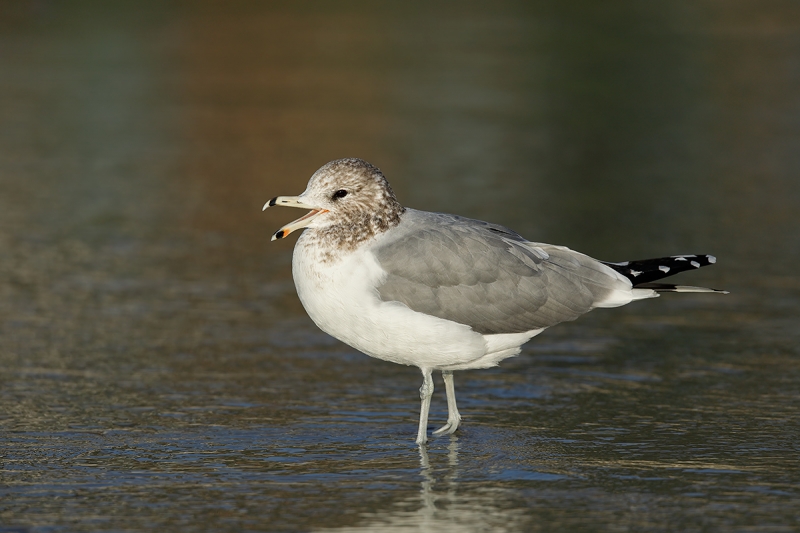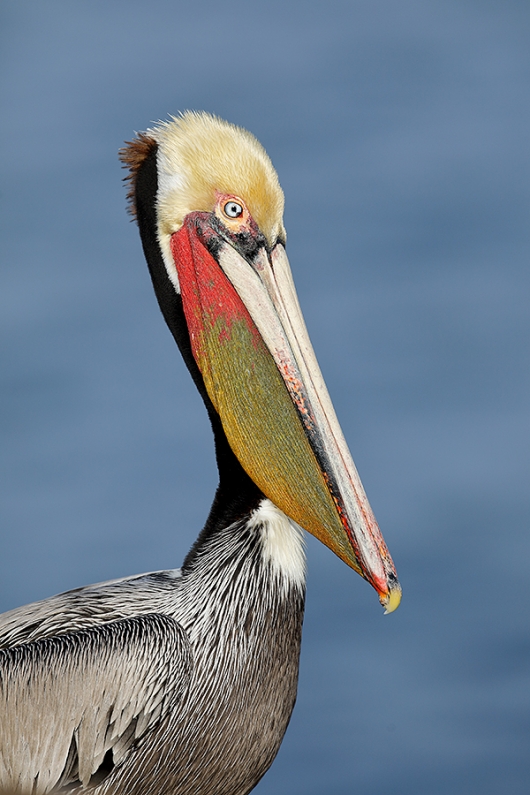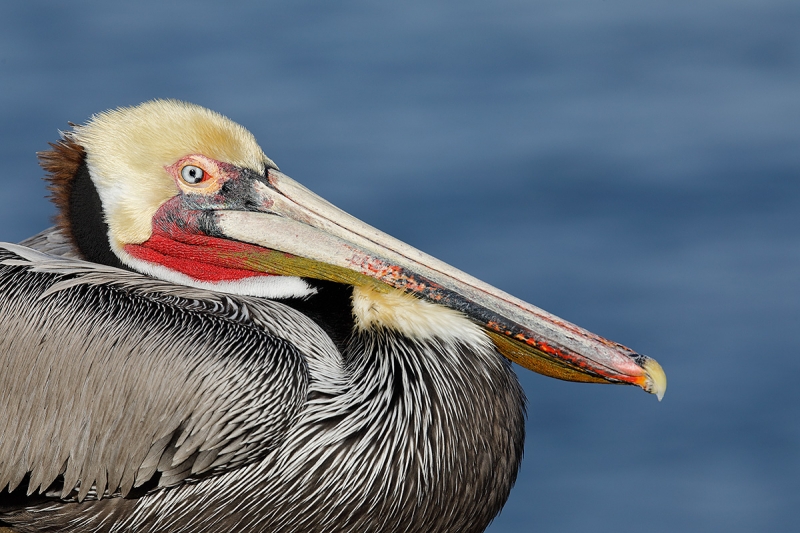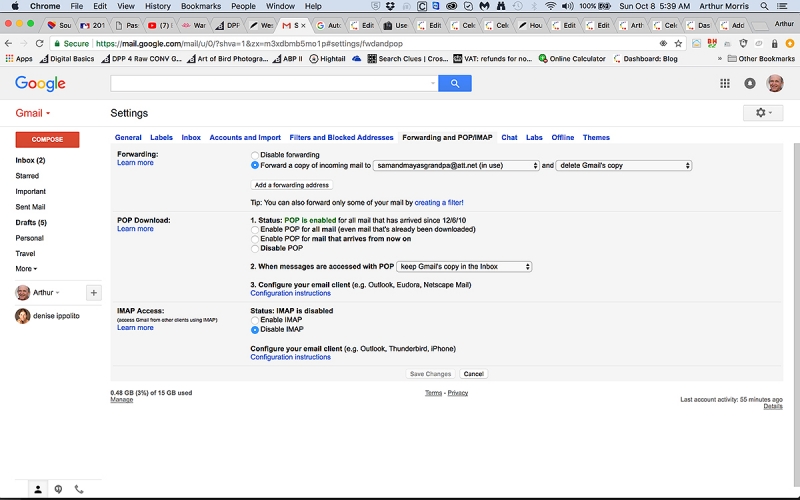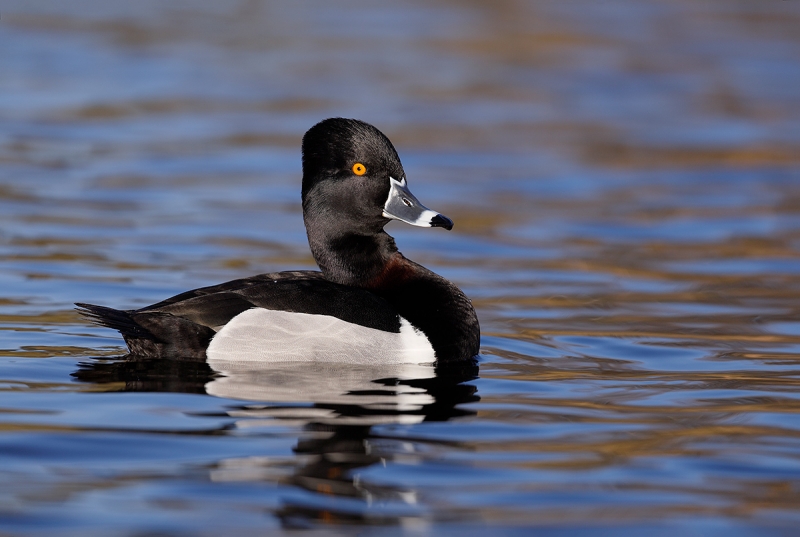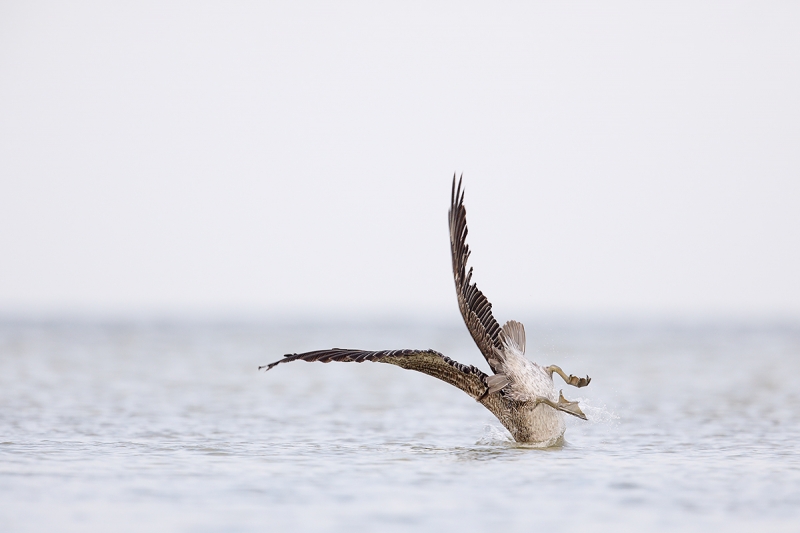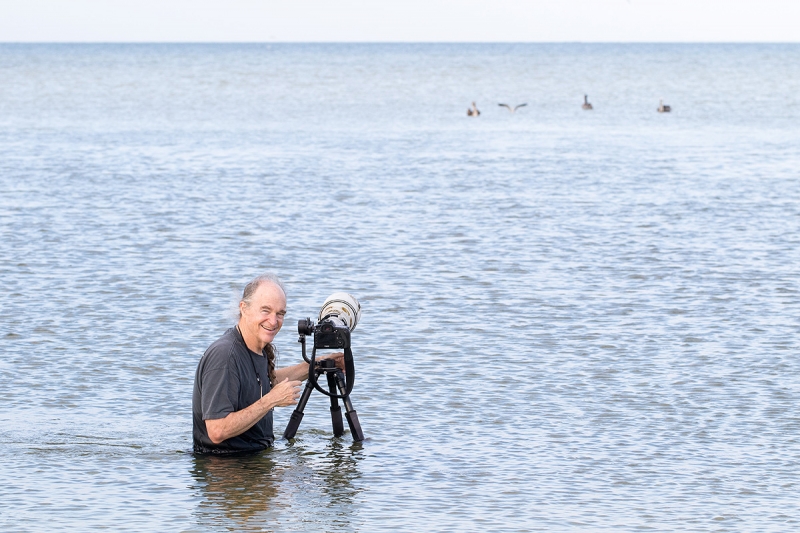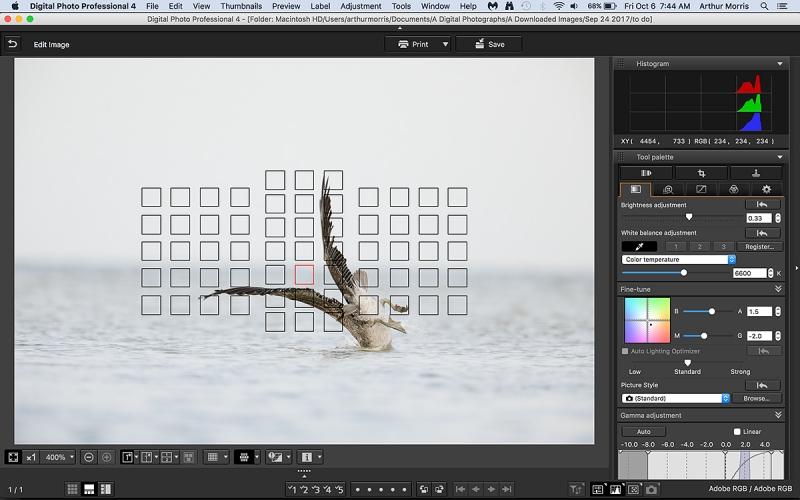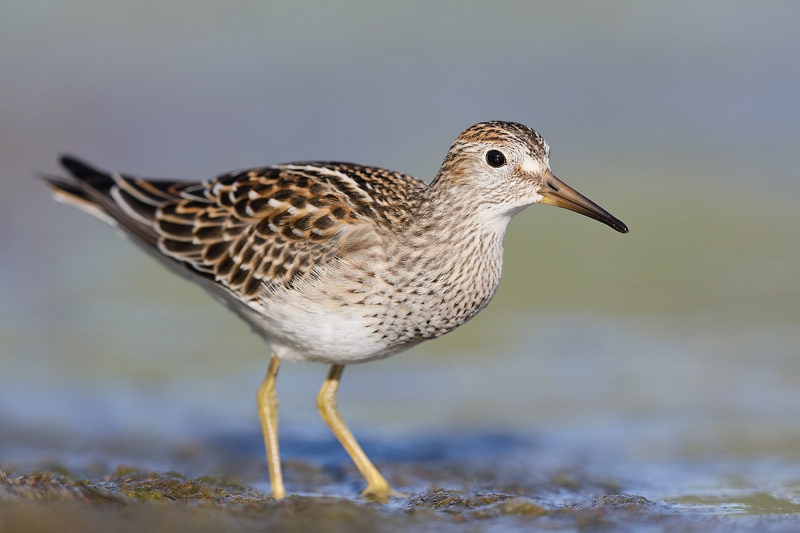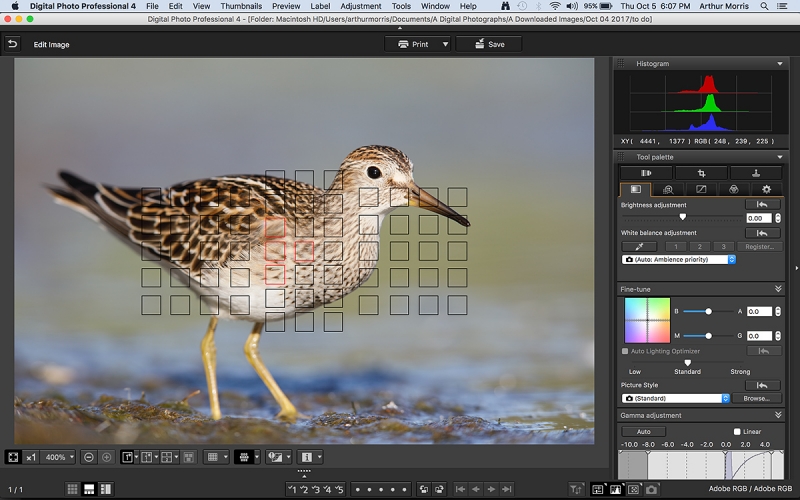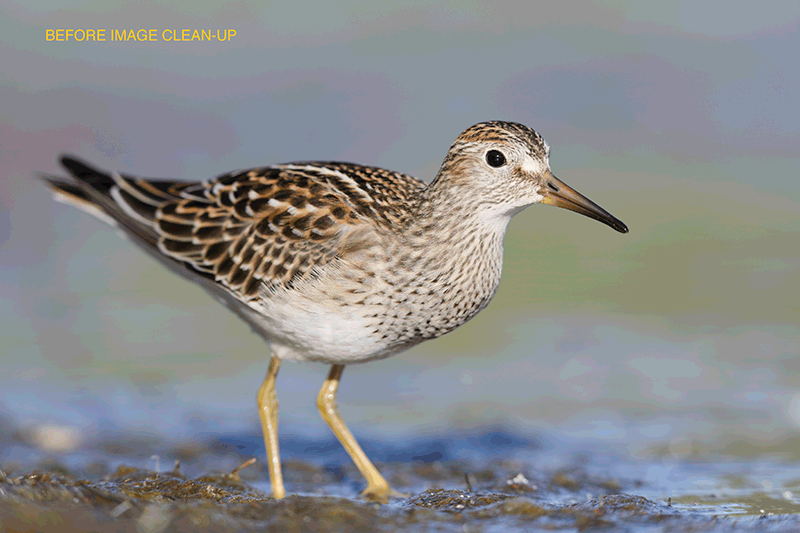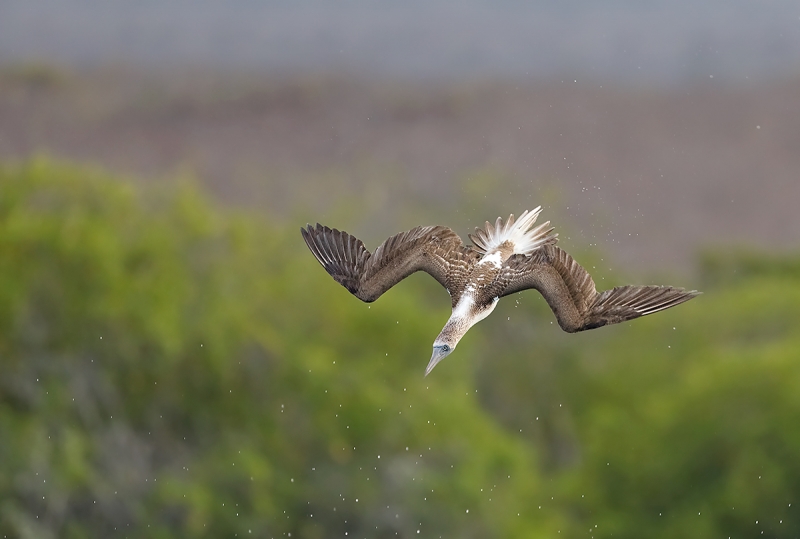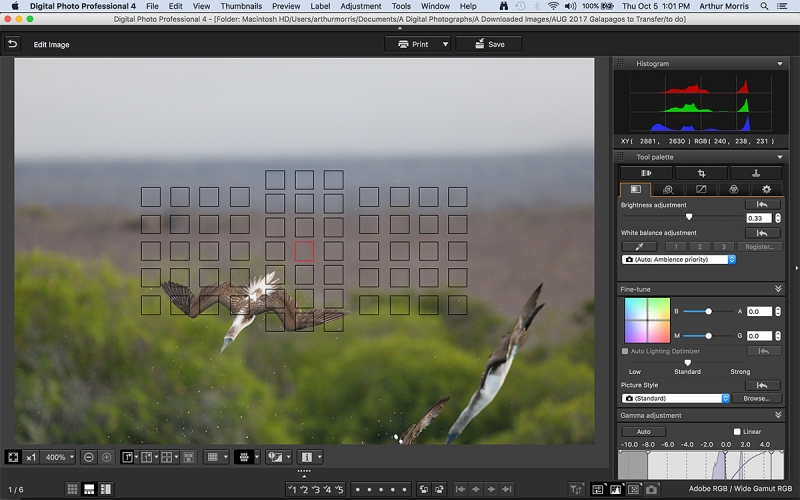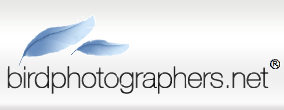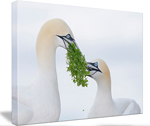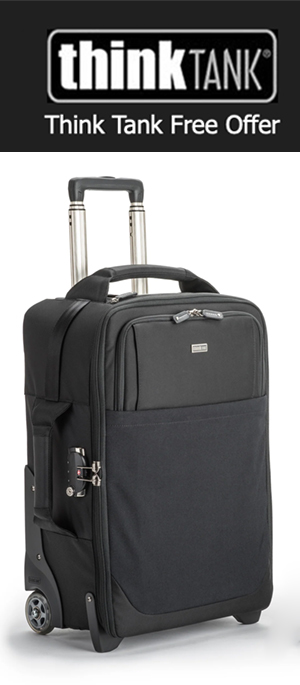October 24th, 2017 Stuff
On Monday I began re-micro-adjusting my 600 II with both my 1.4X III i and my 2X III i teleconverters. I am not sure how but my AFA values disappeared both from my #1 5D Mark IV and from my Excel file 🙂 In addition, I answered lots of e-mails, prepared this blog post, and swam twice totaling one mile.
The LensAlign/FocusTune Micro-Adjusting Tutorial e-Guide
If you missed the announcement of the The LensAlign/FocusTune Micro-Adjusting Tutorial e-Guide, click here.
Below are ome MA/FT e-Guide follow-ups.
Via e-mail from Richard Gollar:
First off I want to say thank you for the great detailed guide you did on Focus Tune. I tried it a year ago when I purchased it and could never get it to work. After going thru you guide and following along carefully it worked perfectly. Before, I didn’t have all the settings in the camera right but after reading your guide and doing it step by step it worked great. To be honest with you Focus Tune should be including this guide away with each sale!
I attached my final adjustment could you look at it and tell me if you think its dialed in close enough. The only thing I really need to get now is the lighting you suggest because outdoors the lighting was variable but it worked with no problem. One important thing I did learn from the guide was that I had been working too close. Now I set everything up, take one shot, load it into Focus Tune, and verify the distance is right before I go through all the steps. FocusTune gave me consistent values every time I ran it. That was great. Before I had been using FoCal and could never get consistent results; they were different each time. Thanks again for the tutorial.I will be recommending LensAlign/FocusTune to my photography friends only if they plan on buying your guide because with out it, I do not think they will be able to figure it out.
Best, Richard
A Note on the MA/FT Lighting
LED Light Panel for Micro-adjusting
I use the Fancierstudio 500 LED light Panel With Dimmer Switch Led Video lighting Led Lite Panel by Fancierstudio VL500 for all of my micro-adjusting. Even when working outdoors. As is stated clearly in the guide, many factors including the quality and strength of the light will affect AFA settings; using this daylight balanced LED light will ensure your getting consistent and accurate results.
The Streak
Today makes eighty-nine days in a row with a new educational blog post! This blog post took less than an hour to prepare. With all of my upcoming free time (or not…), the plan right now is to break the current record streak of exactly four hundred eighty … Good health and good internet connections willing.,
Booking.Com
Booking.Com came through for me twice again recently with both the DeSoto Fall IPT and next July’s UK Puffins, Gannets, and Bempton Pre-trip room reservations. And all the rates were great. If you’d like to give Booking.Com a shot, click here and you will earn a $25 reward. Thanks to the many who have already tried and used this great service.


Gear Questions and Advice
Too many folks attending BAA IPTs and dozens of folks whom I see in the field, and on BPN, are–out of ignorance–using the wrong gear especially when it comes to tripods and more especially, tripod heads… Please know that I am always glad to answer your gear questions via e-mail.
|
|
Very Recent Fort DeSoto Images
From bottom left clockwise back to center: Great Egret, blasting sunrise highlights; Black Skimmer, winter plumage in pre-dawn light; Roseate Spoonbill foraging; Brown Pelican, juvenile landing; hybrid heron X egret; American Oystercatcher feeding; Royal Tern, worn juvenile; Great Blue Heron from below.
|
Cheap Weekend Fort DeSoto In-the-Field Instruction
Saturday, October 28, 2017: Morning session — 6:45am for 3 1/2 hours: $149. Add lunch, image review, and Photoshop session: $249 (total).
Saturday, October 28, 2017: Afternoon session — 4:00pm for 3 1/2 hours: $99.
Saturday October 28, 2017, both sessions including lunch: $329.
Sunday, October 29, 2017: Morning session — 6:45am for 3 1/2 hours: $149.
Learn to see the great situations, get the right exposure every time (even when photographing into the blasting highlights!), to approach free and wild (and often tame!) birds, and to design pleasing images. Learn the location of my new Fort DeSoto hotspot and my favorite sunset spot. To register call Jim or Jen at 863-692-0906.
Canon lens rentals are available on a limited basis. Cheap but great instruction.
|
|
|
This image was created at Fort DeSoto in the pitch dark of early morning on Saturday, October 27 with the Induro GIT304L Grand Series 3 Stealth Carbon Fiber Tripod/Mongoose M3.6-mounted Canon EF 100-400mm f/4.5-5.6L IS II USM lens (at 100mm), and my favorite pier photography camera body, the Canon EOS 5D Mark IV. ISO 400. Evaluative metering ??? 2 1/2 seconds at f/22 in Av mode. WB: 5500.
I used my still flower technique: Live View (for mirror lock) and 2-second timer. Flexi-Sone Single rear focus AF. I selected a point 1/3 of the way out onto the pier. LensAlign/FocusTune micro-adjustment: zero (extrapolated). Please click on the image to see the spectacular larger version.
Pier at night, Fort DeSoto Park, Pinellas County, FL
|
Why Stand Around Doing Nothing When It Is Too Dark To Shoot?
Because the park roads were going to be closed from 7am to 9am (9:30am as it turned out) I arrived at DeSoto way early at about 6:30. Rather than stand around doing nothing I decided to experiment. I began by mounting the lens foot with a Wimberley P-10 plate on it. When I am hand holding I remove it to save a bit of weight. Then I grabbed the tripod and went to work. I started by framing too tight so I zoomed out to 100mm and got more of the near-end of the pier. Then it was a matter of experimenting with both the apertures and the White Balance. When I was going through the images in Photo Mechanic I gasped when this one opened up to full frame. From the color to the blurred waves to the amazing starbursts atop each light pole everything was beyond perfect.
Starburst Aperture Basics
Some lenses, in some lighting conditions, may produce starbursts of pinpoint (or larger as here) light sources if you choose an aperture of f/22 or smaller. I would caution you to beware of diffraction at tiny apertures if I knew what it was and had ever seen it … But alas, I have not.
Exposure Question
What exposure compensation do you think that I set to come up with the perfect exposure?
Technique Question
Why were both Live View and the 2-second timer both unnecessary precautions?
The Image Optimization
After converting the RAW file pretty much straight up in DPP 4 the image optimization too was fairly straightforward. I used the Patch Tool, the Clone Stamp Tool, and some Content Aware Fill to eliminate some specular highlights, some unwanted reflections,n and about a half dozen early-arriving fishermen.
To learn how and why I and other discerning Canon shooters convert nearly all of their Canon digital RAW files in DPP 4 using Canon Digital Photo Professional in the DPP 4 RAW conversion Guide, click here. You can learn everything about my workflow and exactly how I optimize my images in The BIRDS AS ART Current Workflow e-Guide (Digital Basics II), an instructional PDF that is sent via e-mail.
If In Doubt …
If in doubt about using the BAA B&H affiliate link correctly, you can always start your search by clicking here. Please note that the tracking is invisible. Web orders only. Please, however, remember to shoot me your receipt via e-mail.




Please Remember to use my Affiliate Links and to Visit the New BAA Online Store 🙂
To show your appreciation for my continuing efforts here, we ask, as always, that you get in the habit of using my B&H affiliate links on the right side of the blog for all of your photo and electronics purchases. Please check the availability of all photographic accessories in the New BIRDS AS ART Online Store, especially the Mongoose M3.6 tripod head, Wimberley lens plates, Delkin flash cards and accessories, and LensCoat stuff.
As always, we sell only what I have used, have tested, and can depend on. We will not sell you junk. We know what you need to make creating great images easy and fun. And please remember that I am always glad to answer your gear questions via e-mail.
I would of course appreciate your using our B&H affiliate links for all of your major gear, video, and electronic purchases. For the photographic stuff mentioned in the paragraph above, and for everything else in the new store, we, meaning BAA, would of course greatly appreciate your business. Here is a huge thank you to the many who have been using our links on a regular basis and those who will be visiting the New BIRDS AS ART Online Store as well.
Amazon.com
Those who prefer to support BAA by shopping with Amazon may use the logo link above.
Amazon Canada
Many kind folks from north of the border, eh, have e-mailed stating that they would love to help us out by using one of our affiliate links but that living in Canada and doing so presents numerous problems. Now, they can help us out by using our Amazon Canada affiliate link by starting their searches by clicking here.
Facebook
Be sure to like and follow BAA on Facebook by clicking on the logo link upper right. Tanks a stack.
Typos
In all blog posts and Bulletins, feel free to e-mail or to leave a comment regarding any typos or errors. Just be right :).
October 23rd, 2017 Stuff
I enjoyed an excellent cloudy Sunday morning on my my recent Fort DeSoto busman’s holiday, left early, and made it home for all the NFL games and my 48 length swim. Today I will be working on some BPN stuff and getting back to work on the 5D Mark IV User’s Guide. Lots more tomorrow on the The LensAlign/FocusTune Micro-Adjusting Tutorial e-Guide.
For Billy Joel/Beatles Fans
Want goose pimples, and maybe a few tears of joy and happiness? Click here to learn the backstory of Paul McCartney making it to Billy Joel’s Last Play at Shea concert at the last minute.
The Streak
Today makes eighty-eight days in a row with a new educational blog post! This blog post took less than an hour to prepare. With all of my upcoming free time (or not…), the plan right now is to break the current record streak of (I think) four hundred eighty something … Good health and good internet connections willing.,
Booking.Com
Booking.Com came through for me twice again recently with both the DeSoto Fall IPT and next July’s UK Puffins, Gannets, and Bempton Pre-trip room reservations. And all the rates were great. If you’d like to give Booking.Com a shot, click here and you will earn a $25 reward. Thanks to the many who have already tried and used this great service.


Gear Questions and Advice
Too many folks attending BAA IPTs and dozens of folks whom I see in the field, and on BPN, are–out of ignorance–using the wrong gear especially when it comes to tripods and more especially, tripod heads… Please know that I am always glad to answer your gear questions via e-mail.
The LensAlign/FocusTune Micro-Adjusting Tutorial e-Guide
If you missed the announcement of the The LensAlign/FocusTune Micro-Adjusting Tutorial e-Guide, click here.
|
|
Very Recent Fort DeSoto Images
From bottom left clockwise back to center: Great Egret, blasting sunrise highlights; Black Skimmer, winter plumage in pre-dawn light; Roseate Spoonbill foraging; Brown Pelican, juvenile landing; hybrid heron X egret; American Oystercatcher feeding; Royal Tern, worn juvenile; Great Blue Heron from below.
|
Cheap Weekend Fort DeSoto In-the-Field Instruction
Saturday, October 28, 2017: Morning session — 6:45am for 3 1/2 hours: $149. Add lunch, image review, and Photoshop session: $249 (total).
Saturday, October 28, 2017: Afternoon session — 4:00pm for 3 1/2 hours: $99.
Saturday October 28, 2017, both sessions including lunch: $329.
Sunday, October 29, 2017: Morning session — 6:45am for 3 1/2 hours: $149.
Learn to see the great situations, get the right exposure every time (even when photographing into the blasting highlights!), to approach free and wild (and often tame!) birds, and to design pleasing images. Learn the location of my new Fort DeSoto hotspot and my favorite sunset spot. To register call Jim or Jen at 863-692-0906.
Canon lens rentals are available on a limited basis. Cheap but great instruction.
|
|
|
This image was created at Fort DeSoto on the late afternoon of Friday, October 20 with the hand held Canon EF 100-400mm f/4.5-5.6L IS II USM lens, the Canon Extender EF 1.4X III (at 401mm), and my favorite bird photography camera body, the Canon EOS 5D Mark IV. ISO 200. Evaluative metering -3 stops: 1/8000 sec. at f/7.1 in Manual mode. WB: K8000.
LensAlign/FocusTune micro-adjustment: -1.
Upper Large Zone AF/AI Servo/Shutter Button AF was active at the moment of exposure. The system selected a single AF point two rows up from the center AF point that caught the edge of the bird’s upper breast (as originally framed).
Image #1: Great Egret sunset silhouette
|
The Silhouette Situation
As I pulled into my favorite and secret sunset spot at DeSoto I was thrilled to see a Great Egret fishing in the still water in an opening between the mangroves. I drove past the bird, hung a quick U-ie, and re-positioned my SUV. I did an exposure check, went darker, and framed up a lovely image. Just as I went to push the shutter button after acquiring focus, the battery died. All of my spares were in the back of the car so I backed up behind the mangroves to avoid scaring the bird, got a fresh battery, drove back to the opening, and got back to work. After a bit I felt that the bird was tame enough for me to get out of the vehicle and enjoy some additional freedom. I was right. My two favorites, shared with you here today, were made while I was on foot. Note again how effective Upper Large Zone can be for verticals.
|
|
DPP 4 Adjust image colors tab
|
A Rarely Used DPP 4 Tab
It is not often that I open the Adjust image colors tab in DPP 4. The problem was that brightest WHITE highlights in the swath behind the bird’s head and neck were all at 255, 255, 255. This is not a deal breaker in situations like this but I wanted to see if I could tone them down a bit. First I dragged the Color fine tune dot a bit toward BLUE but that did not help much. Nor did moving the Highlight slider to -2. So I tried the rarely used Adjust image colors tab; it took quite a bit of experimenting. The key move was to move the YELLOW saturation slider to -2.1. This really muted the colors. Though I am not sure why, this moved the RED histogram well to the left and away from the highlight axis. Once I did that I was able to boost the saturation in the REDs and ORANGEs and still keep the RED histogram just off of the axis. Success.
I copied the DPP 4 recipe from Image #1, pasted it into Image #2, and executed the second RAW conversion. Learn how and why I and other discerning Canon shooters convert nearly all of their Canon digital RAW files in DPP 4 using Canon Digital Photo Professional in the DPP 4 RAW conversion Guide here
Doing it in ACR
Folks using ACR (either in Photoshop or Lightroom) can make the same adjustments during (best) or after a RAW conversion. Click on the fourth tab from the left to open HSL/greyscale. The layout is a bit different as there are tabs for Hue, Saturation, and Luminance with the sliders for all the colors below.
|
|
|
This image was created at Fort DeSoto on the late afternoon of Friday, October 20 with the hand held Canon EF 100-400mm f/4.5-5.6L IS II USM lens, the Canon Extender EF 1.4X III (at 437mm), and my favorite bird photography camera body, the Canon EOS 5D Mark IV. ISO 200. Evaluative metering -2 1/3 stops: 1/8000 sec. at f/8 in Manual mode. WB: K8000.
LensAlign/FocusTune micro-adjustment: -1.
Upper Large Zone AF/AI Servo/Shutter Button AF was active at the moment of exposure. The system selected a single AF point that was two rows up ad two to the left of the center AF point that was squarely on the bird’s torso (as originally framed).
Image #2: Great Egret sunset silhouette, looking back
|
Both Image Optimizations
With each image, I spent a lot of time cleaning up the crud and specular highlights in the foreground. To cover my tracks, I first applied a 55 pixel Gaussian blur to the whole image and added an Inverse (Black or Hide-all) Layer Mask. Then I painted in the effect (B, D) in the top half of the image with a soft 100% opacity brush. Last I painted in half the effect (B, D) on the bottom half of the image with a soft 50% opacity brush. I did a much better job with the foreground in Image #1 than I did in Image #2. You can learn everything about my workflow and exactly how I optimize my images in The BIRDS AS ART Current Workflow e-Guide (Digital Basics II), an instructional PDF that is sent via e-mail.
The Stronger Image?
Which of today’s two featured images is the strongest? Please let us know why you made your choice. I feel that one of the images is far stronger than the other … Stay tuned.
If In Doubt …
If in doubt about using the BAA B&H affiliate link correctly, you can always start your search by clicking here. Please note that the tracking is invisible. Web orders only. Please, however, remember to shoot me your receipt via e-mail.




Please Remember to use my Affiliate Links and to Visit the New BAA Online Store 🙂
To show your appreciation for my continuing efforts here, we ask, as always, that you get in the habit of using my B&H affiliate links on the right side of the blog for all of your photo and electronics purchases. Please check the availability of all photographic accessories in the New BIRDS AS ART Online Store, especially the Mongoose M3.6 tripod head, Wimberley lens plates, Delkin flash cards and accessories, and LensCoat stuff.
As always, we sell only what I have used, have tested, and can depend on. We will not sell you junk. We know what you need to make creating great images easy and fun. And please remember that I am always glad to answer your gear questions via e-mail.
I would of course appreciate your using our B&H affiliate links for all of your major gear, video, and electronic purchases. For the photographic stuff mentioned in the paragraph above, and for everything else in the new store, we, meaning BAA, would of course greatly appreciate your business. Here is a huge thank you to the many who have been using our links on a regular basis and those who will be visiting the New BIRDS AS ART Online Store as well.
Amazon.com
Those who prefer to support BAA by shopping with Amazon may use the logo link above.
Amazon Canada
Many kind folks from north of the border, eh, have e-mailed stating that they would love to help us out by using one of our affiliate links but that living in Canada and doing so presents numerous problems. Now, they can help us out by using our Amazon Canada affiliate link by starting their searches by clicking here.
Facebook
Be sure to like and follow BAA on Facebook by clicking on the logo link upper right. Tanks a stack.
Typos
In all blog posts and Bulletins, feel free to e-mail or to leave a comment regarding any typos or errors. Just be right :).
October 22nd, 2017 Stuff
Friday afternoon was wind against sun so I went out late and found some excellent backlit and silhouette situations. The east wind persisted on Saturday morning when IPT veteran Winn Krafton joined me in the pre-dawn darkness. After a very nice sunrise we had some good chances with flying pelicans, Common and Sandwich Terns, Snowy Egret, and Ruddy Turnstone. See some of the exciting keepers from those two sessions here.
The Streak
Today makes eighty-seven days in a row with a new educational blog post! This blog post took less than an hour to prepare. With all of my upcoming free time (or not…), the plan right now is to break the current record streak of (I think) four hundred eighty something … Good health and good internet connections willing.
Booking.Com
Booking.Com came through for me twice again recently with both the DeSoto Fall IPT and next July’s UK Puffins, Gannets, and Bempton Pre-trip room reservations. And all the rates were great. If you’d like to give Booking.Com a shot, click here and you will earn a $25 reward. Thanks to the many who have already tried and used this great service.


Gear Questions and Advice
Too many folks attending BAA IPTs and dozens of folks whom I see in the field, and on BPN, are–out of ignorance–using the wrong gear especially when it comes to tripods and more especially, tripod heads… Please know that I am always glad to answer your gear questions via e-mail.
|
|
|
All four of these images were created on the early morning of Sunday, October 15 well before the sun came onto the birds. I used the hand held Canon EF 100-400mm f/4.5-5.6L IS II USM lens (at 400mm) and my favorite skimmer photography camera, the Canon EOS 5D Mark IV. The ISOs ranged from 800 to 1250. All at Evaluative metering +2 stops: 1/320 sec. at f/6.3 (except for the last image at f/7.1) in Tv mode. AWB. ‘s
One AF point to the right of the center AF point/AI Servo/Expand/Shutter Button AF was active at the moment of exposure. The selected AF point fell somewhere on the bird face below the eye in each image. Please click on the image to enlarge it.
FocusTune/LensAlign Micro Adjustment: -5.
Black Skimmer at water’s edge (four ways)
|
Following Up; My Best Skimmer …
In the Black Skimmer Editing Practice blog post here, I posted two items:
Item #1: Black Skimmer Editing Practice
Click on the composite above to view the images larger. Which is the strongest image? Why? Which is the weakest image? Why? What do you think of the two images with the breaking wave included?
For those not blessed with eagle eyes here are the file numbers from left to right, top row first, then the bottom row.
- _P3A3247 (at 7:50am)
- _P3A3248 (five seconds after 3247)
- _P3A3256 (40 seconds after 3248)
- _P3A3270 (4 1/2 minutes after 3256)
My Favorite Skimmer Image
For the most part I do not like breaking waves in images of single birds along the shore. I will admit that 3247 is stronger than 3256, but I kept those two only for educational purposes. That left me with 3248 and 3270 with the latter image being the clear winner. Why? The bird is larger in the frame and super sharp. Ans I like the bubbles left over from a breaking wave near the bird’s feet. You can see my optimized version below.
Item #2: High Level Exposure Question
Considering that the exposure compensation for each image was +2 stops, why is _P3A3270 considerably brighter than _P3A3256? Please note that it has nothing to do with the fact that the light has increased; remember that I was in an automatic exposure mode, Tv …
The Exposure Answer
This was actually a very basic question and I was surprised that nobody came up with the right answer. For 3270, I had gotten closer to the bird and as a result the bird is larger in the frame. With more dark (feathers) in the frame, the meter opened up. Thus the lighter background. This principle goes all the way back to the crude exposure diagrams in the chapter on Exposure in the original The Art of Bird Photography. A second factor might have been that the light have gotten a bit stronger; that possibly brought the following principle into play: in soft light situations the meter begins to get smarter when the light begins to get brighter …
|
|
|
This image was created on the early morning of Sunday, October 15 with the hand held Canon EF 100-400mm f/4.5-5.6L IS II USM lens (at 371mm) and my favorite pelicans in flight photography camera, the Canon EOS 5D Mark IV. ISO 800. Evaluative metering +2 stops: 1/320 sec. at f/6.3 in Tv mode. AWB.
Center AF point/AI Servo/Expand/Shutter Button AF was active at the moment of exposure. As originally framed, the selected AF point fell on the bird’s face just behind and below the eye (as seen in the DPP 4 screen capture below). Please click on the image to enlarge it.
FocusTune/LensAlign Micro Adjustment: -4 (extrapolated).
Black Skimmer, winter adult on the edge of the surf
Be sure to click on the image to see the larger version and the excellent sharpness.
|
My Favorite Optimized
Both Jake Levin and Greg agreed that 3270 was their favorite. Keith Swinndell liked 3247 best because the wave framed rather than cut the top of the bird’s head as it does in 3256.
The only two things of note during the otherwise straightforward image optimization was the RGB Curves Color Balance adjustment that did more to brighten the image than to correct any color casts and a bit of Gaussian Blur to the near shoreline. (I applied it to the whole image on a layer, added and Inverse (Black or Hide-all) Layer Mask, and then painted the effect in as needed. Learn exactly how I optimize my images in The BIRDS AS ART Current Workflow e-Guide (Digital Basics II), an instructional PDF that is sent via e-mail.
|
|
The DPP 4 Screen Capture for today’s featured image
|
The DPP 4 Screen Capture for today’s featured image
Note the perfect placement of the selected AF point. Note the excellent exposure. Note the almost perfect RGB values for the brightest WHITEs: 237, 237, 233. Lastly, note that I moved the Color fine tune dot away from BLUE to reduce the BLUE color cast. Learn how and why I and other discerning Canon shooters convert nearly all of their Canon digital RAW files in DPP 4 using Canon Digital Photo Professional in the DPP 4 RAW conversion Guide here
If In Doubt …
If in doubt about using the BAA B&H affiliate link correctly, you can always start your search by clicking here. Please note that the tracking is invisible. Web orders only. Please, however, remember to shoot me your receipt via e-mail.




Please Remember to use my Affiliate Links and to Visit the New BAA Online Store 🙂
To show your appreciation for my continuing efforts here, we ask, as always, that you get in the habit of using my B&H affiliate links on the right side of the blog for all of your photo and electronics purchases. Please check the availability of all photographic accessories in the New BIRDS AS ART Online Store, especially the Mongoose M3.6 tripod head, Wimberley lens plates, Delkin flash cards and accessories, and LensCoat stuff.
As always, we sell only what I have used, have tested, and can depend on. We will not sell you junk. We know what you need to make creating great images easy and fun. And please remember that I am always glad to answer your gear questions via e-mail.
I would of course appreciate your using our B&H affiliate links for all of your major gear, video, and electronic purchases. For the photographic stuff mentioned in the paragraph above, and for everything else in the new store, we, meaning BAA, would of course greatly appreciate your business. Here is a huge thank you to the many who have been using our links on a regular basis and those who will be visiting the New BIRDS AS ART Online Store as well.
Amazon.com
Those who prefer to support BAA by shopping with Amazon may use the logo link above.
Amazon Canada
Many kind folks from north of the border, eh, have e-mailed stating that they would love to help us out by using one of our affiliate links but that living in Canada and doing so presents numerous problems. Now, they can help us out by using our Amazon Canada affiliate link by starting their searches by clicking here.
Facebook
Be sure to like and follow BAA on Facebook by clicking on the logo link upper right. Tanks a stack.
Typos
In all blog posts and Bulletins, feel free to e-mail or to leave a comment regarding any typos or errors. Just be right :).
October 21st, 2017
|
|
Lousy Afternoon/Not a Bad Morning …
Click to see a larger version.
|
Lousy Afternoon/Not a Bad Morning …
Friday afternoon was pretty bad but I made some magic by knowing where to be when and knowing how to create blasting highlights silhouettes on a bad wind. IPT veteran Winn Krafton joined me early on Saturday morning. We had fun and enjoyed some good opportunities. I is not too late for Saturday afternoon or Sunday morning. Or next weekend.
Cheap Weekend Fort DeSoto In-the-Field Instruction
Saturday, October 21, 2017: Afternoon session — 4:00pm for 3 1/2 hours: $99.
Saturday October 21, 2017, both sessions including lunch: $329.
Sunday, October 22, 2017: Morning session — 6:45am for 3 1/2 hours: $149.
Saturday, October 28, 2017: Morning session — 6:45am for 3 1/2 hours: $149. Add lunch, image review, and Photoshop session: $249 (total).
Saturday, October 28, 2017: Afternoon session — 4:00pm for 3 1/2 hours: $99.
Saturday October 28, 2017, both sessions including lunch: $329.
Sunday, October 29, 2017: Morning session — 6:45am for 3 1/2 hours: $149.
Learn to get the right exposure every time, to approach free and wild (and often tame!) birds, and to design a pleasing image. And learn the location of my new Fort DeSoto hotspot. To register shoot me an e-mail or call or text me at 863-221-2372.
Canon lens rentals are available on a limited basis: 600 II, 500 II, 400 DO II, 200-400 f/4 with Internal TC, and 100-400 II.
Cheap but great instruction.
October 21st, 2017 Stuff
On Friday afternoon I will drive to Brandon to get my almost brand new i-Phone 8+ replaced. I somehow managed to drop it out of my car at 35 mph last week 🙂 I did purchase the Apple Care insurance. Then I continue on to Fort DeSoto for another busman’s holiday, in hopes of running into the mystery heron/egret again.
The Streak
Today makes eighty-six days in a row with a new educational blog post! This blog post took less than an hour to prepare. With all of my upcoming free time (or not…), the plan right now is to break the current record streak of (I think) four hundred eighty something … Good health and good internet connections willing.
Booking.Com
Booking.Com came through for me twice again recently with both the DeSoto Fall IPT and next July’s UK Puffins, Gannets, and Bempton Pre-trip room reservations. And all the rates were great. If you’d like to give Booking.Com a shot, click here and you will earn a $25 reward. Thanks to the many who have already tried and used this great service.


Gear Questions and Advice
Too many folks attending BAA IPTs and dozens of folks whom I see in the field, and on BPN, are–out of ignorance–using the wrong gear especially when it comes to tripods and more especially, tripod heads… Please know that I am always glad to answer your gear questions via e-mail.
|
|
|
This image was created on the late afternoon of Friday, October 13 with the hand held Canon EF 100-400mm f/4.5-5.6L IS II USM lens (at 112mm) and my favorite bird photography camera, the Canon EOS 5D Mark IV. ISO 800. Evaluative metering -2/3 stop: 1/2,000 sec. at f/6.3 in Av mode. AWB.
Center AF point/AI Servo/Expand/Rear Button AF and recompose.
FocusTune/LensAlign Micro Adjustment: -2.
Great Blue Heron sunrise scenic with god-rays.
|
Please Note
Please note that by any standard the colors and contrast in the image above are boring!
The First-Ever RAW File/Image Optimization Challenge
I posted the following in the The First-Ever RAW File/Image Optimization Challenge blog post here:
If you would like to take a crack at this image please click here to download the RAW file. Save the image to your hard drive, convert it in the program of your choice, and then optimize it with the program of your choice. save the TIF. Then create a sharpened 900 pixel tall JPEG and shoot it to me via e-mail.
Assuming that I receive at least a few decent images, I will publish at least the best one here on Friday along with my optimized version.
If at least a few folks give it a try, we can play this game again. If not — well, you can figure it out. Those who try will wind up learning a ton. And who knows, they may create an image that is stronger than mine 🙂
The Reaction
About 20 folks responded by sending their version of the posted image. I responded to each by commenting on their version at times, offering suggestions for improvement. Many folks did a decent job but left to image too dark overall (for reasons noted immediately below). The way to deal with these situations is to do a Curves adjustment that includes pinning the light tones (in this case, the sky), and then pulling the rest of the curve up. Thanks to all who participated. Though it involves a lot of work for me, we will be doing this exercise again.
My Critique
The JPEG above represents the RAW file converted straight up in ACR (with no adjustments). The image overall is way too dark because of the underexposure that was needed to hold back the bright sections of the sky … As both the bird and the god rays are a bit too centered, I wish that I had moved two steps to my right so that the bird would have been closer to the lower left corner and the god rays closer to the upper right corner. I created the image at K-7600 to juice up the colors but the underexposure muted those quite a bit. I converted the image in DPP 4 and optimized it in Photoshop. I will share it with you here in a few days.
|
|
Great Blue Heron sunrise scenic with god-rays.
Conversion and optimization by Nick Clayton.
|
Middle of the Road …
Nick Clayton’s version was well done — he did a nice job of boosting the colors — but is too middle of the road for me. In part, because he failed to deal with the tonality. Again, the way to deal with these situations is to do a Curves adjustment that includes pinning the light tones (in this case, the sky), and then pulling the rest of the curve up.
|
|
Great Blue Heron sunrise scenic with god-rays.
Conversion and optimization by Anthony Ardito.
|
Brighter
Anthony Ardito’s version was a brighter than the boring ACR-converted version that I posted. Please note that I cast no aspersions at ACR — had I wanted to, I could have just as easily boosted the colors and dealt with the tonality in ACR as I did in DPP 4.
|
|
Great Blue Heron sunrise scenic with god-rays.
Conversion and optimization by Jerry Turner.
|
Getting Creative
Jerry Turner opted to soften up the wavelets by applying a fairly strong layer of Surface Blur and then reducing the opacity until a bit of wave detail showed. HIs first version had an unnatural glow around the brighter tones in the water; he eliminated that on his second try. I just noticed that he somehow introduced what looks like a large dust spot in the sky above the trees on the right. I am not a big fan of the CYAN water …
|
|
Great Blue Heron sunrise scenic with god-rays.
Conversion and optimization by Michael Eckstein.
|
More Creativity
Michael Eckstein used Topaz Impressions to come up with his version. I love the effect but he could have done a lot more with the color and contrast.
|
|
Great Blue Heron sunrise scenic with god-rays.
Conversion and optimization by Pat Dunnuck.
|
Over the Top?
Pat Dunnuck used Topaz Studio with a radiance adjustment to come up with her wild version. She sent many versions. Some were too light without much contrast. Though her last version, the one presented here, is way over the top, I do like her creativity. I am pretty sure that there is a less out of the box version that might be more pleasing while still being dramatic.
|
|
Great Blue Heron sunrise scenic with god-rays.
Conversion and optimization by Arthur Morris.
|
artie’s version
Above is my version, converted in DPP 4 and optimized in Photoshop. I will detail the image optimization in a future blog post. How did I move the god rays to the right hand corner of the image?
Comments Welcome
Please feel free to comment on any of all of the images above. What did you like and why? Which is your favorite. Do you have any suggestions for improvement for any of the photos?
If In Doubt …
If in doubt about using the BAA B&H affiliate link correctly, you can always start your search by clicking here. Please note that the tracking is invisible. Web orders only. Please, however, remember to shoot me your receipt via e-mail.




Please Remember to use my Affiliate Links and to Visit the New BAA Online Store 🙂
To show your appreciation for my continuing efforts here, we ask, as always, that you get in the habit of using my B&H affiliate links on the right side of the blog for all of your photo and electronics purchases. Please check the availability of all photographic accessories in the New BIRDS AS ART Online Store, especially the Mongoose M3.6 tripod head, Wimberley lens plates, Delkin flash cards and accessories, and LensCoat stuff.
As always, we sell only what I have used, have tested, and can depend on. We will not sell you junk. We know what you need to make creating great images easy and fun. And please remember that I am always glad to answer your gear questions via e-mail.
I would of course appreciate your using our B&H affiliate links for all of your major gear, video, and electronic purchases. For the photographic stuff mentioned in the paragraph above, and for everything else in the new store, we, meaning BAA, would of course greatly appreciate your business. Here is a huge thank you to the many who have been using our links on a regular basis and those who will be visiting the New BIRDS AS ART Online Store as well.
Amazon.com
Those who prefer to support BAA by shopping with Amazon may use the logo link above.
Amazon Canada
Many kind folks from north of the border, eh, have e-mailed stating that they would love to help us out by using one of our affiliate links but that living in Canada and doing so presents numerous problems. Now, they can help us out by using our Amazon Canada affiliate link by starting their searches by clicking here.
Facebook
Be sure to like and follow BAA on Facebook by clicking on the logo link upper right. Tanks a stack.
Typos
In all blog posts and Bulletins, feel free to e-mail or to leave a comment regarding any typos or errors. Just be right :).
October 20th, 2017 Stuff
Thursday was another mile in the pool and lots of exercise. My plan is to share some of the images that I received as part of the The First-Ever RAW File/Image Optimization Challenge with you here on Saturday. Along with my version. And on Sunday to will chime in on the recent Black Skimmer images from the blog post here. Very few folks participated in that editing exercise but it is not too late for you to go back and take a crack at it.
If you missed the announcement of the The LensAlign/FocusTune Micro-Adjusting Tutorial e-Guide, click here. San Diego IPT #1 is now sold out. See the info on San Diego #2 below.
|
|
Very Recent Fort DeSoto Images
From bottom left clockwise back to center: Great Egret, blasting sunrise highlights; Black Skimmer, winter plumage in pre-dawn light; Roseate Spoonbill foraging; Brown Pelican, juvenile landing; hybrid heron X egret; American Oystercatcher feeding; Royal Tern, worn juvenile; Great Blue Heron from below.
|
Cheap Weekend Fort DeSoto In-the-Field Instruction
Saturday, October 21, 2017: Morning session — 6:45am for 3 1/2 hours: $149. Add lunch, image review, and Photoshop session: $249 (total).
Saturday, October 21, 2017: Afternoon session — 4:00pm for 3 1/2 hours: $99.
Saturday October 21, 2017, both sessions including lunch: $329.
Sunday, October 22, 2017: Morning session — 6:45am for 3 1/2 hours: $149.
Learn to get the right exposure every time, to approach free and wild (and often tame!) birds, and to design a pleasing image. And learn the location of my new Fort DeSoto hotspot. To register on Friday call Jim at 863-692-0906 before noon. After that, shoot me an e-mail or call or text me at 863-221-2372.
Canon lens rentals are available on a limited basis: 600 II, 500 II, 400 DO II, 200-400 f/4 with Internal TC, and 100-400 II.
Cheap but great instruction.
The Streak
Today makes eighty-five days in a row with a new educational blog post! This blog post took more than two hours to prepare. With all of my upcoming free time (or not…), the plan right now is to break the current record streak of (I think) four hundred eighty something … Good health and good internet connections willing.
New Listing
Xtrahand Vest
BAA friend Jim Roetzel is offering an Xtrahand Vest, green — size XL — for $275. The vest is in like-new condition with the thick shoulder pads, two large and two small front pockets, the large rear pocket, the rear tripod pocket, and 2 extra side pockets. Jim is including a slightly used BLUBB along with the vest. Full disclosure: a mouse ate a dime-sized hole in the BLUBB to get at the birdseed inside so you will need some sewing skills or sticky heavy-duty tape to it fully functional. The price includes insured ground shipping via UPS to U.S. addresses only. Check or Paypal OK. If by check, the kit will ship when your check clears. Please contact Jim via e-mail or by phone at 1-330-687-4073 (Eastern time). Photos available upon request.
Price Reduction
Canon 500mm f/4L IS USM Lens
Price Reduced $115 AUD/Australia and New Zealand Sale Only
IPT veteran Barry Barfield from Down Under is offering a used Canon 500mm f/4L IS USM lens (the “old five”) in excellent condition for $4900 AUD ($3825 USD) was $5015 AUD ($4050 USD). The sale includes the lens trunk with keys, the front leather cover, the rear lens cap, a Max 4 LensCoat, a Forest Green Hoodie, and insured ground shipping to Australia and New Zealand. Your item will not ship until your check clears unless other arrangements are made. Photos are available upon request.
Please contact Barry via e-mail or by cell phone at +61.418780575.
The 500 f/4s have been the world’s most popular telephoto lenses for birds, nature, wildlife, and sports for many decades. I owned and used and loved my “old five” for many years. If you live Down Under and don’t have the cash for the 500 II and can handle the additional 1 1/2 pounds (exactly), then this is your next best option. artie
Booking.Com
Booking.Com came through for me twice again recently with both the DeSoto Fall IPT and next July’s UK Puffins, Gannets, and Bempton Pre-trip room reservations. And all the rates were great. If you’d like to give Booking.Com a shot, click here and you will earn a $25 reward. Thanks to the many who have already tried and used this great service.


Gear Questions and Advice
Too many folks attending BAA IPTs and dozens of folks whom I see in the field, and on BPN, are–out of ignorance–using the wrong gear especially when it comes to tripods and more especially, tripod heads… Please know that I am always glad to answer your gear questions via e-mail.
|
|
|
This image was created on the last morning of the 2017 Fort DeSoto Fall IPT by participant Jim Miller with the hand held Canon EF 100-400mm f/4.5-5.6L IS II USM lens (at 400mm) and the EOS 5D Mark II( (now replaced by and my favorite heron eyeball photography camera body, the Canon EOS 5D Mark IV. ISO 400. Evaluative metering +1/3 stop: 1/320 sec. at f/16 in Av mode. Daylight WB.
Great Blue Heron from below
Image courtesy of and copyright 2017: Fall DeSoto IPT participant Jim Miller.
|
A Unique Concept
Here is a unique concept that you can use to learn to create great images:
1-Stay close to the leader.
2-Listen carefully.
3-Follow the simple directions.
4-Ask questions if you get confused.
5-Make lots of great images!
Thanks to Jim for the use of his wonderful image. He stayed close to me for the whole IPT as did most of the group. Most everyone went home with many wonderful images. He made his while standing right next to me as I made the image featured in the Here’s Looking Down at You! And another depth-of-field lesson … blog post here and on the DeSoto composite image card above. You know, come to think of it I just might like Jim’s image better than mine …
|
|
2017 in San Diego was a very good year ….
|
2018 San Diego 3 1/2-DAY BIRDS AS ART IPT #2: Sunday, JAN 28 thru and including a morning session on Wednesday, JAN 31, 2018: 3 1/2 days: $1699.
Limit: 8: Openings: 7
Meet and Greet at 6:30pm on the evening before the IPT begins; Saturday, Jan 27, 2018.
San Diego IPT #2: Shorter and Less Expensive!
Please remember: I go with one.
Join me in San Diego near the end of January to photograph the spectacular breeding plumage Brown Pelicans with their fire-engine red and olive green bill pouches; Brandt’s (usually nesting and displaying) and Double-crested Cormorants; breeding plumage Ring-necked Duck; other duck species possible including Lesser Scaup, Redhead, Wood Duck and Surf Scoter; a variety of gulls including Western, California, and the gorgeous Heerman’s, all in full breeding plumage; shorebirds including Marbled Godwit, Whimbrel, Willet, Sanderling and Black-bellied Plover; many others possible including Least, Western, and Spotted Sandpiper, Black and Ruddy Turnstone, Semipalmated Plover, and Surfbird; Harbor Seal (depending on the current regulations) and California Sea Lion; and Bird of Paradise flowers. And as you can see by studying the two IPT cards there are some nice bird-scape and landscape opportunities as well. Please note: formerly dependable, both Wood Duck and Marbled Godwit have been declining at their usual locations for the past two years …
|
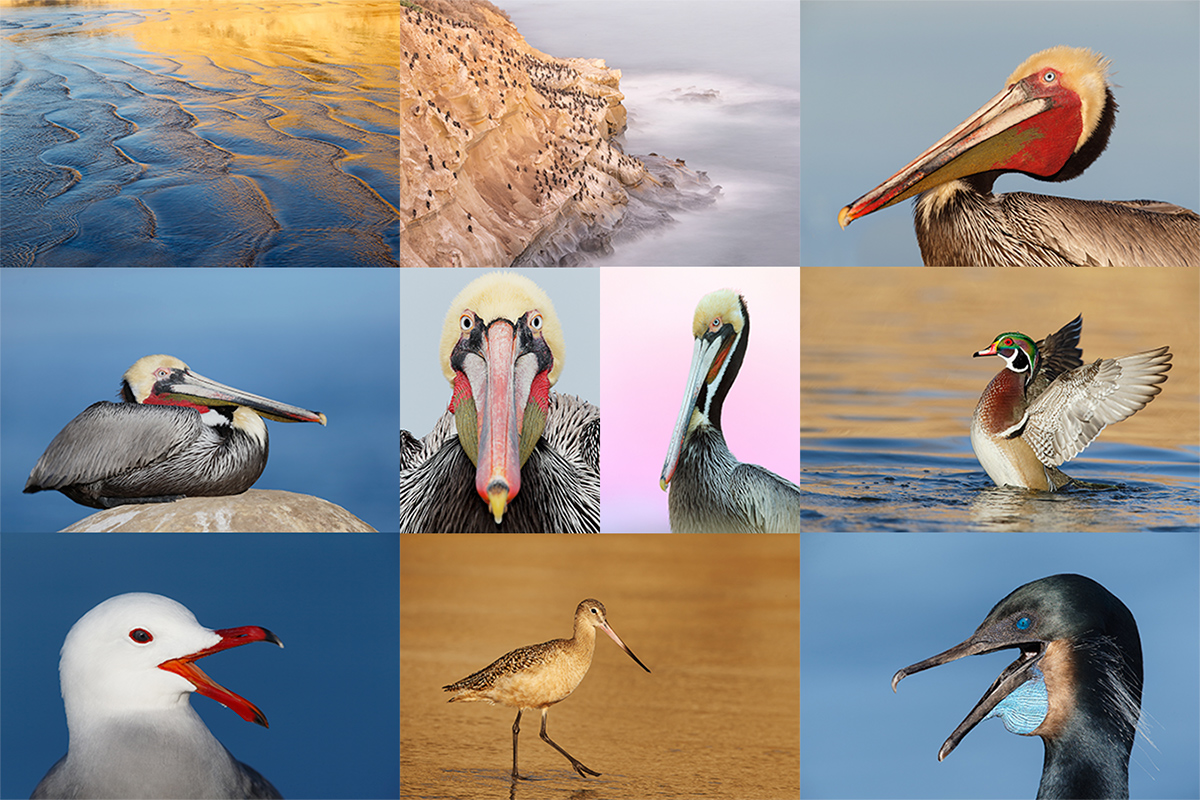
|
|
San Diego offers a wealth of very attractive natural history subjects. With annual visits spanning more than three decades I have lot of experience there….
|
With gorgeous subjects just sitting there waiting to have their pictures taken, photographing the pelicans on the cliffs is about as easy as nature photography gets. With the winds from the east almost every morning there is usually some excellent flight photography. And the pelicans are almost always doing something interesting: preening, scratching, bill pouch cleaning, or squabbling. And then there are those crazy head throws that are thought to be a form of intra-flock communication. You can do most of your photography with an 80- or 100-400 lens …
Did I mention that there are wealth of great birds and natural history subjects in San Diego in winter?
|
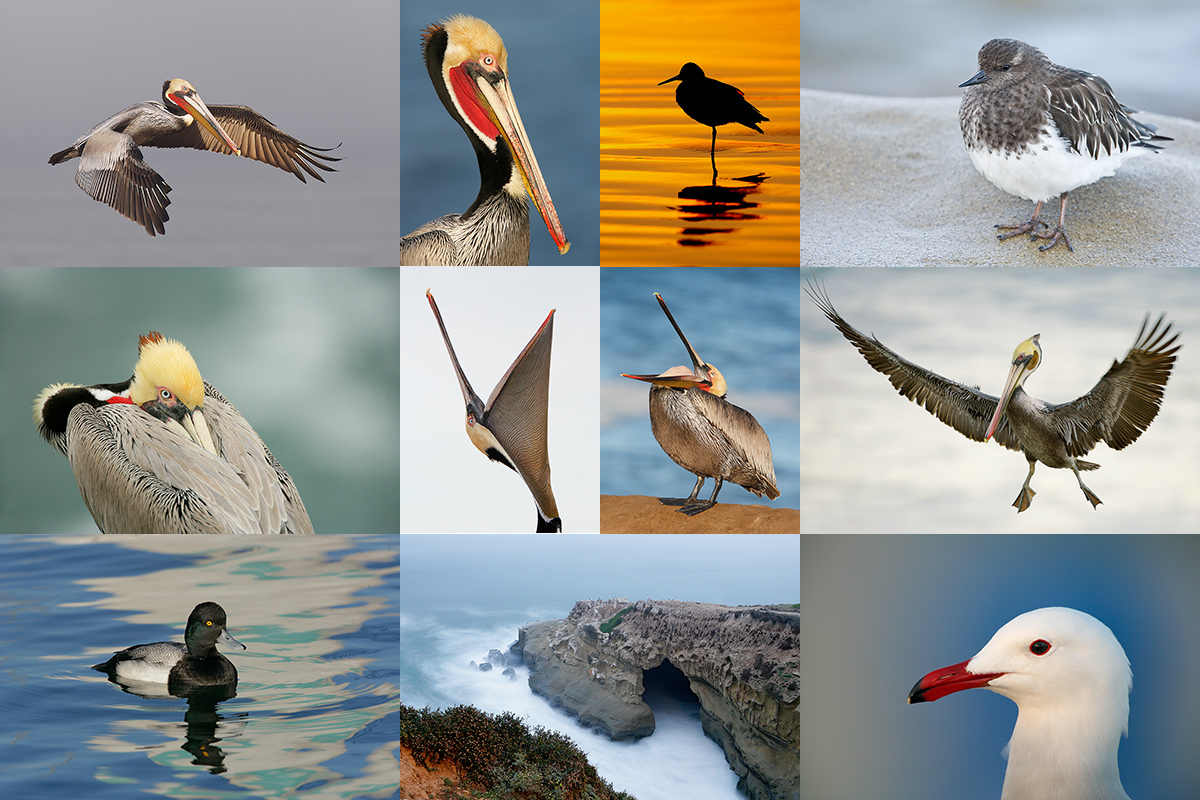
|
|
Though the pelicans will be the stars of the show on this IPT there will be many other handsome and captivating subjects in wonderful settings.
|
The San Diego Details
This IPT will include four 3 1/2 hour morning photo sessions, three 2 1/2 hour afternoon photo sessions, three lunches, and after-lunch image review and Photoshop sessions. To ensure early starts, breakfasts will be your responsibility. Dinners are on your own so that we can get some sleep.
A $599 non-refundable deposit is required to hold your slot for this IPT. You can send a check (made out to “Arthur Morris) to us at BIRDS AS ART, PO Box 7245, Indian Lake Estates, FL, 33855. Or call Jim or Jennifer at the office with a credit card at 863-692-0906. Your balance, payable only by check, will be due on 11/1/2016. If we do not receive your check for the balance on or before the due date we will try to fill your spot from the waiting list. Please print, complete, and sign the form that is linked to here and shoot it to us along with your deposit check. If you register by phone, please print, complete and sign the form as noted above and either mail it to us or e-mail the scan. If you have any questions, please feel free to contact me via e-mail.
If In Doubt …
If in doubt about using the BAA B&H affiliate link correctly, you can always start your search by clicking here. Please note that the tracking is invisible. Web orders only. Please, however, remember to shoot me your receipt via e-mail.




Please Remember to use my Affiliate Links and to Visit the New BAA Online Store 🙂
To show your appreciation for my continuing efforts here, we ask, as always, that you get in the habit of using my B&H affiliate links on the right side of the blog for all of your photo and electronics purchases. Please check the availability of all photographic accessories in the New BIRDS AS ART Online Store, especially the Mongoose M3.6 tripod head, Wimberley lens plates, Delkin flash cards and accessories, and LensCoat stuff.
As always, we sell only what I have used, have tested, and can depend on. We will not sell you junk. We know what you need to make creating great images easy and fun. And please remember that I am always glad to answer your gear questions via e-mail.
I would of course appreciate your using our B&H affiliate links for all of your major gear, video, and electronic purchases. For the photographic stuff mentioned in the paragraph above, and for everything else in the new store, we, meaning BAA, would of course greatly appreciate your business. Here is a huge thank you to the many who have been using our links on a regular basis and those who will be visiting the New BIRDS AS ART Online Store as well.
Amazon.com
Those who prefer to support BAA by shopping with Amazon may use the logo link above.
Amazon Canada
Many kind folks from north of the border, eh, have e-mailed stating that they would love to help us out by using one of our affiliate links but that living in Canada and doing so presents numerous problems. Now, they can help us out by using our Amazon Canada affiliate link by starting their searches by clicking here.
Facebook
Be sure to like and follow BAA on Facebook by clicking on the logo link upper right. Tanks a stack.
Typos
In all blog posts and Bulletins, feel free to e-mail or to leave a comment regarding any typos or errors. Just be right :).
October 19th, 2017 Stuff
With lots of phone and e-mail help from Michael Tapes over the past few days I finally put the finishing touches on the LensAlign/FocusTune Micro-Adjusting Tutorial e-Guide late on Wednesday. Jim got it into the BIRDS AS ART Online Store after dinner. Learn more below.
I was glad to learn that Dave Williams of Santa Barbara, CA signed up for his first IPT: San Diego IPT #1. That trip is now sold out. There is, however, still lots of room on San Diego #2. If you are considering this trip and might be interested in adding on a free day of instruction before the IPT begins please shoot me an e-mail.
I got back in the pool twice on Wednesday: 48 lengths and 40 lengths made an even mile, with lots of exercise during the day as well. It all felt good.
The Streak
Today makes eighty-four days in a row with a new educational blog post! This blog post took more than two hours to prepare. With all of my upcoming free time (or not …), the plan right now is to break the current record streak of (I think) four hundred eighty something … Good health and good internet connections willing.
|
|
2017 in San Diego was a very good year ….
|
2018 San Diego 3 1/2-DAY BIRDS AS ART IPT #2: Sunday, JAN 28 thru and including a morning session on Wednesday, JAN 31, 2018: 3 1/2 days: $1699. Limit: 8: Openings: 7
Meet and Greet at 6:30pm on the evening before the IPT begins; Saturday, Jan 27, 2018.
San Diego IPT #2: Shorter and Less Expensive!
Please remember: I go with one.
Click here for details.
Booking.Com
Booking.Com came through for me twice again recently with both the DeSoto Fall IPT and next July’s UK Puffins, Gannets, and Bempton Pre-trip room reservations. And all the rates were great. If you’d like to give Booking.Com a shot, click here and you will earn a $25 reward. Thanks to the many who have already tried and used this great service.


Gear Questions and Advice
Too many folks attending BAA IPTs and dozens of folks whom I see in the field, and on BPN, are–out of ignorance–using the wrong gear especially when it comes to tripods and more especially, tripod heads… Please know that I am always glad to answer your gear questions via e-mail.
|
|
White-breasted Plover chick, Namibia IPT
|
The Poster Child for the the LensAlign/FocusTune Micro-Adjusting Tutorial e-Guide
I consider the White-fronted Plover chick image above to be the poster child for micro-adjusting; it shows just what can happen when you opt to work with gear that has not been micro-adjusted. I made it to Namibia at great expense both financially and time-wise. This baby plover presented the best avian opportunity of the trip. It was late afternoon and the light was gorgeous. And I got relatively close to this tiny gem of a subject. When I viewed the image on my laptop I quickly realized that sharp focus was on the bird’s legs, not on the eye where I had carefully focused.
In error, I used my back-up 5DS R body with a 2X III TC and the 600 II lens. This combination had not been micro-adjusted. Though the image above might look OK as a small JPEG, it is unusable, i.e., worthless junk: the chick’s eyes are nowhere near sharp. Except as great advertising for this guide. When we got back to the hotel I did a quickie micro-adjustment on this set-up in the hallway of the hotel (near a large window) and obviously without my lighting set-up. The AFA turned out to be -19 … Many times when micro-adjusting you wind up at zero or +1 or -2 and think, “No big deal there.” And you would be correct; tiny AFA values like those will not make a great difference in the final image. But when you wind up at -7 or +11 as frequently happens, the difference in the sharpness of your images can be huge. Not to mention minus 19 … With properly micro-adjusted big lenses folks can begin to routinely create sharp images, even when working with working with 2X teleconverters.
Ordering Info
To purchase the LensAlign/FocusTune package ($124.90) please click here.
Click here to order your copy of the LensAlign/FocusTune Micro-Adjusting Tutorial e-Guide: $50.
The LensAlign/FocusTune Back-story by Michael Tapes (October 2017)
LensAlign was developed as a reliable and repeatable way to test and analyze problems in DSLR autofocus systems, among the bodies, firmware and lenses.
The original LensAlign hardware target was introduced in 2007. It provided a tool that helped photographers to assess the degree of front or back focus with various combinations of their camera bodies and lenses, a problem that was becoming more prevalent. Before then, determining AF accuracy and reliability was hit or miss. The forums were bursting with allegations claiming that photographers did not know how to use their gear, and that front, or back, focus issues were a matter of illusion.
However, with the increases in sensor resolution, and the growing number of photographers shooting DSLR cameras, the complexity and prevalence of AF inaccuracy issues grew.
At the time I invented LensAlign, there was no camera with a user-based provision to adjust for such issues. We needed a reliable tool that could test for, and measure the degree of the AF issues, along with the ability to document them in a repeatable fashion so that the camera makers could acknowledge the problems and fix them. Equally important, when the gear came back from the repair station, the photographers needed a method to verify the repair. In truth, fixes in most cases were not done, or they were inadequate.
Sometime between the LensAlign concept, and the subsequent product release more than a year later, Canon did, in fact, introduce what they called AF Micro-adjustment in the EOS 1D Mark III. I had been in consultation with Canon during my development of LensAlign, but I had no idea if my work influenced the development of this feature or not. However, I was clearly glad they did, since photographers could now “fix” the problem on their own. Of course, this would be a catalyst for LensAlign sales. Although Nikon made no mention of such a feature in their D3 product release, they quickly copied the Canon feature (precisely) and added it to the Nikon D3 calling it AF Fine-Tune. Since that time virtually every mid/high end DSLR camera from all manufacturers have included a provision for AF adjustment, requiring a LensAlign or lesser method to do the actual testing and analysis.
The first LensAlign hardware system (called the Pro Version) sold for $179. It was extremely labor intensive to build and required individual laser calibration (for each unit). I soon discovered that this business model could not be sustained. The price was too high, and the time-and-labor made it impractical to build.
Enter LensAlign MkII, a about 2 years later; it overcame many obstacles:
• It was easier to manufacture (although it required expensive solid steel blanking dies.)
• It could be shipped in a Priority Mail envelope, reducing shipping costs.
• It could be disassembled for travel.
• It was more accurate than the original, and no longer required individual calibration.
• It provided a sensible, and profitable, business model for me and a lower retail price for the end user (then $79.95 and now $84.95)]
With the MkII design established, we concentrated on a companion software solution to couple it with. FocusTune Calibration Software would raise the bar by facilitating the precision (and objectivity) of computer analysis of the test photos, thus eliminating the subjective nature of human analysis. Further, the new software made the AF adjustment task considerably easier and quicker. FocusTune software was designed so that it could be used in conjunction (together with) with any LensAlign hardware (system) or even without LensAlign with a wall mounted target.
Moreover, the FocusTune application actually promoted our development effort that led to additional improvements in both the LensAlign hardware and the FocusTune software! In order for these developments to stretch the envelope of possibilities, we optimized the LensAlign MkII’s Target and Ruler in a series of revisions culminating in the current Generation 4.
The downside was that in order to gain the greatly increased accuracy and speed that the new FocusTune made possible, its utilization necessarily was tied to LensAlign MkII with its new Target and Ruler. This ended FocusTune’s use as a standalone product or its use with older LensAlign designs (the Pro and Lite)
The good news is that we finally have what we wanted were striving for — a unique and phenomenal Hardware + Software solution that aids, enhances, accelerates and improves the task of analyzing and correcting troublesome AF front / back focusing inaccuracies that plague all DSLR cameras. No other commercial system available today is able to explore these issues and offer AF adjustment setting recommendations based on a precision 3-dimensional target that is crucial for accurate calibration. This is what makes the LensAlign/FocusTune system so powerful.
|
|
The LensAlign/Micro-Adjusting Tutorial e-Guide: $50
Don’t need to read the sales pitch? Click here to order your copy.
|
The LensAlign/FocusTune Micro-Adjusting Tutorial e-Guide: $50
For serious photographers using telephoto lenses including the Canon 100-400 II.
Don’t faint. The LensAlign/FocusTune Micro-Adjusting Tutorial e-Guide is finally finished and available for purchase. Before I begin to (briefly) sing its praises — I have to send huge thanks to my brilliant friend Michael Tapes. For the following:
1- Conceiving of, developing, and marketing first the LensAlign hardware and then doing the same with the amazing FocusTune software.
2- Driving down from Orlando to my home at Indian Lake Estates three times over the years to educate me on the use of LensAlign and then finally, FocusTune.
3- Spending many hours on the phone with me over the past few years answering my micro-adjusting questions. And then doing the same thing all over again for the past few months. And the past few days!
4- Skillfully reviewing the final draft of the manuscript and then graciously spending several more hours on the phone with me ironing out the final details.
Thank you Micheal.
Thanks also to dear friend Patrick Sparkman who helped me a lot along the micro-adjusting trail and provided a careful review of the final text.
Note however that any errors in the text are all on me.
The purpose of this guide is to teach you how to use the LensAlign hardware and the FocusTune software to determine an accurate AFA (autofocus adjustment) value for a given gear combination. It is written for users of current Canon camera bodies; folks who use the older Canon bodies and users of Nikon bodies that offer the ability to fine-tune focus will also benefit tremendously.
What can I say about the guide other than “It’s great!” It was about eight months in development. I spent dozens of hours writing it and many hundreds of hours testing and re-testing all of my lenses, teleconverters, and camera bodies, while at the same time fine-tuning the text. I even did some micro-adjusting on IPTs, some of those with the light setup! Most of the many improvements that I made in my techniques over the years were a result of finally listening to and implementing what Michael Tapes had told me in the first place. I can be stubborn, but then again, Michael and I are very much alike in that regard. The problem is that he is smarter than me.
Apologies to the many who were supposed to receive early drafts of this guide but did not. I only sent one to a very few folks as I was never completely comfortable with the contents and the flow and the clarity of the work. I am now. Very much so. I did get a copy to Bill Hill who wrote, “Thanks a ton. As in the past, I rely on you to interpret what the geeks write. Even though the version of the e-guide that you sent was far from complete, I found it much more helpful than anything that I had read online.”
Michael Tapes had this to say about the new guide: “I especially like the second half of the document where you show all of the examples.” He was referring to the many sample graphs in the guide that are accompanied by my illustrative comments:”Here is what I saw. This is what I thought. Here is what I did. And this is why I did it.”
Over the years many have come to value my simple, easy-to-follow instructions, my conversational style, and the clarity of my writing. Many find micro-adjusting to be complicated, time-consuming, and as I did often (and still do on occasion), frustrating. In the new guide, I have worked very hard to take you by the hand and lead through the process step by step. The guide includes camera and lens set-up lists, precise instructions on setting up, positioning, and aiming the gear, and detailed instructions on the testing, the strategies I developed and used, and interpreting the FocusTune graphs (that many find mystifying). Instructions for micro-adjusting zoom lenses at the T (tight or telephoto) end and the W (wide or zoomed out) setting are of course included. Plus dozens of practical tips to make your micro-adjusting experience a lot less frustrating than mine was 🙂
For years many folks have marveled at my ability to create sharp images with Canon 2X teleconverters and long f/4 super-telephoto lenses. Now the secret for much of that success is out of the bag. There is not a single sharp image in the guide; to see those simply surf the blog for the past two years. You will find hundreds of super-sharp images each accompanied by the AFA (autofocus micro-adjustment) that was in play.
Note that micro-adjusting is not for the faint-of-heart. Only serious photographers interested in creating the sharpest possible RAW files with their telephoto lenses (and teleconverters) should apply …
Nuff said.
Ordering Info
To purchase the LensAlign/FocusTune package ($124.90) please click here.
Click here to order your copy of the LensAlign/FocusTune Micro-Adjusting Tutorial e-Guide: $50.
If In Doubt …
If in doubt about using the BAA B&H affiliate link correctly, you can always start your search by clicking here. Please note that the tracking is invisible. Web orders only. Please, however, remember to shoot me your receipt via e-mail.




Please Remember to use my Affiliate Links and to Visit the New BAA Online Store 🙂
To show your appreciation for my continuing efforts here, we ask, as always, that you get in the habit of using my B&H affiliate links on the right side of the blog for all of your photo and electronics purchases. Please check the availability of all photographic accessories in the New BIRDS AS ART Online Store, especially the Mongoose M3.6 tripod head, Wimberley lens plates, Delkin flash cards and accessories, and LensCoat stuff.
As always, we sell only what I have used, have tested, and can depend on. We will not sell you junk. We know what you need to make creating great images easy and fun. And please remember that I am always glad to answer your gear questions via e-mail.
I would of course appreciate your using our B&H affiliate links for all of your major gear, video, and electronic purchases. For the photographic stuff mentioned in the paragraph above, and for everything else in the new store, we, meaning BAA, would of course greatly appreciate your business. Here is a huge thank you to the many who have been using our links on a regular basis and those who will be visiting the New BIRDS AS ART Online Store as well.
Amazon.com
Those who prefer to support BAA by shopping with Amazon may use the logo link above.
Amazon Canada
Many kind folks from north of the border, eh, have e-mailed stating that they would love to help us out by using one of our affiliate links but that living in Canada and doing so presents numerous problems. Now, they can help us out by using our Amazon Canada affiliate link by starting their searches by clicking here.
Facebook
Be sure to like and follow BAA on Facebook by clicking on the logo link upper right. Tanks a stack.
Typos
In all blog posts and Bulletins, feel free to e-mail or to leave a comment regarding any typos or errors. Just be right :).
October 18th, 2017 Stuff
On Monday, before, during, and after our travels, I worked extensively on finishing up the LensAlign/Micro-adjusting e-Guide. I still have a few things to clear up on Tuesday with Michael Tapes and hope to have the guide published by tomorrow, or by Thursday at the latest. No swimming and no exercising till Tuesday.
The LensAlign/FocusTune Micro-adjusting e-Guide will be published and announced tomorrow accompanied by an interesting back-story piece on the development of the hardware, LensAlign, and the software, FoucsTune, by the brilliant Michael Tapes, inventor of both. To purchase the LensAlign Mark II/FocusTune package, click please click here.
I am still looking for a few more folks for San Diego #2. If you are considering this trip and might be interested in adding on a free day of instruction before the IPT begins please shoot me an e-mail.
Great Response
After downloading the RAW file, lots of folks have been sending me JPEgs of their version of Monday’s featured image. If you would like to take a crack at it, see the blog post here. I will publish my version on Friday.
The Streak
Today makes eighty-three days in a row with a new educational blog post! This blog post took more than two hours to prepare. With all of my upcoming free time (or not …), the plan right now is to break the current record streak of (I think) four hundred eighty something … Good health and good internet connections willing.
|
|
2017 in San Diego was a very good year ….
|
2018 San Diego 3 1/2-DAY BIRDS AS ART IPT #2: Sunday, JAN 28 thru and including a morning session on Wednesday, JAN 31, 2018: 3 1/2 days: $1699. Limit: 8: Openings: 7
Meet and Greet at 6:30pm on the evening before the IPT begins; Saturday, Jan 27, 2018.
San Diego IPT #2: Shorter and Less Expensive!
Please remember: I go with one.
Click here for details.
Booking.Com
Booking.Com came through for me twice again recently with both the DeSoto Fall IPT and next July’s UK Puffins, Gannets, and Bempton Pre-trip room reservations. And all the rates were great. If you’d like to give Booking.Com a shot, click here and you will earn a $25 reward. Thanks to the many who have already tried and used this great service.


Gear Questions and Advice
Too many folks attending BAA IPTs and dozens of folks whom I see in the field, and on BPN, are–out of ignorance–using the wrong gear especially when it comes to tripods and more especially, tripod heads… Please know that I am always glad to answer your gear questions via e-mail.
|
|
|
This image was created on the early morning of Sunday, October 15 with the hand held Canon EF 100-400mm f/4.5-5.6L IS II USM lens (at 371mm) and my favorite pelicans in flight photography camera, the Canon EOS 5D Mark IV. ISO 400. Evaluative metering +1 stop off the sky in early morning light: 1/2500 sec. at f/6.3. (Should have been +1 2/3 stops off the sky). AWB.
Center AF point/AI Servo/Expand/Shutter Button AF was active at the moment of exposure. As originally framed, the selected AF point fell on the bird’s face just behind and below the eye (as seen in the DPP 4 screen capture below). Please click on the image to enlarge it.
FocusTune/LensAlign Micro Adjustment: -4 (extrapolated).
Brown Pelican, landing juvenile
|
Brown Pelican landing juvenile
Thanks to a suggestion from DeSoto Fall IPT participant Jim Miller, the group tried a new spot in the park, a spot that I had only rarely (if ever …) been to. It turned out to be fantastic. On my visit last weekend I photographed there on Saturday afternoon and Sunday morning in an effort to learn more about the location. I was successful. On clear mornings with any winds with an easterly component the landing pelican photography will likely turn out to be spectacularly consistent.
Canon EOS 5D Mark IV Cropped Image Quality
Note how well image quality held up to a relatively large crop. AF performs better when you work wider; doing that allows you to aggressively crop a sharp image to your taste. Please understand that I am not advising you to crop away 90% of the pixels in a given image 🙂 With a sharp RAW file you can easily get away with cropping away 30 to 40% of the pixels.
More 100-400 II Versatility
On both Saturday afternoon and Sunday morning past I never took the 500 f/4L IS II out of my Sequoia. What fun it was to walk around with a lightweight lens that is great for flight photography; being able to zoom out on close-flying pelicans and gulls can be a huge plus; with today’s image, I might have zoomed in a bit more … But by zooming out a bit I was able to keep the selected AF point on the bird’s head. Once the sun came over the dunes I added the 1.4X III TC for additional reach while photographing birds on the beach. While I do have some sharp flight images with the 100-400 II/1.4X III combo, my preference is to do flight with the lens alone; AF is faster and more accurate. We have seen this week that the 1-4 can be used at the wide end to create scenic-type images (without having to run back to the car for a shorter lens). It’s focal length range (with or without the Canon Extender EF 1.4X III) is fantastic. And its amazing close focus (down to less than one meter) make this the most versatile lens you will ever own. Lastly, as we saw the other day, you can add a few extension tubes and use the 1-4II to photograph very small flowers.
|
|
The DPP 4 Screen Capture for today’s featured image
|
The DPP 4 Screen Capture for Today’s Featured Image
Note the illuminated red square that shows the placement of the activated AF point at the moment of exposure. See that I added 1/3 stop of light by moving the Brightness slider to +.33. And that I moved the Color fine tune dot a bit towards blue to counteract the rich, red, early morning light just a bit. Note that the BLUE channel dominates the histogram because of the blue sky and the blue water.With the cursor on the brightest WHITEs we do see the early morning light: R = 243, G = 235, B = 220. Again, there is no need to neutralize the WHITEs or to strive for a neutral white balance when working in early morning light …
The Image Optimization
- 1-Convert the RAW file in DPP 4.
- 2-Bring the image into Photoshop.
- 3-Level the image using the Ruler Tool (R) and Image > Rotate > Arbitrary (my keyboard shortcut Command + /).
- 4-Starting in the lower right corner crop the image (C) hard from the left and above using the 2X3 preset flopped to 3X2.
- 5-Select the skinny triangles using the Magic Wand Tool (M).
- 6-Use the minus Lasso Tool (L) to deselect areas of the bird that got picked up ….
- 7-Expand the selection 6 pixels using Select > Modify > Expand.
- 8-Fill in the Canvas with John Haedo Content Aware Fill (Shift + Delete).
- 9-Eliminate the pelicans below the subject using the Patch Tool (my keyboard shortcut P). It is amazing how easy that was and how amazing the Patch Tool is.
- 10-Add some canvas above and in front of the bird and then filling in the new canvas with John Haedo Content Aware Fill (Shift + Delete).
- 11-Lighten the shadowed area of the right underwing primaries using Tim Grey Dodge and Burn; be sure to compare the optimized image with the original …
- 12-Put the whole thing on a new layer and run cheap and dirty NeatImage noise reduction at 80% on the whole image. This completely eliminated the noise in the dark blue water without affecting the sharpness of the subject. To learn everything that there is to know about noise reduction using NeatImage (and lots more!) see the Professional Post Processing Guide by clicking here
- 13-Select the head and bill with the Quick Selection Tool (W), place it on its own layer, and quasi-sharpen it with a Contrast Mask (15/65/0).
- 14-Flatten the image and then duplicate it.
- 15-Apply a 65-pixel Gaussian Blur to the whole thing.
- 16-Add a Regular Layer Mask and erase the blur from the sky and the bird leaving it in place only on the blue water of the Gulf. Be sure to use a large, soft brush for the erasing.
- 17-Name and save the TIFF file.
- 18-Create a 1200 pixel wide JPEG, sharpen it with Unsharp Mask at 90/.3/0.
- 19-Save the JPEG and close the image.
Note: it took longer to type the section above than it did to optimize the image in Photoshop … The latter took less than eight minutes.
|
|
|
The BIRDS AS ART Current Workflow e-Guide (Digital Basics II) will teach you an efficient Mac/Photo Mechanic/Photoshop workflow that will make it easy for you to make your images better in Photoshop (rather than worse). That true whether you convert your images in DPP 4 or ACR. See the blog post here to learn lots more and to read a free excerpt.
You can order your copy from the BAA Online Store here, by sending a Paypal for $40 here, or by calling Jim or Jennifer weekdays at 863-692-0906 with your credit card in hand.
|
The BIRDS AS ART Current Workflow e-Guide (Digital Basics II)
Everything mentioned above is covered in detail in the BIRDS AS ART Current Workflow e-Guide (Digital Basics II), an instructional PDF that is sent via e-mail. Learn more and check out the free excerpt in the blog post here. The new e-Guide reflects my Macbook Pro/Photo Mechanic/DPP 4/Photoshop workflow. Do note that you will find the RGB Curves Adjustment Color Balancing tutorial only in the new e-guide. Note: folks working on a PC and/or those who do not want to miss anything Photoshop may wish to purchase the original Digital Basics along with DB II while saving $15 by clicking here to buy the DB Bundle.
The two most recent and many of the older MP4 Photoshop Tutorial videos releases go hand and hand with the information in DB II):
- The Wingtip Repairs MP4 Video here.
- The MP4 Crow Cleanup Video here.
Folks who learn well by following along rather than by reading can check out the complete collection of MP 4 Photoshop Tutorial Videos by clicking here.
You can learn how and why I and other discerning Canon shooters convert nearly all of their Canon digital RAW files in DPP 4 using Canon Digital Photo Professional in the DPP 4 RAW conversion Guide here. And you can learn advanced Quick Masking and advanced Layer Masking techniques in APTATS I & II. You can save $15 by purchasing the pair. Folks can learn sophisticated sharpening and (NeatImage) Noise Reduction techniques in the The Professional Post Processing Guide by Arash Hazeghi and yours truly.
If In Doubt …
If in doubt about using the BAA B&H affiliate link correctly, you can always start your search by clicking here. Please note that the tracking is invisible. Web orders only. Please, however, remember to shoot me your receipt via e-mail.




Please Remember to use my Affiliate Links and to Visit the New BAA Online Store 🙂
To show your appreciation for my continuing efforts here, we ask, as always, that you get in the habit of using my B&H affiliate links on the right side of the blog for all of your photo and electronics purchases. Please check the availability of all photographic accessories in the New BIRDS AS ART Online Store, especially the Mongoose M3.6 tripod head, Wimberley lens plates, Delkin flash cards and accessories, and LensCoat stuff.
As always, we sell only what I have used, have tested, and can depend on. We will not sell you junk. We know what you need to make creating great images easy and fun. And please remember that I am always glad to answer your gear questions via e-mail.
I would of course appreciate your using our B&H affiliate links for all of your major gear, video, and electronic purchases. For the photographic stuff mentioned in the paragraph above, and for everything else in the new store, we, meaning BAA, would of course greatly appreciate your business. Here is a huge thank you to the many who have been using our links on a regular basis and those who will be visiting the New BIRDS AS ART Online Store as well.
Amazon.com
Those who prefer to support BAA by shopping with Amazon may use the logo link above.
Amazon Canada
Many kind folks from north of the border, eh, have e-mailed stating that they would love to help us out by using one of our affiliate links but that living in Canada and doing so presents numerous problems. Now, they can help us out by using our Amazon Canada affiliate link by starting their searches by clicking here.
Facebook
Be sure to like and follow BAA on Facebook by clicking on the logo link upper right. Tanks a stack.
Typos
In all blog posts and Bulletins, feel free to e-mail or to leave a comment regarding any typos or errors. Just be right :).
October 17th, 2017 Really Important Stuff, All Unsolicited
Via e-mail from Jim Miller
I can’t stop thinking about how much fun the DeSoto Fall IPT was, and how much I learned. There were so many things that suddenly made perfect sense after I had been confused for so long. Thank you very much for the wonderful trip, and for being a great teacher. As I worked through the raw files last week, I realized what a fantastic lens the 600 IS is. Thanks for the rental! Maybe some day I will be able to afford one. Some images for critique are attached.
By the way, the plant we were looking at along the sidewalk in Gulfport is Blue Porterweed. It is worth a few minutes on the internet to read about it: native of Florida and the Caribbean, used for medicine in The Bahamas, etc. We have it in a large pot in the front yard and it takes a lot of water, but it blooms Spring through Fall. Thank you again, Artie. It was really wonderful to be with you and learn from you.
Via e-mail from Lee Sommie
I want to thank you for making the Fall 2017 Ft. DeSoto IPT such a fun and educational experience for me. I truly did not want the adventure to end. I now look through the viewfinder with an artist’s mindset. And the real bonus was making new friends with fellow students. Thank you for sharing your knowledge and enthusiasm for wildlife photography. I had a great time with you and look forward to more adventures on future IPTs.
Followed by this one
BTW. I downloaded Photo Mechanic and started using it in my workflow. Since I like using Lightroom for my adjustments, I found a way to incorporate Photo Mechanic and Lightroom together. Lightroom was driving me crazy with how slow it is to import and preview photos. I was impressed with how fast you could preview photos and start editing your photos on the DeSoto Fall IPT. Life is too short to wait for applications to import and preview photos and Photo Mechanic solves that problem.
Thanks again for everything Artie. Your knowledge keeps on giving well after the IPT!
Via e-mail from Muhammad Arif
I had a great time at Fort De Soto. Thank you for all the instruction, for your help and pointers; my photography has already improved tremendously and I’ve never made such good bird photos before. I wish I could’ve joined you on Monday and Tuesday morning as well but work got in the way. It was also nice to meet everyone on the IPT; sorry that I missed you Ray. Thanks again for everything and I hope to join you at a future IPT sometime again.
Stuff
I visited the Social Security office in Winter Haven to start collecting on my money. I had been drawing my SS on my late-wife Elaine’s money. Next was a visit with my chiropractor friend Dr. Scott Pancake for an Atlas Orthogonal treatment. Too soon to tell but you will hear from me soon. Scott advised two days of rest, i.e., no swimming, no exercises.
I am still looking for a few more folks for San Diego #2. If you are considering this trip and might be interested in adding on a free day of instruction before the IPT begins please shoot me an e-mail.
Great Response
After downloading the RAW file, lots of folks have been sending me JPEgs of their version of yesterday’s featured image. If you would like to take a crack at it, see yesterday’s blog post here. I will publish my version on Friday.
The Streak
Today makes eighty-two days in a row with a new educational blog post! This blog post took less than an hour to prepare. With all of my upcoming free time (or not …), the plan right now is to break the current record streak of (I think) four hundred eighty something … Good health and good internet connections willing.
|
|
2017 in San Diego was a very good year ….
|
2018 San Diego 3 1/2-DAY BIRDS AS ART IPT #2: Sunday, JAN 28 thru and including a morning session on Wednesday, JAN 31, 2018: 3 1/2 days: $1699. Limit: 8: Openings: 7
Meet and Greet at 6:30pm on the evening before the IPT begins; Saturday, Jan 27, 2018.
San Diego IPT #2: Shorter and Less Expensive!
Please remember: I go with one.
Click here for details.
Booking.Com
Booking.Com came through for me twice again recently with both the DeSoto Fall IPT and next July’s UK Puffins, Gannets, and Bempton Pre-trip room reservations. And all the rates were great. If you’d like to give Booking.Com a shot, click here and you will earn a $25 reward. Thanks to the many who have already tried and used this great service.


Gear Questions and Advice
Too many folks attending BAA IPTs and dozens of folks whom I see in the field, and on BPN, are–out of ignorance–using the wrong gear especially when it comes to tripods and more especially, tripod heads… Please know that I am always glad to answer your gear questions via e-mail.
|
|
|
All four of these images were created on the early morning of Sunday, October 15 well before the sun came onto the birds. I used the hand held Canon EF 100-400mm f/4.5-5.6L IS II USM lens (at 400mm) and my favorite skimmer photography camera, the Canon EOS 5D Mark IV. The ISOs ranged from 800 to 1250. All at Evaluative metering +2 stops: 1/320 sec. at f/6.3 (except for the last image at f/7.1) in Tv mode. AWB.
One AF point to the right of the center AF point/AI Servo/Expand/Shutter Button AF was active at the moment of exposure. The selected AF point fell somewhere on the bird face below the eye in each image. Please click on the image to enlarge it.
FocusTune/LensAlign Micro Adjustment: -5.
Black Skimmer at water’s edge (four ways)
|
Black Skimmer Editing Practice
Click on the composite above to view the images larger. Which is the strongest image? Why? Which is the weakest image? Why? What do you think of the two images with the breaking wave included?
For those not blessed with eagle eyes here are the file numbers from left to right, top row first, then the bottom row.
- _P3A3247 (at 7:50am)
- _P3A3248 (five seconds after 3247)
- _P3A3256 (40 seconds after 3248)
- _P3A3270 (4 1/2 minutes after 3256)
Note: I have a 100% best by far choice; I will share it with you here soon.
High Level Exposure Question
Considering that the exposure compensation for each image was +2 stops, why is _P3A3270 considerably brighter than _P3A3256? Please note that it has nothing to do with the fact that the light has increased; remember that I was in an automatic exposure mode, Tv …
More 100-400 II Versatility
On both Saturday afternoon and Sunday morning I never took the 500 f/4L IS II out of my Sequoia. What fun to walk around with a lightweight lens that is great for flight photography; being able to zoom out on close-flying pelicans and gulls can be a huge plus. Once the sun came over the dunes I added the 1.4X III TC for additional reach. We saw yesterday that the 1-4 can be used at the wide end to create scenic-type images (without having to run back to the car for a shorter lens). It’s focal length range (with or without the Canon Extender EF 1.4X III) is fantastic. And its amazing close focus (down to less than one meter) make this the most versatile lens you will ever own. Lastly, as we saw the other day, you can add a few extension tubes and use the 1-4II to photograph very small flowers.
If In Doubt …
If in doubt about using the BAA B&H affiliate link correctly, you can always start your search by clicking here. Please note that the tracking is invisible. Web orders only. Please, however, remember to shoot me your receipt via e-mail.




Please Remember to use my Affiliate Links and to Visit the New BAA Online Store 🙂
To show your appreciation for my continuing efforts here, we ask, as always, that you get in the habit of using my B&H affiliate links on the right side of the blog for all of your photo and electronics purchases. Please check the availability of all photographic accessories in the New BIRDS AS ART Online Store, especially the Mongoose M3.6 tripod head, Wimberley lens plates, Delkin flash cards and accessories, and LensCoat stuff.
As always, we sell only what I have used, have tested, and can depend on. We will not sell you junk. We know what you need to make creating great images easy and fun. And please remember that I am always glad to answer your gear questions via e-mail.
I would of course appreciate your using our B&H affiliate links for all of your major gear, video, and electronic purchases. For the photographic stuff mentioned in the paragraph above, and for everything else in the new store, we, meaning BAA, would of course greatly appreciate your business. Here is a huge thank you to the many who have been using our links on a regular basis and those who will be visiting the New BIRDS AS ART Online Store as well.
Amazon.com
Those who prefer to support BAA by shopping with Amazon may use the logo link above.
Amazon Canada
Many kind folks from north of the border, eh, have e-mailed stating that they would love to help us out by using one of our affiliate links but that living in Canada and doing so presents numerous problems. Now, they can help us out by using our Amazon Canada affiliate link by starting their searches by clicking here.
Facebook
Be sure to like and follow BAA on Facebook by clicking on the logo link upper right. Tanks a stack.
Typos
In all blog posts and Bulletins, feel free to e-mail or to leave a comment regarding any typos or errors. Just be right :).
October 16th, 2017 Stuff
I did enjoy a morning swim on Saturday and then made it over to DeSoto for the afternoon. I searched for the mystery heron/egret but did not find it. With a strong east wind and mostly clear skies, conditions were tough for bird photography; can you say “wind against sun?” But I really do love Desoto. And I did get to photograph a pretty neat rainbow. I ended the day at my favorite secret sunset spot and found a cooperative juvie Great Blue Heron. You can learn about my secret sunset spot in the DeSoto Site Guide. Scroll down for more info on the guide. I did stay over and photograph on Sunday morning. More on that session soon.
I am still looking for a few more folks for San Diego #2. If you are considering this trip and might be interested in adding on a free day of instruction before the IPT begins please shoot me an e-mail.
The Streak
Today makes eighty-one days in a row with a new educational blog post! This blog post took less than an hour to prepare. With all of my upcoming free time (or not …), the plan right now is to break the current record streak of (I think) four hundred eighty something … Good health and good internet connections willing.
Fort DeSoto Site Guide
Fort DeSoto is about the only bird photography hotspot that I know of that has the potential to offer great opportunities every day of the year. The big attractions are shorebirds, all the large wading birds (including Wood Stork and Roseate Spoonbill at various seasons), and many species of terns and gulls. In the spring you can usually photograph the breeding behaviors of Royal & Sandwich Terns and Laughing Gull. Flight photography can be great when a feeding spree occurs just off of the beach. These feature terns and gulls and Brown Pelican. Spring and fall migration can be excellent for all manner of warblers, vireos, gnatcatchers, tanagers, grosbeaks, and orioles in some of the wooded areas. By purchasing the guide you will know exactly where to be on what tide and what wind. Why waste your time searching for the birds when you can just show up and act like a DeSoto veteran?
Get yourself a copy of the Fort DeSoto Site Guide. Learn the best spots, where to be when in what season in what weather. Learn the best wind directions for the various locations. BAA Site Guides are the next best thing to being on an IPT. You can see all of them here.
|
|
2017 in San Diego was a very good year ….
|
2018 San Diego 3 1/2-DAY BIRDS AS ART IPT #2: Sunday, JAN 28 thru and including a morning session on Wednesday, JAN 31, 2018: 3 1/2 days: $1699. Limit: 8: Openings: 7
Meet and Greet at 6:30pm on the evening before the IPT begins; Saturday, Jan 27, 2018.
San Diego IPT #2: Shorter and Less Expensive!
Please remember: I go with one.
Click here for details.
Booking.Com
Booking.Com came through for me twice again recently with both the DeSoto Fall IPT and next July’s UK Puffins, Gannets, and Bempton Pre-trip room reservations. And all the rates were great. If you’d like to give Booking.Com a shot, click here and you will earn a $25 reward. Thanks to the many who have already tried and used this great service.


Gear Questions and Advice
Too many folks attending BAA IPTs and dozens of folks whom I see in the field, and on BPN, are–out of ignorance–using the wrong gear especially when it comes to tripods and more especially, tripod heads… Please know that I am always glad to answer your gear questions via e-mail.
|
|
|
This image was created on the late afternoon of Friday, October 13 with the hand held Canon EF 100-400mm f/4.5-5.6L IS II USM lens (at 112mm) and my favorite bird photography camera, the Canon EOS 5D Mark IV. ISO 800. Evaluative metering -2/3 stop: 1/2,000 sec. at f/6.3 in Av mode. AWB.
Center AF point/AI Servo/Expand/Rear Button AF and recompose.
FocusTune/LensAlign Micro Adjustment: -2.
Great Blue Heron sunrise scenic with god-rays.
|
My Critique
The JPEG above represents the RAW file converted straight up in ACR (with no adjustments). The image overall is way too dark because of the underexposure that was needed to hold back the bright sections of the sky … As both the bird and the god rays are a bit too centered, I wish that I had moved two steps to my right so that the bird would have been closer to the lower left corner and the god rays closer to the upper right corner. I created the image at K-7600 to juice up the colors but the underexposure muted those quite a bit. I converted the image in DPP 4 and optimized it in Photoshop. I will share it with you here in a few days.
The First-Ever RAW File/Image Optimization Challenge
If you would like to take a crack at this image please click here to download the RAW file. Save the image to your hard drive, convert it in the program of your choice, and then optimize it with the program of your choice. save the TIF. Then create a sharpened 900 pixel tall JPEG and shoot it to me via e-mail.
Assuming that I receive at least a few decent images, I will publish at least the best one here on Friday along with my optimized version.
If at least a few folks give it a try, we can play this game again. If not — well, you can figure it out. Those who try will wind up learning a ton. And who knows, they may create an image that is stronger than mine 🙂
More 100-400 II Versatility
Note here that I used the hand held Canon EF 100-400mm f/4.5-5.6L IS II USM lens at the wide end to create a scenic (without having to run back to the car for a shorter lens). The focal length range (with or without the Canon Extender EF 1.4X III), its relatively light weight, and its amazing close focus (down to less than one meter) make this the most versatile lens you will ever own. In addition, it is quite an excellent flight lens; being able to zoom out on close-flying pelicans and gulls can be a huge plus. Lastly, as we saw the other day, you can add a few extension tubes and use the 1-4II to photograph very small flowers.
If In Doubt …
If in doubt about using the BAA B&H affiliate link correctly, you can always start your search by clicking here. Please note that the tracking is invisible. Web orders only. Please, however, remember to shoot me your receipt via e-mail.




Please Remember to use my Affiliate Links and to Visit the New BAA Online Store 🙂
To show your appreciation for my continuing efforts here, we ask, as always, that you get in the habit of using my B&H affiliate links on the right side of the blog for all of your photo and electronics purchases. Please check the availability of all photographic accessories in the New BIRDS AS ART Online Store, especially the Mongoose M3.6 tripod head, Wimberley lens plates, Delkin flash cards and accessories, and LensCoat stuff.
As always, we sell only what I have used, have tested, and can depend on. We will not sell you junk. We know what you need to make creating great images easy and fun. And please remember that I am always glad to answer your gear questions via e-mail.
I would of course appreciate your using our B&H affiliate links for all of your major gear, video, and electronic purchases. For the photographic stuff mentioned in the paragraph above, and for everything else in the new store, we, meaning BAA, would of course greatly appreciate your business. Here is a huge thank you to the many who have been using our links on a regular basis and those who will be visiting the New BIRDS AS ART Online Store as well.
Amazon.com
Those who prefer to support BAA by shopping with Amazon may use the logo link above.
Amazon Canada
Many kind folks from north of the border, eh, have e-mailed stating that they would love to help us out by using one of our affiliate links but that living in Canada and doing so presents numerous problems. Now, they can help us out by using our Amazon Canada affiliate link by starting their searches by clicking here.
Facebook
Be sure to like and follow BAA on Facebook by clicking on the logo link upper right. Tanks a stack.
Typos
In all blog posts and Bulletins, feel free to e-mail or to leave a comment regarding any typos or errors. Just be right :).
October 15th, 2017 Stuff
It was 8:12am on Saturday morning as I put the finishing touches on this blog post. I am toying with the idea of heading over to Fort DeSoto this afternoon to look for the mystery heron/egret. I would stay over on Saturday night. I will need to swim early today and start driving at about lunch time …
I am still looking for a few more folks for San Diego #2. If you are considering this trip and might be interested in adding on a free day of instruction before the IPT begins please shoot me an e-mail.
The Streak
Today makes eighty days in a row with a new educational blog post! This blog post took less than an hour to prepare. With all of my upcoming free time (or not …), the plan right now is to break the current record streak of (I think) four hundred eighty something … Good health and good internet connections willing.
|
|
2017 in San Diego was a very good year ….
|
2018 San Diego 3 1/2-DAY BIRDS AS ART IPT #2: Sunday, JAN 28 thru and including a morning session on Wednesday, JAN 31, 2018: 3 1/2 days: $1699. Limit: 8: Openings: 7
Meet and Greet at 6:30pm on the evening before the IPT begins; Saturday, Jan 27, 2018.
San Diego IPT #2: Shorter and Less Expensive!
Please remember: I go with one.
Click here for details.
Booking.Com
Booking.Com came through for me twice again recently with both the DeSoto Fall IPT and next July’s UK Puffins, Gannets, and Bempton Pre-trip room reservations. And all the rates were great. If you’d like to give Booking.Com a shot, click here and you will earn a $25 reward. Thanks to the many who have already tried and used this great service.


Gear Questions and Advice
Too many folks attending BAA IPTs and dozens of folks whom I see in the field, and on BPN, are–out of ignorance–using the wrong gear especially when it comes to tripods and more especially, tripod heads… Please know that I am always glad to answer your gear questions via e-mail.
|
|
|
This image was created on the 2017 San Diego IPT with the hand held Canon EF 100-400mm f/4.5-5.6L IS II USM lens (at 360mm) and my favorite bird photography camera, the Canon EOS 5D Mark IV. ISO 400. Evaluative metering probably at zero as famed: 1/2000 sec. at f/6.3 in Manual mode. AWB.
One AF point that was two and one-half rows up from and three columns to the right of the center AF point/AI Servo/Manual selection/Shutter Button AF as framed was active at the moment of exposure. See the DPP 4 screen capture below to see the exact placement of the single (selected) AF point.
FocusTune/LensAlign Micro Adjustment: 0.
Western Gull, adult breeding plumage preening
|
Helpful Bird Photography Principles …
- 1- When photographing a bird from behind the best head angle will generally be very close to a perfect 90 degrees with the bird’s head square or close to square to the imaging sensor.
- 2- When photographing a bird from behind be sure to focus on or very near the head.
- 3- When working in horizontal format be sure to select your AF point carefully so as to keep the bird out of the center of the frame (unless you can verbalize a very good reason for putting the subject dead center …)
- 4- Learn to work competently in Manual mode so that the amount of black or white in the frame at a given moment will not affect the exposure. That involves making an exposure check image, checking or blinkies, and evaluating the histogram to make sure that you have exposed well to the right (with at least some data halfway into the rightmost histogram box).
- 5- Even when photographing a bird from behind there is no need to use additional depth of field as long as the distance to the subject provides you will enough depth of field to cover the subject (as with today’s featured image).
- 6- Working with backgrounds that are separated from the subject and relatively distant while using wide apertures will yield pleasingly out of focus canvases for your avian images.
From Chapter Seven, Designing the Image (page 108), of the original The Art of Bird Photography (Amphoto, NY: 1998)
If the subject is positioned against an uncluttered background or if there is a cluttered background well behind the subject, telephoto lenses — with their narrow angles of view — and the shallow depth of field that comes with the use of wide apertures, will produce lovely soft, out-of-focus backgrounds. I’ll take still blue water or well lit green foliage every time.
Shooting wide open (at your lens’ widest aperture heightens this effect; with subject size constant, it is the aperture rather than the length of the lens that determines the depth of field. Large apertures such as f/2.8, f/4, and f/5.6, minimize depth of field and reduce background detail. Conversely, small apertures, such as f/16 and f/22, maximize depth of field and increase background detail.
Note: I changed a single word in the second paragraph above to improve the clarity of the writing.
More 100-400 II Versatility
The hand held Canon EF 100-400mm f/4.5-5.6L IS II USM lens is deadly on the cliffs of La Jolla with or without the Canon Extender EF 1.4X III. Its focal length range, its relatively light weight, and its amazing close focus (down to less than one meter) make it my most valuable lens when visiting San Diego. In addition, it is quite an excellent flight lens and being able to zoom out on close-flying pelicans and gulls can save the day.
|
|
The DPP 4 Screen Capture for today’s featured image
|
Understanding the Color of Light/Part I
Note the RGB values for the brightest WHITEs: R=240, G = 233, B = 216. Not the high value for RED and the low value for B despite the fact that I moved the Color fine tune dot toward BLUE. Note also that this image was created at 7:39am. On clear mornings not long after sunrise the light is rich in REDs and YELLOWs; much of the BLUE is filtered out as the light travels obliquely a long way through the earth’s atmosphere. The result is what we call “early” or “sweet” light (as opposed to the colder light later on in the day when the sun is much more directly overhead. As a guideline folks often state that the really “sweet” light occurs on clear days when your shadow is three time longer than your height. I am generally fine with twice my height. Note that the lower the sun in the sky the more comfortable I am working a bit off sun angle.
As I like the look of the rich, warm light in this image I was not at all concerned with having the WHITEs completely neutral, say 235, 235, 235. I could have worked toward that end if I wanted to either during the RAW conversion in DPP 4 or during the image optimization in Photoshop. But I am a firm believer in “if it ain’t broke, don’t fix it.”
The Lesson
There is no need to work towards having perfectly neutral WHITEs or a perfectly neutral White Balance if you are happy with the colors in an image.
High-Level AF Point Selection Question
Why did I abandon my usual AF Expand for this particular situation and go with Manual selection (i.e., with a single AF point)?
If In Doubt …
If in doubt about using the BAA B&H affiliate link correctly, you can always start your search by clicking here. Please note that the tracking is invisible. Web orders only. Please, however, remember to shoot me your receipt via e-mail.




Please Remember to use my Affiliate Links and to Visit the New BAA Online Store 🙂
To show your appreciation for my continuing efforts here, we ask, as always, that you get in the habit of using my B&H affiliate links on the right side of the blog for all of your photo and electronics purchases. Please check the availability of all photographic accessories in the New BIRDS AS ART Online Store, especially the Mongoose M3.6 tripod head, Wimberley lens plates, Delkin flash cards and accessories, and LensCoat stuff.
As always, we sell only what I have used, have tested, and can depend on. We will not sell you junk. We know what you need to make creating great images easy and fun. And please remember that I am always glad to answer your gear questions via e-mail.
I would of course appreciate your using our B&H affiliate links for all of your major gear, video, and electronic purchases. For the photographic stuff mentioned in the paragraph above, and for everything else in the new store, we, meaning BAA, would of course greatly appreciate your business. Here is a huge thank you to the many who have been using our links on a regular basis and those who will be visiting the New BIRDS AS ART Online Store as well.
Amazon.com
Those who prefer to support BAA by shopping with Amazon may use the logo link above.
Amazon Canada
Many kind folks from north of the border, eh, have e-mailed stating that they would love to help us out by using one of our affiliate links but that living in Canada and doing so presents numerous problems. Now, they can help us out by using our Amazon Canada affiliate link by starting their searches by clicking here.
Facebook
Be sure to like and follow BAA on Facebook by clicking on the logo link upper right. Tanks a stack.
Typos
In all blog posts and Bulletins, feel free to e-mail or to leave a comment regarding any typos or errors. Just be right :).
October 14th, 2017 Stuff
I finished watching both Thursday games on Tivo on Friday the morning. The Cubs beat the still hapless Nats in a crazy game in which an umpiring error led directly to several Cubs runs and the loss of the game. The Panthers had many chances to beat the Eagles but simply did not come through. I worked on several blog posts and began reviewing a book for a friend. I swam a full mile in one sitting at midday; I started in a full downpour and ended in bright sun.
I am still looking for a few more folks for San Diego #2. If you are considering this trip and might be interested in adding on a free day of instruction before the IPT begins please shoot me an e-mail.
The Streak
Today makes seventy-nine days in a row with a new educational blog post! This blog post took less than an hour to prepare. With all of my upcoming free time (or not …), the plan right now is to break the current record streak of (I think) four hundred eighty something … Good health and good internet connections willing.
|
|
2017 in San Diego was a very good year ….
|
2018 San Diego 3 1/2-DAY BIRDS AS ART IPT #2: Sunday, JAN 28 thru and including a morning session on Wednesday, JAN 31, 2018: 3 1/2 days: $1699. Limit: 8: Openings: 7
Meet and Greet at 6:30pm on the evening before the IPT begins; Saturday, Jan 27, 2018.
San Diego IPT #2: Shorter and Less Expensive!
Please remember: I go with one.
Click here for details.
Booking.Com
Booking.Com came through for me twice again recently with both the DeSoto Fall IPT and next July’s UK Puffins, Gannets, and Bempton Pre-trip room reservations. And all the rates were great. If you’d like to give Booking.Com a shot, click here and you will earn a $25 reward. Thanks to the many who have already tried and used this great service.


Gear Questions and Advice
Too many folks attending BAA IPTs and dozens of folks whom I see in the field, and on BPN, are–out of ignorance–using the wrong gear especially when it comes to tripods and more especially, tripod heads… Please know that I am always glad to answer your gear questions via e-mail.
Kenko Extension Tube Set DG for Canon EOS Lenses
In the What Lens and Accessories? blog post here two weeks ago I posted:
You Tell Me …
Take a close look at the image caption above and then make an educated guess and let me know what lens, what focal length, and what accessory or accessories you think I used to create today’s featured image of a relatively small (3/4 inch) flower. Trust me, there is a clue, at least to the lens used. After that, you might be able to figure the rest out. But it won’t be easy.
The Somewhat Strange Answer …
While there were some good guesses, nobody came up with my work-around. Two folks got the lens right; I used the obviously amazingly versatile Canon EF 100-400mm f/4.5-5.6L IS II USM lens with the Canon Extender EF 1.4X III. The clue to the lens/TC combo was the f/9 aperture. As noted above, the rest of the rig consisted of all three extension tubes in the Kenko Auto Extension Tube Set DG for Canon EOS lenses,, and my favorite flower photography body, the Canon EOS 5D Mark IV.
Extension Tube Basics
Extension tubes are primarily used so that you can get closer to the subject than the minimum focusing distance of the lens normally allows. They are often used with various macro lenses. I began using them with telephoto lenses more than thirty years ago with my Canon FD 400mm f/4.5 (manual focus) lens. Once I started crawling in the mud to get close to shorebirds I found that it was easy to get within nine or ten feet of the birds using the super low approach. The problem was that the lens only focused down to 12 feet. Once I added an FD 25mm extension tube, I was able to focus to less than ten feet and easily fill 3/4 of the frame with a Least Sandpiper. Do understand that once you add an extension tube to the mix that you will not be able to focus on relatively distant subjects. I almost forgot to mention that if you are outside of the lens’s MFD, an extension tube can be used to increase the size of the subject in the frame; they can actually serve as mini-teleconverters.
As the decades progressed, I wound up using both the EF 12mm and the EF 25mm Canon Extension tubes with all of my telephoto lenses up to and including the old 800mm f/5.6L IS. Over the past few years I have not often needed to add an extension tube as the newer telephoto lenses have such remarkable minimum focusing distances; the 600 II focuses down to less than 15 feet, the 500 II to 12.14 feet, and the 100-400 II down to an amazing 3.2 feet. The latter MFD gives the 100-400 the greatest magnification of any Canon telephoto lens: .31X.
Today, I always travel with two EF 12mm Extension Tubes. While I use them on occasion for closer focusing, their main function is to serve as a spacer so that I can stack my 1.4X III TCs with my 2X III TCs. I usually travel with at least two of each TC.
Canon or Kenko Extension Tubes?
The Canon EF 12mm Extension Tube sells for $82.00. The Canon EF 25mm Extension Tube sells for $139.95. The Kenko Auto Extension Tube Set DG for Canon EOS lenses consists of three extension tubes, a 12mm, a 20mm, and a 36mm. All autofocus and metering functions remain functional. When you first use the Kenko tubes you will likely find the fit snugger than with the Canon tubes. This takes a bit of getting used to but is actually a plus as the Canon lens mounts often get sloppy over time. Oh, the good news, the Kenko set costs $109.00.
Which are sharper, the Canon tubes or the Kenko tubes? Neither. Extension tubes are hollow and do not affect sharpness in any way. Do remember to stop down some when using extension tubes to prevent vignetting.
Nikon Extension Tubes
For decades Nikon did not offer any extension tubes. I knew several Nikon pros who were so frustrated by this that they ripped the guts out of their Nikon TCE 14 teleconverters so that they could use them as extension tubes. Nikon now offers three extension tubes as follows:
Nikon 8mm AI Extension Tube PK-11A
Nikon 14mm AI Extension Tube PK-12
Nikon PK-13 27.5mm AI Extension Tube
Amazingly, none of the Nikon tubes support autofocus …
The Kenko Auto Extension Tube Set DG (12, 20 & 36mm Tubes) for Nikon Digital and Film Cameras
Amazingly, the Kenko Auto Extension Tube Set DG (12, 20 & 36mm Tubes) for Nikon Digital and Film Cameras offers both functional metering and functional autofocus as noted here:
The Kenko Auto Extension Tube Set DG is compatible with Nikon DSLR cameras and F mount lenses and is optimized to work with Autofocus lenses. Kenko’s Auto Focus extension tubes are designed with all the circuitry and mechanical coupling to maintain auto focus and TTL auto exposure with most Nikon lenses given there is enough light (at f/5.6 or brighter) to activate the cameras AF system properly.
Owning a set of these completely Nikon compatible extension tubes would be a huge plus for all Nikon folks.
Extension Tube Questions …
If you have a question about extension tubes you are invited to leave a comment to that effect.
If In Doubt …
If in doubt about using the BAA B&H affiliate link correctly, you can always start your search by clicking here. Please note that the tracking is invisible. Web orders only. Please, however, remember to shoot me your receipt via e-mail.




Please Remember to use my Affiliate Links and to Visit the New BAA Online Store 🙂
To show your appreciation for my continuing efforts here, we ask, as always, that you get in the habit of using my B&H affiliate links on the right side of the blog for all of your photo and electronics purchases. Please check the availability of all photographic accessories in the New BIRDS AS ART Online Store, especially the Mongoose M3.6 tripod head, Wimberley lens plates, Delkin flash cards and accessories, and LensCoat stuff.
As always, we sell only what I have used, have tested, and can depend on. We will not sell you junk. We know what you need to make creating great images easy and fun. And please remember that I am always glad to answer your gear questions via e-mail.
I would of course appreciate your using our B&H affiliate links for all of your major gear, video, and electronic purchases. For the photographic stuff mentioned in the paragraph above, and for everything else in the new store, we, meaning BAA, would of course greatly appreciate your business. Here is a huge thank you to the many who have been using our links on a regular basis and those who will be visiting the New BIRDS AS ART Online Store as well.
Amazon.com
Those who prefer to support BAA by shopping with Amazon may use the logo link above.
Amazon Canada
Many kind folks from north of the border, eh, have e-mailed stating that they would love to help us out by using one of our affiliate links but that living in Canada and doing so presents numerous problems. Now, they can help us out by using our Amazon Canada affiliate link by starting their searches by clicking here.
Facebook
Be sure to like and follow BAA on Facebook by clicking on the logo link upper right. Tanks a stack.
Typos
In all blog posts and Bulletins, feel free to e-mail or to leave a comment regarding any typos or errors. Just be right :).
October 13th, 2017 Stuff
I started off Thursday watching the Yankees complete their amazing comeback on Tivo. The plan for Thursday night is to Tivo both the MLB playoff game — the Cubs v.s the Nats, and the NFL Thursday Night game — Philly vs. Carolina, and then watch first one then the other toggling back and forth. I am slightly pulling for the Nationals in the baseball game as they too were down 2 games to nothing and have never won a post-season series. And the Cubs did OK last year. On the NFL channel I will be rooting hard for the Panthers. Again I enjoyed a midday and an early evening swim totaling an even mile, 88 lengths. And lots of exercising and stretching.
With only a single slot open on the San Diego IPT, I added a second San Diego IPT — shorter and less expensive. I was glad to learn that Fort DeSoto Fall IPT participant Lee Sommie was the first to sign up for San Diego #2. See the announcement in the blog post here.
New Listing
Canon EF 400mm f/4 DO IS w/free 1.4X II TC!
Francois Botha is offering a Canon EF 400mm f/4 DO IS (with Canon 1.4 extender in excellent condition) for the BAA record low price (for the lens alone!) of $2098. The sale includes the rear lens cap, the front lens cover, both teleconverter caps, LensCoats for both the lens and the TC, the original product box, and insured ground shipping via UPS to US addresses only. Photos are available via email or DropBox.
Your item will not ship until your check clears unless other arrangements are made.
Please contact Francois via e-mail or by phone at 1-859-325-1785 (Eastern time).
I used this lens for several years with great success, especially for birds in flight and while working from various type of water craft. In addition, it would make a great prime super-telephoto lens for folks with a 7D II. Gannets in Love was created with the 400 DO. You can see that one and 13 other killer images that I made with my old 400 DO here. The title of that blog post is “The Canon 400mm f/4 IS DO Lens: Fourteen Images that Prove that the Internet Experts are Idiots.” Francois’ lens is priced to sell. artie
Price Drop!
Canon EF 70-200mm f/2.8L IS II USM Zoom Lens
Price dropped $100 on October 12, 2017.
Les Greenberg is offering a used Canon EF 70-200mm f/2.8L IS II USM zoom lens in mint condition for a very low $1499 (was $1599). The sale includes a Kirkphoto LP-2 lens plate, the tripod collar, the lens case, the rear lens cap, the hood, the front lens cap, the original product box, and insured ground shipping to US addresses only. The lens was purchased new in 2010 and used less than a dozen times. Your item will not ship until your check clears unless other arrangements are made.
Please contact Les via e-mail or by phone at 1-216-571-3636 or 1-216-292-7510 after 6:00 PM (Eastern time).
The 70-200mm f/2.8L IS II lens is amazingly versatile. I still own one and have made zillions of great images with it. It works well with both the 1.4X III and the 2X III TCs, even with the 7D II! It is easily hand holdable. It is great for tame birds, landscapes, urbex, indoor stuff likes concerts and recitals, and just about anything you want to photograph. A new 70-200 II currently sells for $1,949 so you can save a cool $350 by buying Les’s mint copy asap. artie
ps: the 1.4X II TC is optically identical to the 1.4X III TC. The latter has better weather sealing and offers advance AF communication with the new Canon Series II super-telephoto lenses.
|
|
2017 in San Diego was a very good year ….
|
2018 San Diego 3 1/2-DAY BIRDS AS ART IPT #2: Sunday, JAN 28 thru and including a morning session on Wednesday, JAN 31, 2018: 3 1/2 days: $1699. Limit: 8: Openings: 7
Meet and Greet at 6:30pm on the evening before the IPT begins; Saturday, Jan 27, 2018.
San Diego IPT #2: Shorter and Less Expensive!
Please remember: I go with one.
Click here for details.
The Streak
Today makes seventy-eight days in a row with a new educational blog post! This blog post took less than an hour to prepare. With all of my upcoming free time (or not …), the plan right now is to break the current record streak of (I think) four hundred eighty something … Good health and good internet connections willing.
Booking.Com
Booking.Com came through for me twice again recently with both the DeSoto Fall IPT and next July’s UK Puffins, Gannets, and Bempton Pre-trip room reservations. And all the rates were great. If you’d like to give Booking.Com a shot, click here and you will earn a $25 reward. Thanks to the many who have already tried and used this great service.


Gear Questions and Advice
Too many folks attending BAA IPTs and dozens of folks whom I see in the field, and on BPN, are–out of ignorance–using the wrong gear especially when it comes to tripods and more especially, tripod heads… Please know that I am always glad to answer your gear questions via e-mail.
Fujifilm XT-2 Advantages
The huge advantage of using the Fujifilm 100-400//2x/XT-2 combination to get out to effective 1200mm as compared to using the Canon 600mm f/L IS II/2X III TC combo at 1200mm is that the size and weight of the Fujifilm gear is but a fraction of the weight of the Canon gear. This makes it far easier to hand hold, handle, and travel with the Fujifilm stuff. The Fujifilm XF 2x TC WR Teleconverter with the XF 100-400mm f/4.5-5.6 R LM OIS WR lens is sharp. In addition, you are able to zoom in an out from 200 to 800 mm (effective 300 to 1200mm).
So why didn’t I include the latest Nikkor 600mm f/4 lens with the latest version of the TCE 20? I do not know of any Nikon shooters who consistently use or create sharp images with this combination.
So Why Do I Stick With Canon?
So why do I continue to use my much heavier, much bulkier Canon gear? For now, at least, the image quality of my 5D Mark IV images is significantly superior to the image quality of the (smaller) XT-2 image files. In addition, I like the more natural color of the Canon images. The latter may be due to the fact that I use DPP 4 to convert my Canon RAW files and my experience with that process. Lastly, the Fujifilm stuff made flight and action photography nearly impossible. As I will be 72 next June, switching to a lighter system might be in my future. But not just yet.
Another Fujifilm X-T2 Mirrorless Digital Camera Body Image
Regular readers will likely remember that I experimented with the Fujifilm X-T2 Mirrorless Digital Camera body on my last trip to San Diego. You can learn more about that experience in the Quite Impressive: First Fujifilm XT-2 Image blog post here and in several blog posts that followed. For more on using the Fujifilm 100-400//2x/XT-2 combo handheld check out the Is the Fujifilm XT-2 Capable of Creating Sharp Images Hand Held at Effective 1200mm? blog post here.
Image Question
There is one thing that really bugs me about this image. What do you think it is? Does anything bug you?
|
|
The ACR conversion for today’s featured image
Please click on the image so that you can read the fine print.
|
The RAW Conversion in ACR
As detailed in the The BIRDS AS ART Current Workflow e-Guide (Digital Basics II), I followed these steps for converting the RAW file in Photoshop using ACR:
1: I placed the eyedropper on the brightest WHITEs.
2: I reduced the exposure to -.2 to bring down the WHITE RGB values.
3: I set the White Point at +15 and set the Black Point at +5 (both while holding down the ALT key).
4: I pulled down the Highlights slider to -55 to restore detail to the still very bright WHITEs.
5: I set the Clarity slider to +28.
6: I clicked on Open Object to convert the RAW file to a 16-bit TIF file and open that in Photoshop.
The Image Optimization
First, I cleaned up the white specks on the rocks with the Spot Healing Brush (J). Then I cleaned up a bit of the lower center frame edge in two spots with Content Aware Fill (Shift + Delete). The big job was to eliminate the BLUE cast from the dark rocks. To check for a BLUE cast go to Hue/Saturation, select the BLUE channel from the dropdown menu, and move the Saturation slider to +100. That revealed lots of BLUE in the rocks (and of course in the BLUE sky). Then I moved the Saturation slider to -100. This eliminated the BLUE cast on the dark rocks but left the sky grey. I liked the “grey” look a lot but decided to go with the original blue sky. As I was working on a layer, I simply added a Regular Layer Mask and erased the BLUE desaturation from the sky and the bird using a large, soft, 100% opacity brush.
Noise Reduction
In general, XT-2 images show more noise than 5D Mark IV images. With the basically white subject, I decided to do my NeatImage noise reduction on the whole image. Working on a layer, I wound up applying the noise reduction with the Y-value set to a rather high 85 (to smooth the noise in water and the rocks). This however, affected the fine feather detail so I added a Regular Layer Mask and — using a 50% opacity brush, painted away half the noise reduction on the bird only using a soft brush. To learn everything that there is to know about noise reduction using NeatImage (and lots more!) see the Professional Post Processing Guide by clicking here.
|
|
|
The BIRDS AS ART Current Workflow e-Guide (Digital Basics II) will teach you an efficient Mac/Photo Mechanic/Photoshop workflow that will make it easy for you to make your images better in Photoshop (rather than worse). That true whether you convert your images in DPP 4 or ACR. See the blog post here to learn lots more and to read a free excerpt.
You can order your copy from the BAA Online Store here, by sending a Paypal for $40 here, or by calling Jim or Jennifer weekdays at 863-692-0906 with your credit card in hand.
|
The BIRDS AS ART Current Workflow e-Guide (Digital Basics II)
Everything mentioned above is covered in detail in the BIRDS AS ART Current Workflow e-Guide (Digital Basics II), an instructional PDF that is sent via e-mail. Learn more and check out the free excerpt in the blog post here. The new e-Guide reflects my Macbook Pro/Photo Mechanic/DPP 4/Photoshop workflow. Do note that you will find the RGB Curves Adjustment Color Balancing tutorial only in the new e-guide. Note: folks working on a PC and/or those who do not want to miss anything Photoshop may wish to purchase the original Digital Basics along with DB II while saving $15 by clicking here to buy the DB Bundle.
The two most recent and many of the older MP4 Photoshop Tutorial videos releases go hand and hand with the information in DB II):
- The Wingtip Repairs MP4 Video here.
- The MP4 Crow Cleanup Video here.
Folks who learn well by following along rather than by reading can check out the complete collection of MP 4 Photoshop Tutorial Videos by clicking here.
You can learn how and why I and other discerning Canon shooters convert nearly all of their Canon digital RAW files in DPP 4 using Canon Digital Photo Professional in the DPP 4 RAW conversion Guide here. And you can learn advanced Quick Masking and advanced Layer Masking techniques in APTATS I & II. You can save $15 by purchasing the pair. Folks can learn sophisticated sharpening and (NeatImage) Noise Reduction techniques in the The Professional Post Processing Guide by Arash Hazeghi and yours truly.
If In Doubt …
If in doubt about using the BAA B&H affiliate link correctly, you can always start your search by clicking here. Please note that the tracking is invisible. Web orders only. Please, however, remember to shoot me your receipt via e-mail.




Please Remember to use my Affiliate Links and to Visit the New BAA Online Store 🙂
To show your appreciation for my continuing efforts here, we ask, as always, that you get in the habit of using my B&H affiliate links on the right side of the blog for all of your photo and electronics purchases. Please check the availability of all photographic accessories in the New BIRDS AS ART Online Store, especially the Mongoose M3.6 tripod head, Wimberley lens plates, Delkin flash cards and accessories, and LensCoat stuff.
As always, we sell only what I have used, have tested, and can depend on. We will not sell you junk. We know what you need to make creating great images easy and fun. And please remember that I am always glad to answer your gear questions via e-mail.
I would of course appreciate your using our B&H affiliate links for all of your major gear, video, and electronic purchases. For the photographic stuff mentioned in the paragraph above, and for everything else in the new store, we, meaning BAA, would of course greatly appreciate your business. Here is a huge thank you to the many who have been using our links on a regular basis and those who will be visiting the New BIRDS AS ART Online Store as well.
Amazon.com
Those who prefer to support BAA by shopping with Amazon may use the logo link above.
Amazon Canada
Many kind folks from north of the border, eh, have e-mailed stating that they would love to help us out by using one of our affiliate links but that living in Canada and doing so presents numerous problems. Now, they can help us out by using our Amazon Canada affiliate link by starting their searches by clicking here.
Facebook
Be sure to like and follow BAA on Facebook by clicking on the logo link upper right. Tanks a stack.
Typos
In all blog posts and Bulletins, feel free to e-mail or to leave a comment regarding any typos or errors. Just be right :).
October 12th, 2017 Stuff
Wednesday was a lazy day. I finished the second edit of my recent Fort DeSoto Fall IPT images, watched some MLB games on the tube, and enjoyed two easy swims totaling one mile.
With only a single slot open on the San Diego IPT, I decided to add a second San Diego IPT — shorter and less expensive. I was glad to learn that Fort DeSoto Fall IPT participant Lee Sommie was the first to sign up for San Diego #2. See the announcement in the blog post here.
|
|
2017 in San Diego was a very good year ….
|
2018 San Diego 3 1/2-DAY BIRDS AS ART IPT #2: Sunday, JAN 28 thru and including a morning session on Wednesday, JAN 31, 2018: 3 1/2 days: $1699. Limit: 8: Openings: 7
Meet and Greet at 6:30pm on the evening before the IPT begins; Saturday, Jan 27, 2018.
San Diego IPT #2: Shorter and Less Expensive!
Please remember: I go with one.
Click here for details.
The Streak
Today makes seventy-seven days in a row with a new educational blog post! This blog post took less than an hour to prepare. With all of my upcoming free time (or not …), the plan right now is to break the current record streak of (I think) four hundred eighty something … Good health and good internet connections willing.
Booking.Com
Booking.Com came through for me twice again recently with both the DeSoto Fall IPT and next July’s UK Puffins, Gannets, and Bempton Pre-trip room reservations. And all the rates were great. If you’d like to give Booking.Com a shot, click here and you will earn a $25 reward. Thanks to the many who have already tried and used this great service.


Gear Questions and Advice
Too many folks attending BAA IPTs and dozens of folks whom I see in the field, and on BPN, are–out of ignorance–using the wrong gear especially when it comes to tripods and more especially, tripod heads… Please know that I am always glad to answer your gear questions via e-mail.
Carpet Necks
Pacific race Brown Pelicans in non-breeding plumage have pure white hind-necks. In full breeding plumage they have rich, dark chocolate-colored hind-necks (like the bird in the pelican love affair blog post here). On molting birds like the one pictured above the hind-neck resembles a highly textured cut pile carpet. Years ago I affectionately nicknamed them carpet necks.
A High Level Subject to Sensor-Plane Orientation/Head Angle Question
The body of the bird in this image is oriented slightly away from me. Its head is turned a bit back towards me. Generally for this type of image I’d prefer that the head angle be 90 degrees, with the bird’s head perfectly parallel to the back of the camera. Why did I prefer the image with the head angled slightly away?
Another Fujifilm X-T2 Mirrorless Digital Camera Body Image
Regular readers will likely remember that I experimented with the Fujifilm X-T2 Mirrorless Digital Camera body on my last trip to San Diego. You can learn more about that experience in the Quite Impressive: First Fujifilm XT-2 Image blog post here and in several blog posts that followed.
This image caught my eye while going through the San Diego 2017 & all XT-2 Images to Transfer folder. The glow of the colors (luminosity?) made it stand out. I converted the image with my usual ACR workflow and in doing so I eliminated the glowing colors so I re-converted it with a much lighter touch and was happy with the results.
If In Doubt …
If in doubt about using the BAA B&H affiliate link correctly, you can always start your search by clicking here. Please note that the tracking is invisible. Web orders only. Please, however, remember to shoot me your receipt via e-mail.




Please Remember to use my Affiliate Links and to Visit the New BAA Online Store 🙂
To show your appreciation for my continuing efforts here, we ask, as always, that you get in the habit of using my B&H affiliate links on the right side of the blog for all of your photo and electronics purchases. Please check the availability of all photographic accessories in the New BIRDS AS ART Online Store, especially the Mongoose M3.6 tripod head, Wimberley lens plates, Delkin flash cards and accessories, and LensCoat stuff.
As always, we sell only what I have used, have tested, and can depend on. We will not sell you junk. We know what you need to make creating great images easy and fun. And please remember that I am always glad to answer your gear questions via e-mail.
I would of course appreciate your using our B&H affiliate links for all of your major gear, video, and electronic purchases. For the photographic stuff mentioned in the paragraph above, and for everything else in the new store, we, meaning BAA, would of course greatly appreciate your business. Here is a huge thank you to the many who have been using our links on a regular basis and those who will be visiting the New BIRDS AS ART Online Store as well.
Amazon.com
Those who prefer to support BAA by shopping with Amazon may use the logo link above.
Amazon Canada
Many kind folks from north of the border, eh, have e-mailed stating that they would love to help us out by using one of our affiliate links but that living in Canada and doing so presents numerous problems. Now, they can help us out by using our Amazon Canada affiliate link by starting their searches by clicking here.
Facebook
Be sure to like and follow BAA on Facebook by clicking on the logo link upper right. Tanks a stack.
Typos
In all blog posts and Bulletins, feel free to e-mail or to leave a comment regarding any typos or errors. Just be right :).
October 11th, 2017 Stuff
On Tuesday I had a lunch appointment at noon with my tax guy in Lakeland. Before and after that it was back to business as usual: answering e-mails and doing blog posts. And a swim and lots of exercise. I was glad to learn that the sale of Stephen November’s Canon EF 200-400mm f/4L IS USM Lens with Internal 1.4x Extender in near-mint condition for $8399 was finalized.
With only a single slot open on the San Diego IPT, I decided to add a second San Diego IPT — shorter and less expensive. See the announcement in yesterday’s blog post here.
|
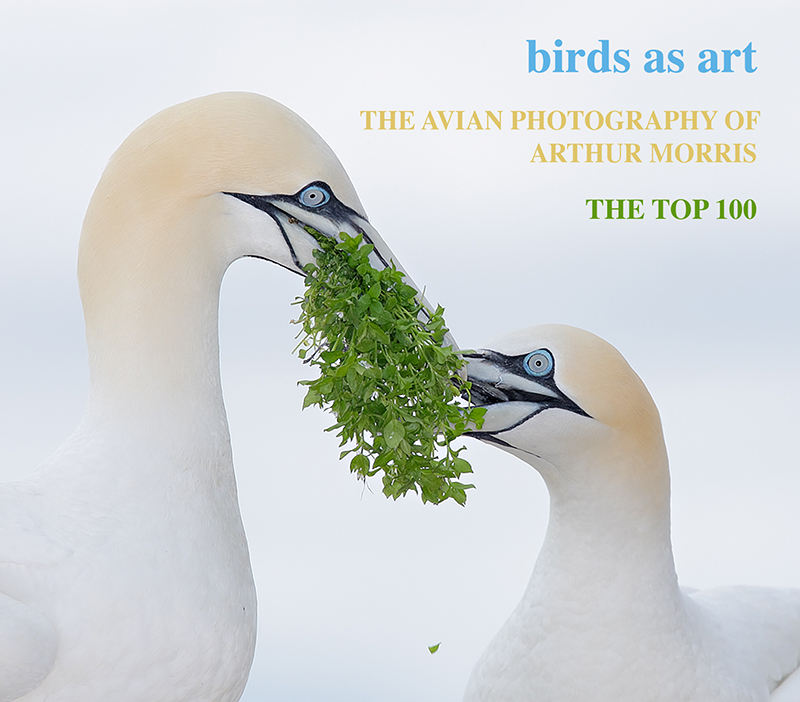
|
birds as art: The Avian Photography of Arthur Morris/The Top 100
The companion e-book to the solo exhibit at TheNat, San Diego, California
birds as art: The Avian Photography of Arthur Morris/The Top 100
|
The e-book on CD is available for $20 on CD here or via download here. Studying great images is the best way to learn to improve your bird photography (he said modestly).
|
|
Least Tern chick with the 800 f/5.6, the 1.4X II TC, and the 1D Mark IV.
A sample page from the Top 100 e-book.
The Canon 800mm f/5.6L IS was one of my very favorite super-telephoto lenses. In the original The Art of Bird Photography I advised that it is generally better to choose a longer faster lens over a shorter, slower one …
|
Canon EF 800mm f/5.6L IS USM Lens
Steve Cashell is offering a Canon EF 800mm f/5.6L IS USM lens in near-mint condition for a very low $8399. The sale includes the rear lens cap, the E-180C front lens cover, the lens trunk with both keys, a Really Right Stuff LCF-51 lens foot, a Camo LensCoat, and insured ground shipping via major courier to US addresses only.
Your item will not ship until your check clears unless other arrangements are made.
Please contact Steve via e-mail or by phone at 1-734-693-4242 (Eastern time).
I owned and used the super-sharp 800mm f/5.6, often with a 1.4X TC, as my go-to super-telephoto lens for almost five years. If you work with birds that are tough to approach and have trouble making sharp images with the 2X III TC, this lens should have your name on it. The 800/5.6 is great from the car or from a blind. I was astounded when I counted to learn that 15 of the 67 images in my San Diego exhibit were created with my 800 … Note that the 800 and a 7D Mark II get you out to 1280mm. Add the 1.4X III TC and you wind up at 1792mm, almost 36X … They 800s sell new right now for $12,999 from B&H. B&H has a used one in similar condition for the insanely high price of $9,499.95. That gives you a choice: save $4,600 off the cost of a new one or $1,100.95 off the price of a used one … artie
|
|
2017 in San Diego was a very good year ….
|
2018 San Diego 3 1/2-DAY BIRDS AS ART IPT #2: Sunday, JAN 28 thru and including a morning session on Wednesday, JAN 31, 2018: 3 1/2 days: $1699.
Limit: 8: Openings: 8
Meet and Greet at 6:30pm on the evening before the IPT begins; Saturday, Jan 27, 2018.
San Diego IPT #2: Shorter and Less Expensive!
Please remember: I go with one.
Click here for details.
The Streak
Today makes seventy-six days in a row with a new educational blog post! This blog post took less than an hour to prepare. With all of my upcoming free time (or not …), the plan right now is to break the current record streak of (I think) four hundred eighty something … Good health and good internet connections willing.
Booking.Com
Booking.Com came through for me twice again recently with both the DeSoto Fall IPT and next July’s UK Puffins, Gannets, and Bempton Pre-trip room reservations. And all the rates were great. If you’d like to give Booking.Com a shot, click here and you will earn a $25 reward. Thanks to the many who have already tried and used this great service.


Gear Questions and Advice
Too many folks attending BAA IPTs and dozens of folks whom I see in the field, and on BPN, are–out of ignorance–using the wrong gear especially when it comes to tripods and more especially, tripod heads… Please know that I am always glad to answer your gear questions via e-mail.
Subject to Sensor-Plane Orientation Considerations
One of the first things that I consider when evaluating a situation is the subject to sensor-plane orientation. Ideal is having the bird perfectly parallel to the back of the camera. On sunny days, the subject to sensor-plane orientation will largely be determined by the wind. If the sun is in the east and the wind is from the north or south the bird will almost always be just right: 90 degrees to the light. Simply get on sun angle and the subject to sensor-plane orientation will be perfect. If the sun is out and behind you and the wind is in your face you will be shooting up the bird’s butt; i.e., not good! On cloudy days it is much easier to get the bird square to the back of your camera simply by changing your position. Understand, however, that on cloudy, somewhat bright days the light will still have direction … When both the light and the wind are behind you the subject will, to varying degrees, be facing you. Best is head-on, dead-on with the subject looking right down the lens barrel. Think getting close and making verticals in those situations. When the bird is angled toward you it is easy to create awkward compositions so be sure to consider the light and your perspective carefully when designing your images.
At times, when the light is relatively soft, a good strategy may be to to work slightly off sun angle — usually no more than 15 degrees for me, so that you can work with the bird perfectly parallel to the back of the camera.
A High Level Question on Choosing Your Perspective Carefully …
For today’s featured image the gull was angled slightly towards me; i.e., the head of the bird is a bit closer to me than the tail. Why didn’t I move a yard to my right to square the bird up perfectly?
If In Doubt …
If in doubt about using the BAA B&H affiliate link correctly, you can always start your search by clicking here. Please note that the tracking is invisible. Web orders only. Please, however, remember to shoot me your receipt via e-mail.




Please Remember to use my Affiliate Links and to Visit the New BAA Online Store 🙂
To show your appreciation for my continuing efforts here, we ask, as always, that you get in the habit of using my B&H affiliate links on the right side of the blog for all of your photo and electronics purchases. Please check the availability of all photographic accessories in the New BIRDS AS ART Online Store, especially the Mongoose M3.6 tripod head, Wimberley lens plates, Delkin flash cards and accessories, and LensCoat stuff.
As always, we sell only what I have used, have tested, and can depend on. We will not sell you junk. We know what you need to make creating great images easy and fun. And please remember that I am always glad to answer your gear questions via e-mail.
I would of course appreciate your using our B&H affiliate links for all of your major gear, video, and electronic purchases. For the photographic stuff mentioned in the paragraph above, and for everything else in the new store, we, meaning BAA, would of course greatly appreciate your business. Here is a huge thank you to the many who have been using our links on a regular basis and those who will be visiting the New BIRDS AS ART Online Store as well.
Amazon.com
Those who prefer to support BAA by shopping with Amazon may use the logo link above.
Amazon Canada
Many kind folks from north of the border, eh, have e-mailed stating that they would love to help us out by using one of our affiliate links but that living in Canada and doing so presents numerous problems. Now, they can help us out by using our Amazon Canada affiliate link by starting their searches by clicking here.
Facebook
Be sure to like and follow BAA on Facebook by clicking on the logo link upper right. Tanks a stack.
Typos
In all blog posts and Bulletins, feel free to e-mail or to leave a comment regarding any typos or errors. Just be right :).
October 10th, 2017 Stuff
Sunday was a lazy day of rest and NFL football on the tube. On Monday it was back to business as usual: work, work, and more work, answering e-mails and doing blog posts. And a swim and lots of exercise.
With only a single slot open on the San Diego IPT I decided to add a second San Diego IPT — shorter and less expensive. The announcement with details follows immediately below.
|
|
2017 in San Diego was a very good year ….
|
2018 San Diego 3 1/2-DAY BIRDS AS ART IPT #2: Sunday, JAN 28 thru and including a morning session on Wednesday, JAN 31, 2018: 3 1/2 days: $1699.
Limit: 8: Openings: 8
Meet and Greet at 6:30pm on the evening before the IPT begins; Saturday, Jan 27, 2018.
San Diego IPT #2: Shorter and Less Expensive!
Please remember: I go with one.
Join me in San Diego near the end of January to photograph the spectacular breeding plumage Brown Pelicans with their fire-engine red and olive green bill pouches; Brandt’s (usually nesting and displaying) and Double-crested Cormorants; breeding plumage Ring-necked Duck; other duck species possible including Lesser Scaup, Redhead, Wood Duck and Surf Scoter; a variety of gulls including Western, California, and the gorgeous Heerman’s, all in full breeding plumage; shorebirds including Marbled Godwit, Whimbrel, Willet, Sanderling and Black-bellied Plover; many others possible including Least, Western, and Spotted Sandpiper, Black and Ruddy Turnstone, Semipalmated Plover, and Surfbird; Harbor Seal (depending on the current regulations) and California Sea Lion; and Bird of Paradise flowers. And as you can see by studying the two IPT cards there are some nice bird-scape and landscape opportunities as well. Please note: formerly dependable, both Wood Duck and Marbled Godwit have been declining at their usual locations for the past two years …
|

|
|
San Diego offers a wealth of very attractive natural history subjects. With annual visits spanning more than three decades I have lot of experience there….
|
With gorgeous subjects just sitting there waiting to have their pictures taken, photographing the pelicans on the cliffs is about as easy as nature photography gets. With the winds from the east almost every morning there is usually some excellent flight photography. And the pelicans are almost always doing something interesting: preening, scratching, bill pouch cleaning, or squabbling. And then there are those crazy head throws that are thought to be a form of intra-flock communication. You can do most of your photography with an 80- or 100-400 lens …
Did I mention that there are wealth of great birds and natural history subjects in San Diego in winter?
|

|
|
Though the pelicans will be the stars of the show on this IPT there will be many other handsome and captivating subjects in wonderful settings.
|
The San Diego Details
This IPT will include four 3 1/2 hour morning photo sessions, three 2 1/2 hour afternoon photo sessions, three lunches, and after-lunch image review and Photoshop sessions. To ensure early starts, breakfasts will be your responsibility. Dinners are on your own so that we can get some sleep.
A $599 non-refundable deposit is required to hold your slot for this IPT. You can send a check (made out to “Arthur Morris) to us at BIRDS AS ART, PO Box 7245, Indian Lake Estates, FL, 33855. Or call Jim or Jennifer at the office with a credit card at 863-692-0906. Your balance, payable only by check, will be due on 11/1/2016. If we do not receive your check for the balance on or before the due date we will try to fill your spot from the waiting list. Please print, complete, and sign the form that is linked to here and shoot it to us along with your deposit check. If you register by phone, please print, complete and sign the form as noted above and either mail it to us or e-mail the scan. If you have any questions, please feel free to contact me via e-mail.
The Streak
Today makes seventy-five days in a row with a new educational blog post! This blog post took less than two hours to prepare. With all of my upcoming free time (or not …), the plan right now is to break the current record streak of (I think) four hundred eighty something … Good health and good internet connections willing.
Booking.Com
Booking.Com came through for me twice again recently with both the DeSoto Fall IPT and next July’s UK Puffins, Gannets, and Bempton Pre-trip room reservations. And all the rates were great. If you’d like to give Booking.Com a shot, click here and you will earn a $25 reward. Thanks to the many who have already tried and used this great service.


Gear Questions and Advice
Too many folks attending BAA IPTs and dozens of folks whom I see in the field, and on BPN, are–out of ignorance–using the wrong gear especially when it comes to tripods and more especially, tripod heads… Please know that I am always glad to answer your gear questions via e-mail.
Still in Love With Pacific-race Brown Pelicans
After viewing and photographing Pacific-race Brown Pelican for more than forty years, I am still mega-excited about my upcoming San Diego visit. Their fire-engine red and olive-green bill pouches set against distant backgrounds of Pacific-blue in early morning light is a dramatic and compelling combination. Throw in the challenge of creating a perfect head-throw image and there is no place I would rather be at the start of a new year.
If you would like to learn to make images like this and have multiple opportunities to do so, scroll up and consider joining me in San Diego this January.
|
|
|
This image was created on the 2017 San Diego IPT about 30 minutes after the image above. Again I used the Induro GIT304L Grand Series 3 Stealth Carbon Fiber Tripod/Mongoose M3.6-mounted Canon EF 500mm f/4L IS II USM lens, the Canon Extender EF 1.4X III, and my favorite pelican photography camera body, the Canon EOS 5D Mark IV. ISO 800. Evaluative metering -1/3 stop: 1/500 sec. at f/13 in Manual mode. Daylight WB.
LensAlign/FocusTune micro-adjustment: -1.
Two rows up and five to the left of the center AF point up/AI Servo/Expand/Shutter Button AF was active at the moment of exposure. The selected AF point was just below the bird’s eye. Click on the image to enjoy a larger version.
Image #2: Pacific race Brown Pelican in stunning breeding plumage/horizontal
|
The Relationship Between Aperture and Background
Which of today’s two featured images has a softer, sweeter background. Why? (Note: I was actually closer to the pelican in Image #2.)
Aperture Question
Why did I stop down all the way to f/13 for Image #2?
Bird Question
Is the bird in Image #1 the same individual as the bird in Image #2? Either way, how do you know for sure?
Your Favorite?
Which of today’s two featured images is do you think is the stronger image? Be sure to let us know why you made your choice. Of the two, I have a very clear favorite.
If In Doubt …
If in doubt about using the BAA B&H affiliate link correctly, you can always start your search by clicking here. Please note that the tracking is invisible. Web orders only. Please, however, remember to shoot me your receipt via e-mail.




Please Remember to use my Affiliate Links and to Visit the New BAA Online Store 🙂
To show your appreciation for my continuing efforts here, we ask, as always, that you get in the habit of using my B&H affiliate links on the right side of the blog for all of your photo and electronics purchases. Please check the availability of all photographic accessories in the New BIRDS AS ART Online Store, especially the Mongoose M3.6 tripod head, Wimberley lens plates, Delkin flash cards and accessories, and LensCoat stuff.
As always, we sell only what I have used, have tested, and can depend on. We will not sell you junk. We know what you need to make creating great images easy and fun. And please remember that I am always glad to answer your gear questions via e-mail.
I would of course appreciate your using our B&H affiliate links for all of your major gear, video, and electronic purchases. For the photographic stuff mentioned in the paragraph above, and for everything else in the new store, we, meaning BAA, would of course greatly appreciate your business. Here is a huge thank you to the many who have been using our links on a regular basis and those who will be visiting the New BIRDS AS ART Online Store as well.
Amazon.com
Those who prefer to support BAA by shopping with Amazon may use the logo link above.
Amazon Canada
Many kind folks from north of the border, eh, have e-mailed stating that they would love to help us out by using one of our affiliate links but that living in Canada and doing so presents numerous problems. Now, they can help us out by using our Amazon Canada affiliate link by starting their searches by clicking here.
Facebook
Be sure to like and follow BAA on Facebook by clicking on the logo link upper right. Tanks a stack.
Typos
In all blog posts and Bulletins, feel free to e-mail or to leave a comment regarding any typos or errors. Just be right :).
October 9th, 2017 Stuff
I am home safely. My flight from Islip to Orlando was the proverbial piece of cake.
Beautiful — the Carole King Musical
Sunday was a day to remember. The show was fabulous. The music, the story, the humor, the staging, all wonderful.
Before She Was Carole King, Superstar-She Was Carol Klein, Teenage Songwriter.
She fought her way into the record business as a teenager and, by the time she reached her twenties, had the husband of her dreams and a flourishing career writing hits for the biggest acts in rock ‘n’ roll. But it wasn’t until her personal life began to crack that she finally managed to find her true voice.
BEAUTIFUL tells the inspiring true story of King’s remarkable rise to stardom, from being part of a hit songwriting team with her husband Gerry Goffin, to her relationship with fellow writers and best friends Cynthia Weil and Barry Mann, to becoming one of the most successful solo acts in popular music history. Along the way, she made more than BEAUTIFUL music, she wrote the soundtrack to a generation.
Click here for the “Beautiful” discography. The number or hits penned by the King/Goffin and Weil/Mann teams truly is astounding. Enjoy a great collection of “Beautiful” sights and sounds here.
Thanks Brendan!
Brendan Quigley has attended several IPTs. I think that his first was a Jamaica Bay Wildlife Refuge IPT. In the days of film. In any case, we have always stayed in touch. Brendan has been the Lighting Director on various iterations of the Broadway show “Wicked” for a long, long time. When I mentioned that we were going to see “Beautiful” he offered to arrange a backstage tour for us after the show. We accepted. As the theater emptied we were met by Josh Weitzman, the House Head Electrician at the Stephen Sondheim Theater. The main thrust of the tour was to see the behind the scenes stuff, the dressing rooms, the wardrobe, the lighting, the props, and the machinery that moves everything into place. We did all that and enjoyed it.
First we ran into Kara Lindsay who plays Carole King’s good friend, songwriter Cynthia Weil. She was in a robe and had her hair up in curlers. I was a bit non-plussed and unsure of which role she had played. As fate would have it, we ran into her again as she was getting ready to leave for home. By this time I had figured out who she was. We chatted for a bit as we all gushed over her performance. I got to give her a hug. She was 100% gracious, sweet, and appreciative. So who shows up in a robe just before we were going to leave? The amazing Chilina Kennedy, the star of the show as Carole King. We were all amazed at how tiny she is. Again we gushed, and again this Broadway star, a singer/songwriter in her own right, was sweet and nice and gracious and and appreciative. And I got to give her a hug as well. While the show had been fantastic, serendipitously meeting the two female leads really put the icing on the cake.
The Streak
Today makes seventy-five days in a row with a new educational blog post! This blog post took about three hours to prepare. With all of my upcoming free time (or not …), the plan right now is to break the current record streak of (I think) four hundred eighty something … Good health and good internet connections willing.
Booking.Com
Booking.Com came through for me once again with both my DeSoto IPT and next July’s UK Puffins, Gannets, and Bempton Pre-trip room reservations. And all the rates were great. If you’d like to give Booking.Com a shot, click here and you will earn a $25 reward. Thanks to the many who have already tried and used this great service.


Gear Questions and Advice
Too many folks attending BAA IPTs and dozens of folks whom I see in the field, and on BPN, are–out of ignorance–using the wrong gear especially when it comes to tripods and more especially, tripod heads… Please know that I am always glad to answer your gear questions via e-mail.
An Elegant End to your BIRDS AS ART Blog-subscription Problems
As some of you know, att and more than a few related e-mail providers (such as sbcglobal and bellsouth) have been black-listing the sending IP address for BirdPhotographer’s.Net for a very long time. Once we moved the blog to the same service provider we inherited the problem. I have tried unsuccessfully for many years to have our IP address de-blacklisted. If you have some pull with att or have a good customer service number and would like to try, that IP address 199.193.247.14.
I forgot who turned me on to this simple and elegant solution but whoever you are, thanks! I have been using it for a month and have been receiving every single BPN Reply to Thread notice and every single BAA Blog Notification in my samandmayasgrandpa@att.net Inbox in a timely fashion from the moment that I tried the work-around. Despite my black-listed att address.
Step I
If you do not have a gmail account, open one. If you do have a gmail account, open it.
Step II
Click on the Settings icon near the top right of the page. Then, in the drop-down menu, click on Settings.
When the Settings page opens, click on Add a forwarding address and then carefully type your black-listed e-mail address into the empty box that pops up. Click Next and then Proceed and then OK. A verification message will be sent to that address. Click the verification link in that message.
Step III
Then Go back to the settings page for the Gmail account you want to forward messages from, and refresh your browser. Select Forward a copy of incoming mail to. Choose what you want to happen with the Gmail copy of your emails. As you can see, I choose delete Gmail’s copy.
You will begin receiving your Arthur Morris/BIRDS AS ART has posted a new item e-mails in the Inbox of the account that you designated. Though the directions might seem a bit complicated they are actually quite simple. If you follow the simple directions the whole process should take a minute or two at most.
|
|
|
This image was created on the 2017 San Diego IPT with the Induro GIT304L Grand Series 3 Stealth Carbon Fiber Tripod/Mongoose M3.6-mounted Canon EF 500mm f/4L IS II USM lens, the Canon Extender EF 1.4X III, and my favorite sitting duck photography camera body, the Canon EOS 5D Mark IV. ISO 800. Evaluative metering -2/3 stop off the water: 1/1600 sec. at f/6.3 in Manual mode. AWB.
LensAlign/FocusTune micro-adjustment: +2.
One AF point up and one to the right of the center AF point/AI Servo/Expand/Shutter Button AF was active at the moment of exposure. As seen in the DPP 4 screen capture below, the selected AF point was on the space below the base of the bill and just caught the spot where the base of the neck meets the top of the breast. Click on the image to enjoy a larger version.
Ring-necked Duck drake floating
|
Ring-necked Duck Drake Exposure Quiz Answer
In the Sitting Ducks blog post here, I wrote, If you were behind the camera at the moment of exposure and were working in Av mode what EC (exposure compensation) would have dialed in? Why?
Many folks responded. Some of the answers were great. Some not so great. Here is what I did. Working in Manual mode I set an exposure that was 1/3 stop darker than the water: 1/1250 sec. at f/6.3. Why? I was was worried about burning the bright WHITEs on the forward flank just behind the breast. I made a test exposure and saw more than a few blinkies on the WHITEs so I went one click faster on the shutter speed to 1/1600 sec. This would likely have worked out to -1/3 or -2/3 stop as framed.
Multiple IPT veteran Kent Downing gave the best answer when he posted (in part):
The overall scene lends itself towards a slightly darker than average mid-tone. It is a difficult image to correctly expose given the high contrast between the whites and blacks. Therefore, I would first start with a slightly negative EC and then check the histogram and the (highlight) blinkies and adjust exposure accordingly. This is a wonderful image. I love the position of the bird, the lighting, and the detail in the blacks and the whites. Well done.
He went on to suggest as I often do that folks who really want to understand exposure should get themselves a copy of his “go-to reference book,” http://birdsasart-shop.com/the-art-of-bird-photography-soft-cover/, and study the section on Exposure Theory.
IPT veteran Krishna Prasad Kotti gave the perfect answer for Nikon-users: Hi Artie, I think I will go with -1 EV.
On Sunday afternoon I responded to all the comments in the original blog post. You might wish to review those by scrolling down here to maximize your understanding.
If In Doubt …
If in doubt about using the BAA B&H affiliate link correctly, you can always start your search by clicking here. Please note that the tracking is invisible. Web orders only. Please, however, remember to shoot me your receipt via e-mail.




Please Remember to use my Affiliate Links and to Visit the New BAA Online Store 🙂
To show your appreciation for my continuing efforts here, we ask, as always, that you get in the habit of using my B&H affiliate links on the right side of the blog for all of your photo and electronics purchases. Please check the availability of all photographic accessories in the New BIRDS AS ART Online Store, especially the Mongoose M3.6 tripod head, Wimberley lens plates, Delkin flash cards and accessories, and LensCoat stuff.
As always, we sell only what I have used, have tested, and can depend on. We will not sell you junk. We know what you need to make creating great images easy and fun. And please remember that I am always glad to answer your gear questions via e-mail.
I would of course appreciate your using our B&H affiliate links for all of your major gear, video, and electronic purchases. For the photographic stuff mentioned in the paragraph above, and for everything else in the new store, we, meaning BAA, would of course greatly appreciate your business. Here is a huge thank you to the many who have been using our links on a regular basis and those who will be visiting the New BIRDS AS ART Online Store as well.
Amazon.com
Those who prefer to support BAA by shopping with Amazon may use the logo link above.
Amazon Canada
Many kind folks from north of the border, eh, have e-mailed stating that they would love to help us out by using one of our affiliate links but that living in Canada and doing so presents numerous problems. Now, they can help us out by using our Amazon Canada affiliate link by starting their searches by clicking here.
Facebook
Be sure to like and follow BAA on Facebook by clicking on the logo link upper right. Tanks a stack.
Typos
In all blog posts and Bulletins, feel free to e-mail or to leave a comment regarding any typos or errors. Just be right :).
October 8th, 2017 Stuff
I finished and scheduled this blog post on Saturday morning. Younger daughter Alissa, her husband Ajiniyas, and I left at 10:30 for the drive into Manhattan to see Beautiful, the Carole King musical on Broadway. Fourth row center 🙂
I take the 6:20am non-stop from Islip to Orlando on Sunday morning.
The Streak
Today makes seventy-four days in a row with a new educational blog post! This blog post took less than two hours to prepare (including the short time spent on the image optimization). With all of my upcoming free time (or not …), the plan right now is to break the current record streak of (I think) four hundred eighty something … Good health and good internet connections willing.
Booking.Com
Booking.Com came through for me once again with both my DeSoto IPT and next July’s UK Puffins, Gannets, and Bempton Pre-trip room reservations. And all the rates were great. If you’d like to give Booking.Com a shot, click here and you will earn a $25 reward. Thanks to the many who have already tried and used this great service.


Gear Questions and Advice
Too many folks attending BAA IPTs and dozens of folks whom I see in the field, and on BPN, are–out of ignorance–using the wrong gear especially when it comes to tripods and more especially, tripod heads… Please know that I am always glad to answer your gear questions via e-mail.
|
|
|
This image was created on the 2017 Fort DeSoto Fall IPT with the Induro GIT304L Grand Series 3 Stealth Carbon Fiber Tripod/Mongoose M3.6-mounted Canon EF 600mm f/4L IS II USM lens, the Canon Extender EF 1.4X III, and my favorite flight photography camera, the Canon EOS 5D Mark IV. ISO 800. Evaluative metering +2 1/3 stops off the sky: 1/800 sec. at f/6.3 in Manual mode. AWB.
Center AF point/AI Servo/Expand Shutter Button AF as originally framed (see below) was active at the moment of exposure. The selected AF point was just above but missed the center of the bird’s left wing. The lower assist point was surely active and likely responsible at least in part for the subject being in sharp focus. Take it where and when you can get it 🙂 Click on the image to enjoy a larger version.
FocusTune/LensAlign Micro Adjustment: -2.
Brown Pelican immature hitting the water
|
Hitting the Water!
It is a big challenge to photograph diving birds as they hit the water as the tendency is to keep following the the trajectory of their flight paths. The best advice I can give is to take lots of photographs and try to time the shutter release to coincide with the instant just before they hit the water.
Good Timin”
Working on this blog post brought back junior high school memories of Jimmy Jones’ hit “Good Timin.” He had one other bigger hit, “Handy Man.”
Getting Close Physically
Many bird photographers do not realize that the advantages of getting close physically are huge. You can gain a stop of ISO or shutter speed if you are able to avoid adding the 1.4X TC, and two stops if you are able to avoid adding a 2X TC. When working with small birds at relatively close range even a single step closer can result in increasing the size of the subject in the frame by 5 or 10% or more. If you are on a boardwalk and need to get a bit closer you can put two legs of the tripod against the edge of the boardwalk or the fence rather than have one leg pointing forward as we usually do; that gets you about a foot closer. A more drastic measure would be to shorten one or even two legs and place them on top of the fence. At times I have placed the tripod itself on the top of the fence with two legs still on the boardwalk.
At DeSoto a group of young pelicans were diving consistently well offshore. Going to the 2X TC would have been a bad idea so I went into the water instead and stuck with the 1.4X TC. Thanks to Muhammed who created this image of me upon request with the 100 macro that I had loaned him 🙂
Current Question
Looking closely at the image above, can you tell that the current was strong? If yes, how?
Via e-mail from Muhammed Arif
Hi, Artie. I had a great time at Fort De Soto. Thank you for all the instruction, help and pointers – my photography has already improved tremendously and I’ve never taken such good bird photos before. I wish I could’ve joined you on Monday and Tuesday morning as well but work got in the way. It was also nice to meet everyone at the IPT; sorry, I missed you Ray.
|
|
The DPP 4 screen capture for today’s featured image.
|
The Color Balance
With today’s image I first tried Click White Balance in DPP 4 but the results were too warm so decided to see if I could come up with a perfectly neutral sky by first adjusting the Color Temperature and then working with the Color fine tune dot. The RGB values of 234, 234, 234 and the histogram with all three color channels lined up quite nicely indicate that I succeeded.
After leveling the image using the Ruler Tool and my personal Image > Rotate > Arbitrary shortcut (Command + /) the rest of the optimization (after
a small crop) was straightforward: I selected the bird and a bit of the splash with the Quick Selection Tool (my shortcut W) and applied my NIK 40-40 recipe. I added a Regular Layer Mask and used a 50% opacity brush to fine tune the 40-40 recipe in the darker areas. Last I increased the Contrast using the RGB Curves Color Balance technique; even though the color was already perfect this gave the image some additional pop.
|
|
|
The BIRDS AS ART Current Workflow e-Guide (Digital Basics II) will teach you an efficient Mac/Photo Mechanic/Photoshop workflow that will make it easy for you to make your images better in Photoshop (rather than worse). That true whether you convert your images in DPP 4 or ACR. See the blog post here to learn lots more and to read a free excerpt.
You can order your copy from the BAA Online Store here, by sending a Paypal for $40 here, or by calling Jim or Jennifer weekdays at 863-692-0906 with your credit card in hand.
|
The BIRDS AS ART Current Workflow e-Guide (Digital Basics II)
Everything mentioned above is covered in detail in the BIRDS AS ART Current Workflow e-Guide (Digital Basics II), an instructional PDF that is sent via e-mail. Learn more and check out the free excerpt in the blog post here. The new e-Guide reflects my Macbook Pro/Photo Mechanic/DPP 4/Photoshop workflow. Do note that you will find the RGB Curves Adjustment Color Balancing tutorial only in the new e-guide. Note: folks working on a PC and/or those who do not want to miss anything Photoshop may wish to purchase the original Digital Basics along with DB II while saving $15 by clicking here to buy the DB Bundle.
The two most recent and many of the older MP4 Photoshop Tutorial videos releases go hand and hand with the information in DB II):
- The Wingtip Repairs MP4 Video here.
- The MP4 Crow Cleanup Video here.
Folks who learn well by following along rather than by reading can check out the complete collection of MP 4 Photoshop Tutorial Videos by clicking here.
You can learn how and why I and other discerning Canon shooters convert nearly all of their Canon digital RAW files in DPP 4 using Canon Digital Photo Professional in the DPP 4 RAW conversion Guide here. And you can learn advanced Quick Masking and advanced Layer Masking techniques in APTATS I & II. You can save $15 by purchasing the pair. Folks can learn sophisticated sharpening and (NeatImage) Noise Reduction techniques in the The Professional Post Processing Guide by Arash Hazeghi and yours truly.
If In Doubt …
If in doubt about using the BAA B&H affiliate link correctly, you can always start your search by clicking here. Please note that the tracking is invisible. Web orders only. Please, however, remember to shoot me your receipt via e-mail.




Please Remember to use my Affiliate Links and to Visit the New BAA Online Store 🙂
To show your appreciation for my continuing efforts here, we ask, as always, that you get in the habit of using my B&H affiliate links on the right side of the blog for all of your photo and electronics purchases. Please check the availability of all photographic accessories in the New BIRDS AS ART Online Store, especially the Mongoose M3.6 tripod head, Wimberley lens plates, Delkin flash cards and accessories, and LensCoat stuff.
As always, we sell only what I have used, have tested, and can depend on. We will not sell you junk. We know what you need to make creating great images easy and fun. And please remember that I am always glad to answer your gear questions via e-mail.
I would of course appreciate your using our B&H affiliate links for all of your major gear, video, and electronic purchases. For the photographic stuff mentioned in the paragraph above, and for everything else in the new store, we, meaning BAA, would of course greatly appreciate your business. Here is a huge thank you to the many who have been using our links on a regular basis and those who will be visiting the New BIRDS AS ART Online Store as well.
Amazon.com
Those who prefer to support BAA by shopping with Amazon may use the logo link above.
Amazon Canada
Many kind folks from north of the border, eh, have e-mailed stating that they would love to help us out by using one of our affiliate links but that living in Canada and doing so presents numerous problems. Now, they can help us out by using our Amazon Canada affiliate link by starting their searches by clicking here.
Facebook
Be sure to like and follow BAA on Facebook by clicking on the logo link upper right. Tanks a stack.
Typos
In all blog posts and Bulletins, feel free to e-mail or to leave a comment regarding any typos or errors. Just be right :).
October 7th, 2017 Stuff
On Friday I visited younger sister Arna again, this time with my younger daughter Alissa. Lissy and I ran some errands; I picked up some protein bars for lunch. As is usual I do not eat too well when I am traveling … I had a great dinner with Lissy, her two autistic boys — Ilyas and Idris, and Erin, one of Ilyas’ many support aides. Carver’s, where we ate, is right around the corner from where my Mom lived for more than ten years. I had never been there. The food was basic but great. Tomorrow Alissa, husband Ajiniyas, and I will be seeing Beautiful, the Carole King musical on Broadway. Fourth row center 🙂
I was pleased to learn that IPT veteran Andrae Acerra sold her barely used Canon EOS 7D Mark II in near mint condition for $924 within two hours of it being listed.
The Streak
Today makes seventy-three days in a row with a new educational blog post! This blog post took less than two hours to prepare (including the short time spent on the image optimization). With all of my upcoming free time (or not …), the plan right now is to break the current record streak of (I think) four hundred eighty something … Good health and good internet connections willing.
Booking.Com
Booking.Com came through for me once again with both my DeSoto IPT and next July’s UK Puffins, Gannets, and Bempton Pre-trip room reservations. And all the rates were great. If you’d like to give Booking.Com a shot, click here and you will earn a $25 reward. Thanks to the many who have already tried and used this great service.


Gear Questions and Advice
Too many folks attending BAA IPTs and dozens of folks whom I see in the field, and on BPN, are–out of ignorance–using the wrong gear especially when it comes to tripods and more especially, tripod heads… Please know that I am always glad to answer your gear questions via e-mail.
Celebrating 40 Years in the Mud: Part II
On the morning of Wednesday October 6, Isaac Hayes and I ventured out into the mud on the East Pond. Forty years and a bit ago in August of 1977 I first set foot onto those same South Flats. Though it was prime time for migrant shorebirds, the tide in the surrounding bay was low and there was only a single bird. The young Marbled Godwit had a long upturned bill with a dark tip and an alabaster pink base. Not far behind me, hundreds of vehicles an hour drove north and south on Cross Bay Boulevard. Just beyond the eastern shore of the pond the “A” and “C” trains, part of the New York City subway system, transported hundreds of thousands of New Yorkers each month from their homes in the Rockaways to their jobs in Manhattan and elsewhere. Overhead, huge jetliners landed and took off every few minutes bringing millions of visitors and tons of cargo to the Big Apple from around the world. I remember thinking, none of these folks even know that this beautiful bird is here. At the time, I had no idea that seeing this single bird would change the remainder of the rest of my adult life. But it did just that. And all for the good.
My Target Species …
Understanding the timing of migration for the various shorebird species I had hoped to photograph the handsome juveniles of the following species: White-rumped Sandpiper, Long-billed Dowitcher, Pectoral Sandpiper, and Dunlin. Juvenile Hudsonian Godwit was a wild-assed dream. I knocked off juvie white-rumpeds and the young, molting Dunlin on Tuesday afternoon at the north end. On Tuesday morning we spotted a gorgeous juvenile pectoral that was at first elusive. We carefully approached a small group of shorebirds that included a first-winter Lesser Yellowlegs, two young Semipalmated Plovers, two young Semipalmated Sandpipers, and the highly desired Pectoral Sandpiper. Isaac got in position first and I approached in a crouch. I was sure that we had it made in the shade but as my left knee touched down I spooked the birds. I sat in the mud, apologized to Isaac, and then we both stood stock still. The birds circled the south end of the pond before flying back to us and landing, landing just on the other side of a stand of phragmites in the pond.
“With luck,” I whispered, “they should wind up right in front of us in a few minutes.” And that they did. I photographed while seated for a while, but my hip pain had me lying face down in the mud in short order. The light was still lovely and the backgrounds sweet and distant. We had a good solid hour with the pectoral and the yellowlegs before they were spooked by a Merlin and departed the pond. All in all we were blessed for the second straight session. Though we never did see a long-billed dow I was thrilled both with the experience and with the images I made on my old stomping grounds.
|
|
The DPP 4 Screen Capture for today’s featured image
|
Getting Lucky with Center Large Zone AF …
Both the pectoral and the yellowlegs kept coming closer and closer so I switched my 2X III TC for the 1.4X III TC. Tired of having to move the selected AF Expand point around constantly I went to Large Zone AF. With this image, switching to Right Large Zone AF would have been ideal as I could likely have had the activated AF points on the bird’s face or neck.
Even with this error the bird’s eyelashes are razor sharp. (No, sandpipers do not have eyelashes but that is what the tiny marks on the eye skin look like; and they are a great test of image sharpness. I love that I can easily zoom in when editing my images in Photo Mechanic.)
The question is, “Why are the eyes razor sharp if I screwed up by using the wrong AF Area Selection mode?”
Multiple choice:
a-I had lots of extra depth of field.
b-the bird was relatively far away.
c-the bird was momentarily standing very still.
d-the bird’s body was angled toward me.
e-all of the above are correct.
Before and After Image Clean-up
Lying flat down on the the mud is step one when you are looking to eliminate a majority of potential distractions and enjoy a soft, distant background. But there will almost always be some stuff in the mud that will wind up as distractions. With this image the main culprits were stray feathers, small sticks and stems, and bird droppings (whitewash). I used my usual cadre of clean-up tools: the Spot Healing Brush (J), the Patch Tool (my keyboard shortcut P), and Content Aware Fill (Shift + Delete). Notice that unlike most folks I do not depend on the Clone Stamp Tool for my clean-up work and with today’s image, I did not use it at all.
Then I used my foreground Gaussian Blur technique. I put the whole image on its own layer, applied a 75-pixel Gaussian Blur, and then added an Inverse (Black or Hide-all) mask. Then, using a soft, 100% opacity brush, I painted the blur in only onto the out-of-focus portions of the foreground. I carefully avoided painting the blur onto the narrow strip on the same plane as the bird’s eye <em>that was in sharp focus. In spots where the blur was a bit overdone I hit X and reduced the opacity of the brush to 50% and then painted back in 50% of the original until I was happy with the look.
Note: the posterization that you see in the two images above is a result of the creation of the animated GIF.
|
|
|
The BIRDS AS ART Current Workflow e-Guide (Digital Basics II) will teach you an efficient Mac/Photo Mechanic/Photoshop workflow that will make it easy for you to make your images better in Photoshop (rather than worse). That true whether you convert your images in DPP 4 or ACR. See the blog post here to learn lots more and to read a free excerpt.
You can order your copy from the BAA Online Store here, by sending a Paypal for $40 here, or by calling Jim or Jennifer weekdays at 863-692-0906 with your credit card in hand.
|
The BIRDS AS ART Current Workflow e-Guide (Digital Basics II)
Everything mentioned above is covered in detail in the BIRDS AS ART Current Workflow e-Guide (Digital Basics II), an instructional PDF that is sent via e-mail. Learn more and check out the free excerpt in the blog post here. The new e-Guide reflects my Macbook Pro/Photo Mechanic/DPP 4/Photoshop workflow. Do note that you will find the RGB Curves Adjustment Color Balancing tutorial only in the new e-guide. Note: folks working on a PC and/or those who do not want to miss anything Photoshop may wish to purchase the original Digital Basics along with DB II while saving $15 by clicking here to buy the DB Bundle.
The two most recent and many of the older MP4 Photoshop Tutorial videos releases go hand and hand with the information in DB II):
- The Wingtip Repairs MP4 Video here.
- The MP4 Crow Cleanup Video here.
Folks who learn well by following along rather than by reading can check out the complete collection of MP 4 Photoshop Tutorial Videos by clicking here.
You can learn how and why I and other discerning Canon shooters convert nearly all of their Canon digital RAW files in DPP 4 using Canon Digital Photo Professional in the DPP 4 RAW conversion Guide here. And you can learn advanced Quick Masking and advanced Layer Masking techniques in APTATS I & II. You can save $15 by purchasing the pair. Folks can learn sophisticated sharpening and (NeatImage) Noise Reduction techniques in the The Professional Post Processing Guide by Arash Hazeghi and yours truly.
If In Doubt …
If in doubt about using the BAA B&H affiliate link correctly, you can always start your search by clicking here. Please note that the tracking is invisible. Web orders only. Please, however, remember to shoot me your receipt via e-mail.




Please Remember to use my Affiliate Links and to Visit the New BAA Online Store 🙂
To show your appreciation for my continuing efforts here, we ask, as always, that you get in the habit of using my B&H affiliate links on the right side of the blog for all of your photo and electronics purchases. Please check the availability of all photographic accessories in the New BIRDS AS ART Online Store, especially the Mongoose M3.6 tripod head, Wimberley lens plates, Delkin flash cards and accessories, and LensCoat stuff.
As always, we sell only what I have used, have tested, and can depend on. We will not sell you junk. We know what you need to make creating great images easy and fun. And please remember that I am always glad to answer your gear questions via e-mail.
I would of course appreciate your using our B&H affiliate links for all of your major gear, video, and electronic purchases. For the photographic stuff mentioned in the paragraph above, and for everything else in the new store, we, meaning BAA, would of course greatly appreciate your business. Here is a huge thank you to the many who have been using our links on a regular basis and those who will be visiting the New BIRDS AS ART Online Store as well.
Amazon.com
Those who prefer to support BAA by shopping with Amazon may use the logo link above.
Amazon Canada
Many kind folks from north of the border, eh, have e-mailed stating that they would love to help us out by using one of our affiliate links but that living in Canada and doing so presents numerous problems. Now, they can help us out by using our Amazon Canada affiliate link by starting their searches by clicking here.
Facebook
Be sure to like and follow BAA on Facebook by clicking on the logo link upper right. Tanks a stack.
Typos
In all blog posts and Bulletins, feel free to e-mail or to leave a comment regarding any typos or errors. Just be right :).
October 6th, 2017 Stuff
Thursday was a day of rest, hanging around, and watching Law and Order reruns and the MLB playoffs on the tube. I did get lots of work done and scheduled a few more appointments in Florida for after I get home.
The Streak
Today makes seventy-two days in a row with a new educational blog post! This blog post took less than two hours to prepare (including the short time spent on the image optimization). With all of my upcoming free time (or not …), the plan right now is to break the current record streak of (I think) four hundred eighty something … Good health and good internet connections willing.
Booking.Com
Booking.Com came through for me once again with both my DeSoto IPT and next July’s UK Puffins, Gannets, and Bempton Pre-trip room reservations. And all the rates were great. If you’d like to give Booking.Com a shot, click here and you will earn a $25 reward. Thanks to the many who have already tried and used this great service.


Gear Questions and Advice
Too many folks attending BAA IPTs and dozens of folks whom I see in the field, and on BPN, are–out of ignorance–using the wrong gear especially when it comes to tripods and more especially, tripod heads… Please know that I am always glad to answer your gear questions via e-mail.
New Listing
Sale Pending 9am on the day posted!
Andrae Acerra is offering a barely used Canon EOS 7D Mark II in near mint condition for $924. The sale includes the front lens cap, the strap, two Canon batteries, the battery charger, the original box and everything that came in it, and and insured ground shipping via major courier to US addresses only.
Your item will not ship until your check clears unless other arrangements are made.
Please contact Andrae via e-mail or by phone at 1-908 832 9480 (Eastern time).
Both Patrick Sparkman and I used and loved the 7D Mark II until about two years ago when we both committed to using full frame Canon bodies. We both made some truly great images with it. Two of my three 2016 Nature’s Best honored entries were created with the 7D II, one still, and one video. artie
|
|
|
This image was created on the 2017 Galapagos Photo-Cruise of a Lifetime IPT at 7:03am from the zodiac with the hand held Canon EF 400mm f/4 DO IS II USM lens and my favorite diving booby photography camera body, the Canon EOS 5D Mark IV. ISO 2500. Evaluative metering +2 1/3 stops off the gray sky: 1/3200 sec. at f/4.5 in Manual mode. AWB.
Center AF point/AI Servo/Expand/Shutter Button AF was active at the moment of exposure. As seen in the DPP 4 screen capture below, the selected AF point and all four of the assist points missed the subject completely, yet the image is sharp on the bird’s eye. Be sure to click on the image to enjoy a larger version.
LensAlign/FocusTune micro-adjustment: -5.
Blue-footed Booby diving #3
Be sure to click on the image to see a larger, sharper version.
|
Blue-Footed Booby Diving Part III
AI Servo autofocus always has a tougher time tracking a moving subject against a background other than sky than it does when tracking a subject against a sky background. My advise when photographing birds in flight against a background other than sky has always been to concentrate hard and do your best to keep the selected AF point somewhere on the subject, preferably on its face, neck, or upper breast. As I was unable to do any of those things I’d have to assume that I had been tracking the subject well and that my custom case setting worked: my setting are designed so that the AF system will delay searching for for the background when the selected AF point falls off the subject onto the background. My personalized Custom Case settings are detailed in all of my recent Camera User’s Guides. I will be getting back to work on my 5D Mark IV User’s Guide as soon as I get home next Monday; I will be sharing some mew thoughts on those settings for the first time in the new guide.
|
|
The DPP 4 Screen Capture for today’s featured image
|
Canon 5D Mark IV Image Quality and Crop-ability
The excellent image quality of sharp 5D Mark IV images is due completely to to its 30.4MP full-frame CMOS sensor that balances fine detail and resolution with low-light performance and sensitivity; I rely on my three 5D IV bodies to produce sharp, low-noise images in a variety of conditions, images that can stand up to a healthy crop as with today’s featured image.
The Crop
The unusually (for me) large crop was dictated by the placement of the subject in the frame of the RAW file. With the crop, I was able to eliminate the extraneous boobies, and in addition, place extra emphasis on the droplets from the boobies that had hit the water just below today’s diving booby. All while being confident in being able to maintain image quality in the optimized image.
If In Doubt …
If in doubt about using the BAA B&H affiliate link correctly, you can always start your search by clicking here. Please note that the tracking is invisible. Web orders only. Please, however, remember to shoot me your receipt via e-mail.




Please Remember to use my Affiliate Links and to Visit the New BAA Online Store 🙂
To show your appreciation for my continuing efforts here, we ask, as always, that you get in the habit of using my B&H affiliate links on the right side of the blog for all of your photo and electronics purchases. Please check the availability of all photographic accessories in the New BIRDS AS ART Online Store, especially the Mongoose M3.6 tripod head, Wimberley lens plates, Delkin flash cards and accessories, and LensCoat stuff.
As always, we sell only what I have used, have tested, and can depend on. We will not sell you junk. We know what you need to make creating great images easy and fun. And please remember that I am always glad to answer your gear questions via e-mail.
I would of course appreciate your using our B&H affiliate links for all of your major gear, video, and electronic purchases. For the photographic stuff mentioned in the paragraph above, and for everything else in the new store, we, meaning BAA, would of course greatly appreciate your business. Here is a huge thank you to the many who have been using our links on a regular basis and those who will be visiting the New BIRDS AS ART Online Store as well.
Amazon.com
Those who prefer to support BAA by shopping with Amazon may use the logo link above.
Amazon Canada
Many kind folks from north of the border, eh, have e-mailed stating that they would love to help us out by using one of our affiliate links but that living in Canada and doing so presents numerous problems. Now, they can help us out by using our Amazon Canada affiliate link by starting their searches by clicking here.
Facebook
Be sure to like and follow BAA on Facebook by clicking on the logo link upper right. Tanks a stack.
Typos
In all blog posts and Bulletins, feel free to e-mail or to leave a comment regarding any typos or errors. Just be right :).
|
|







